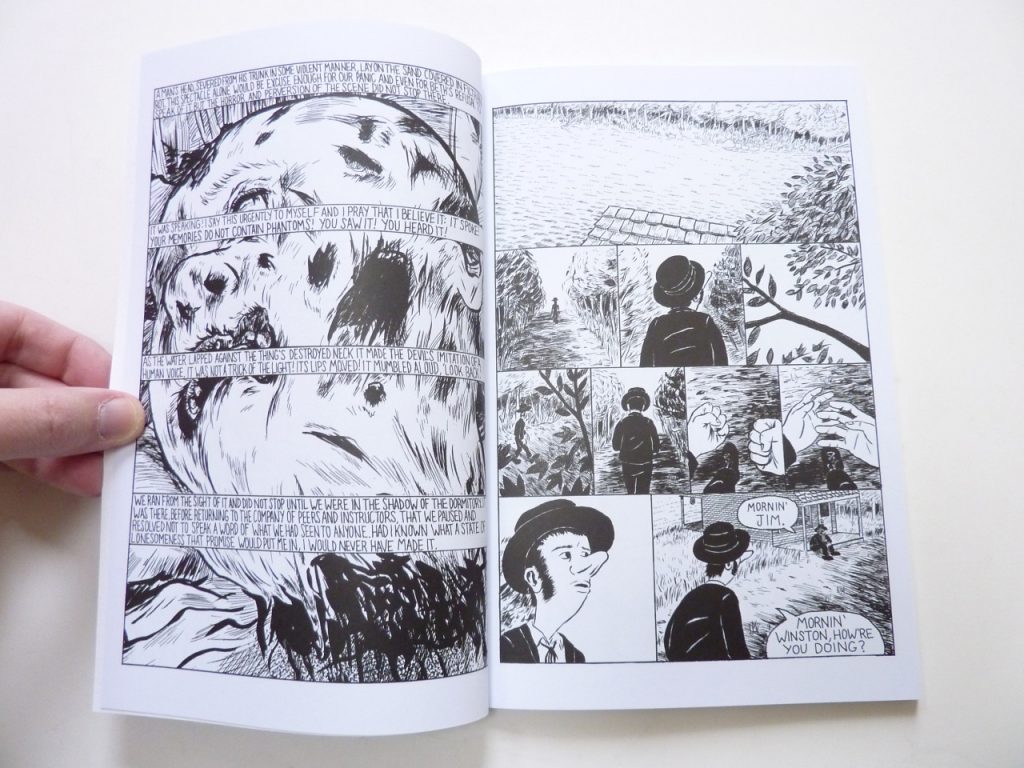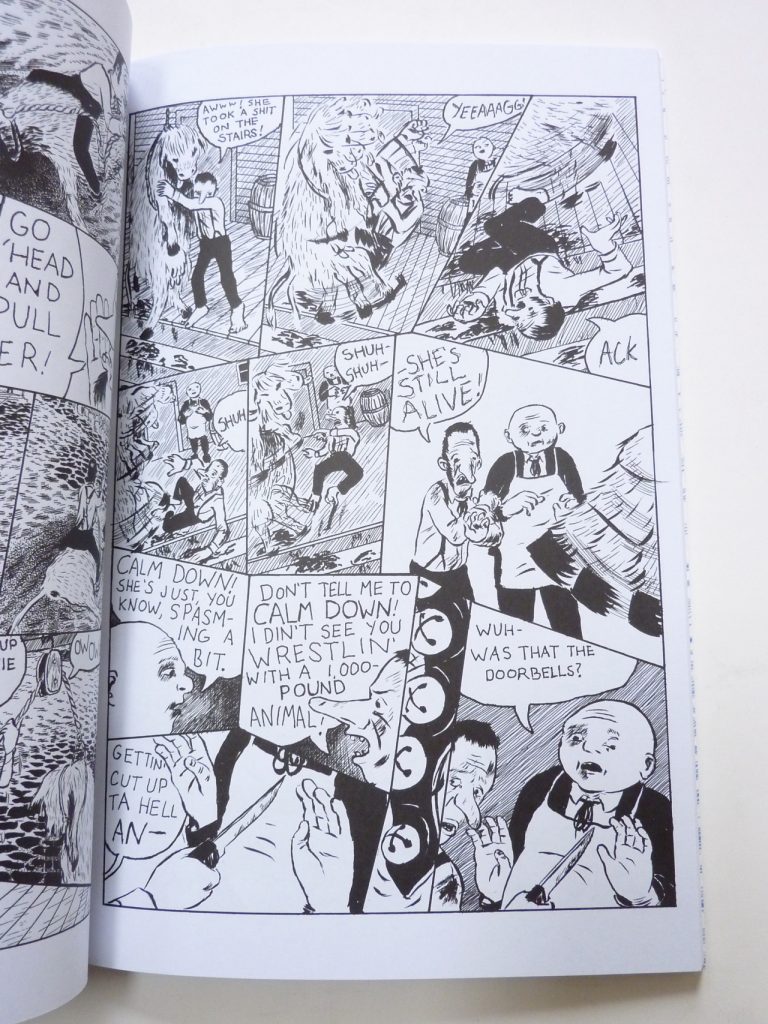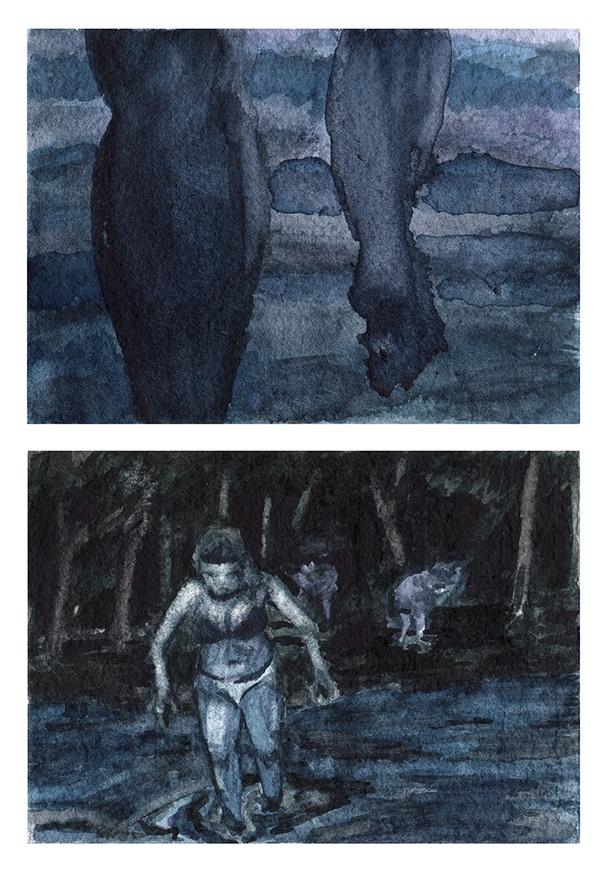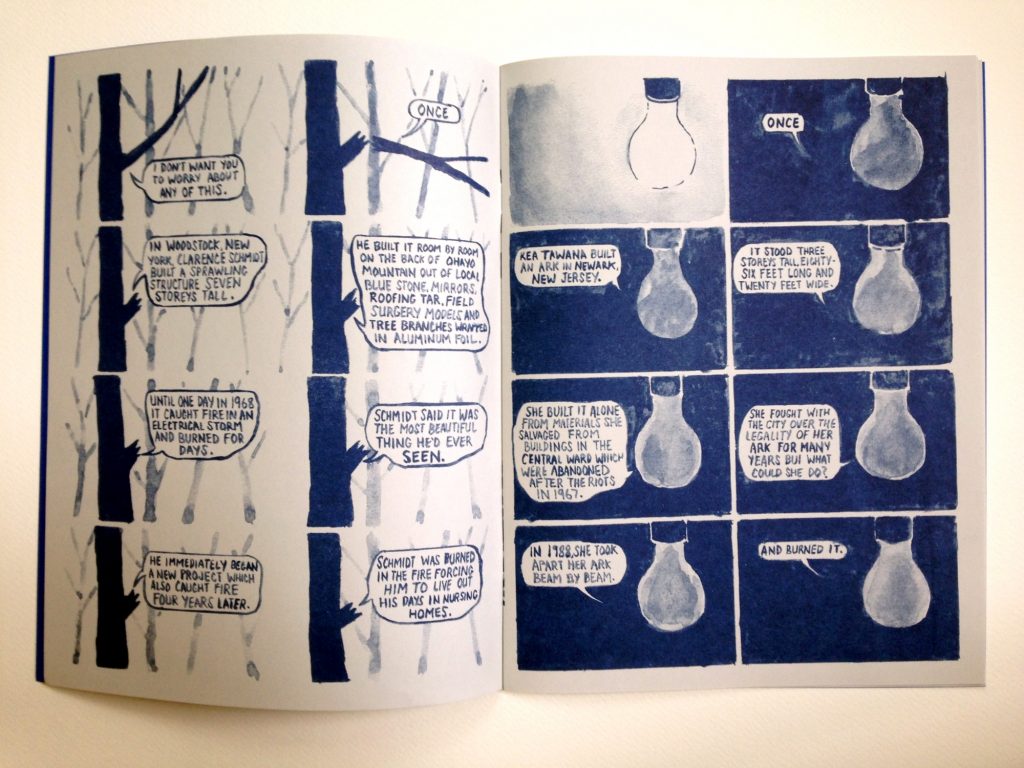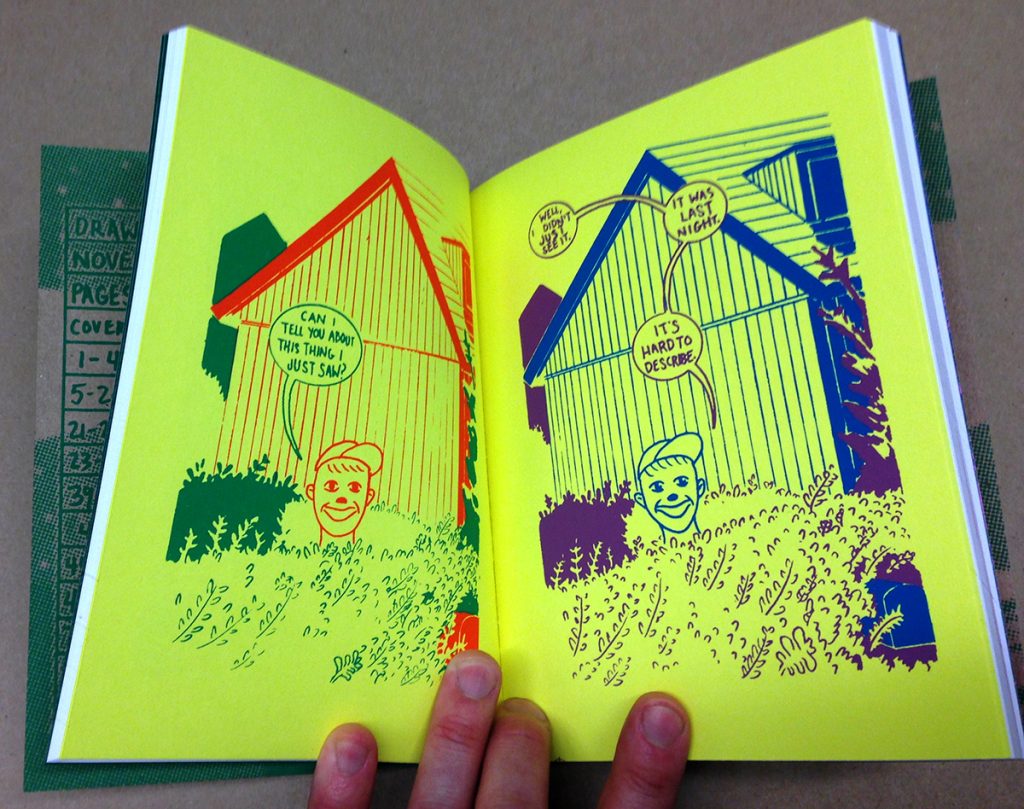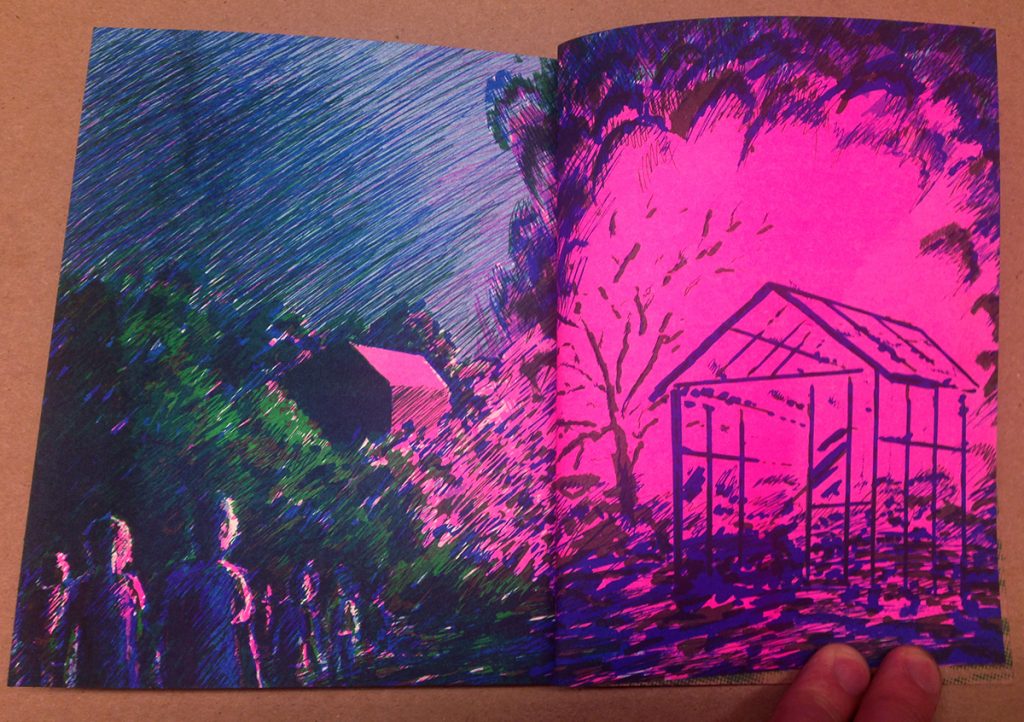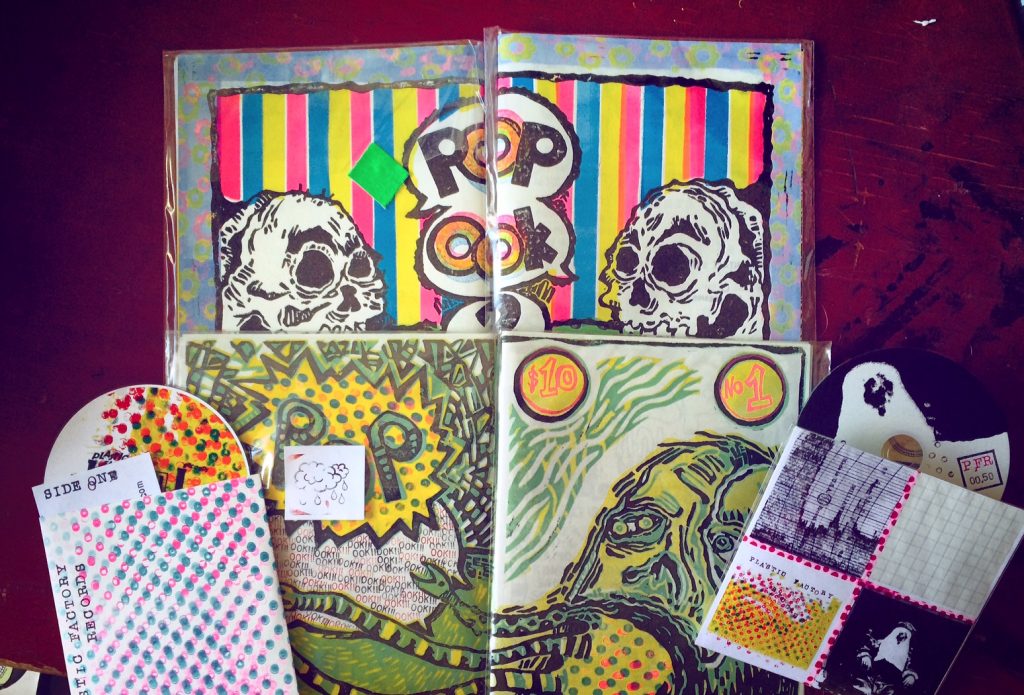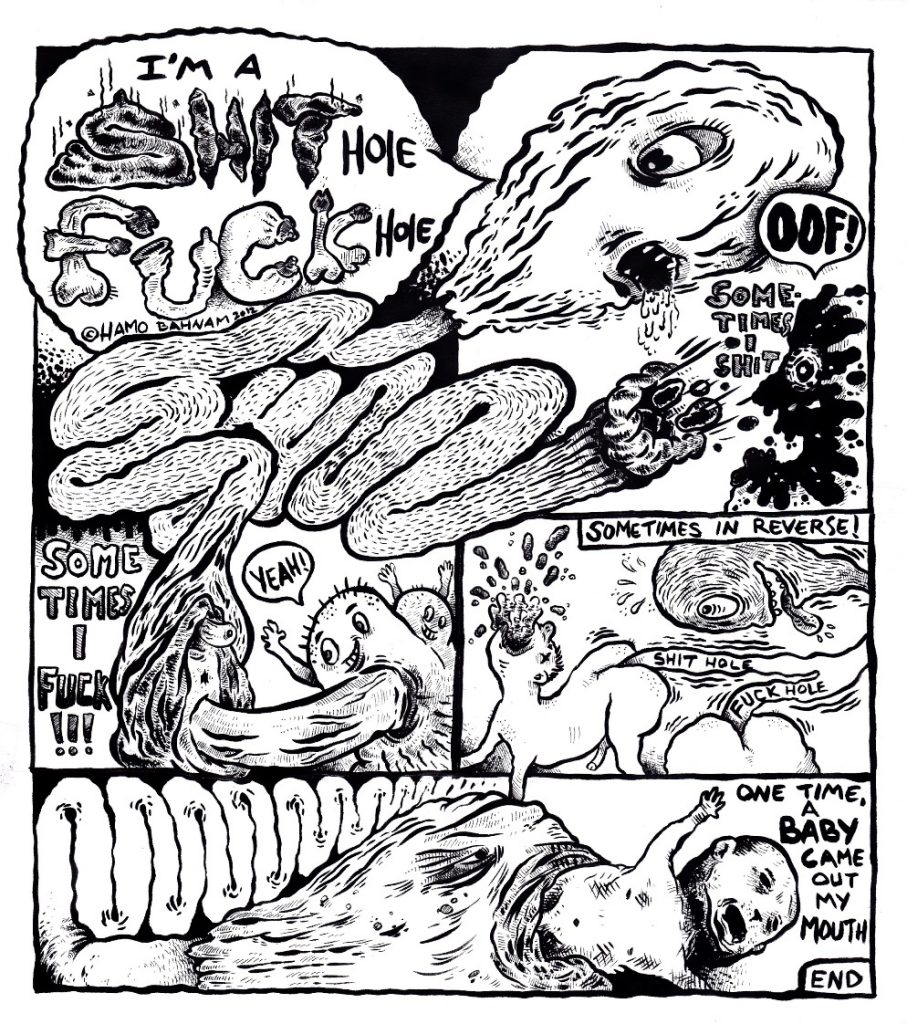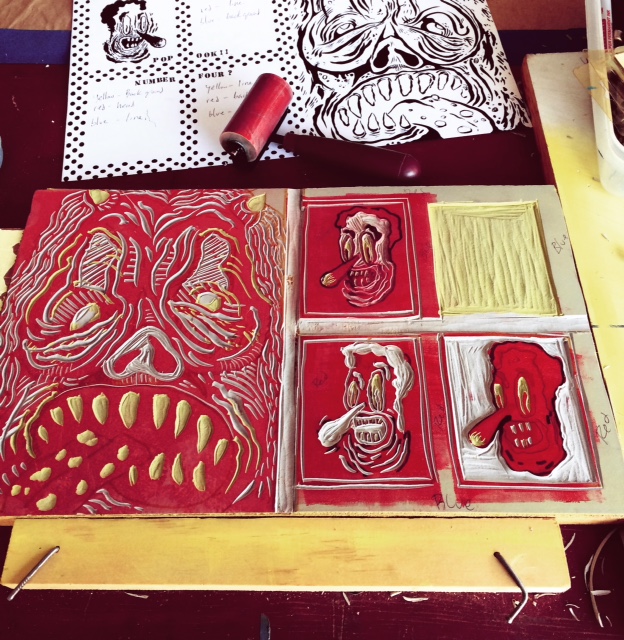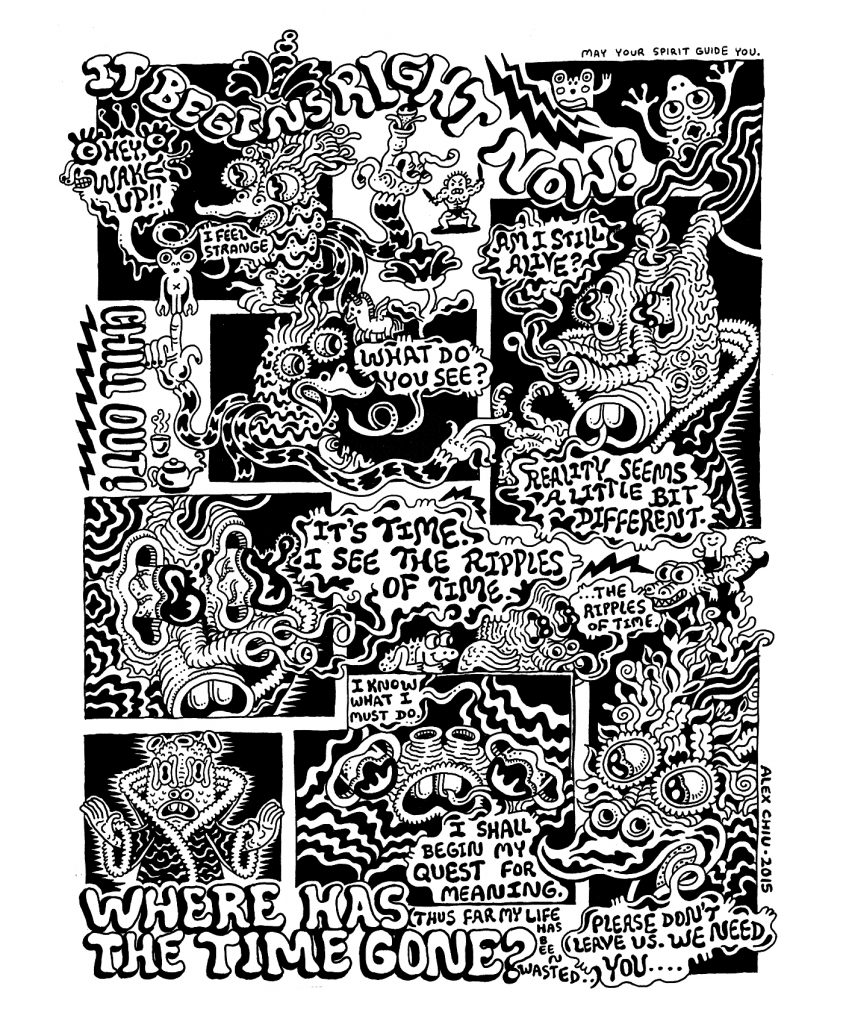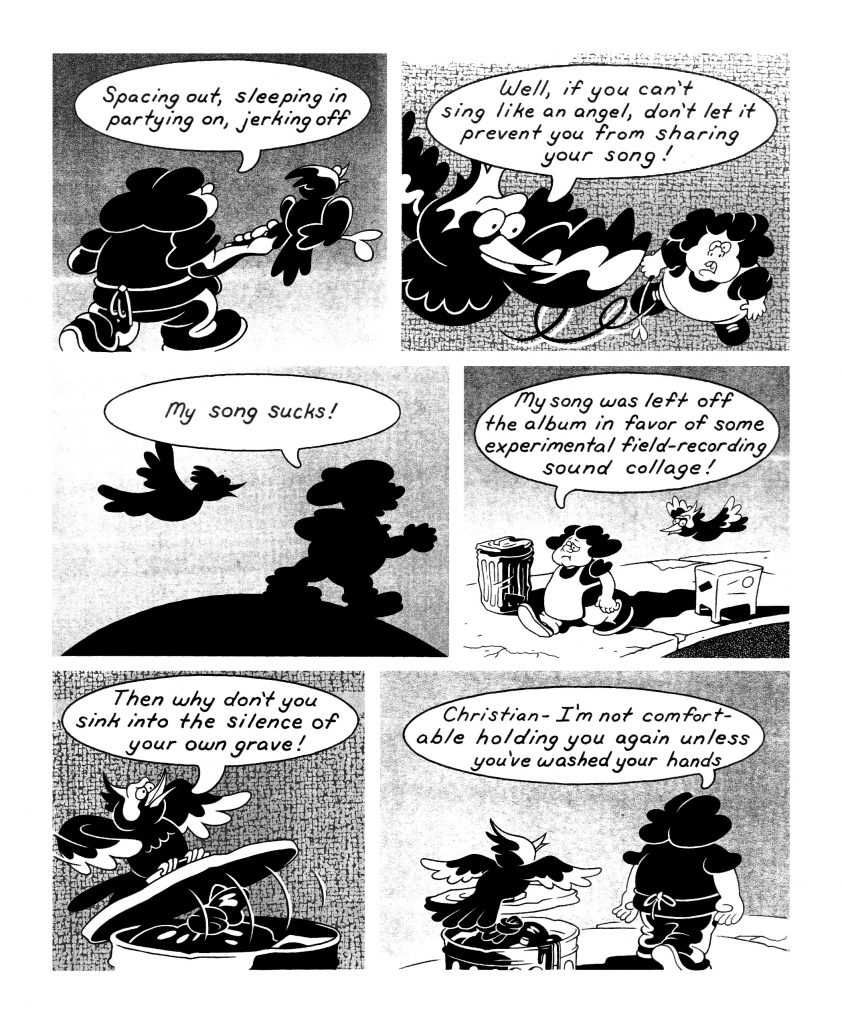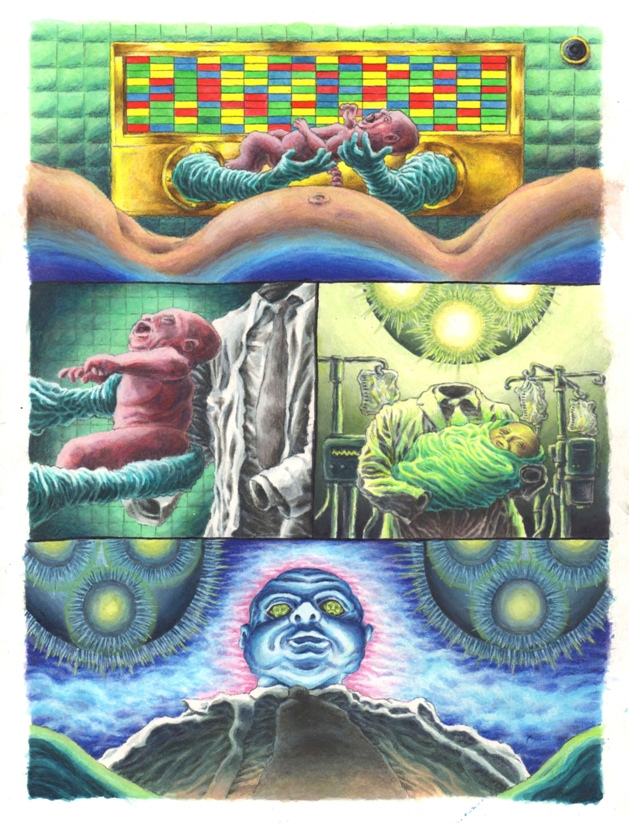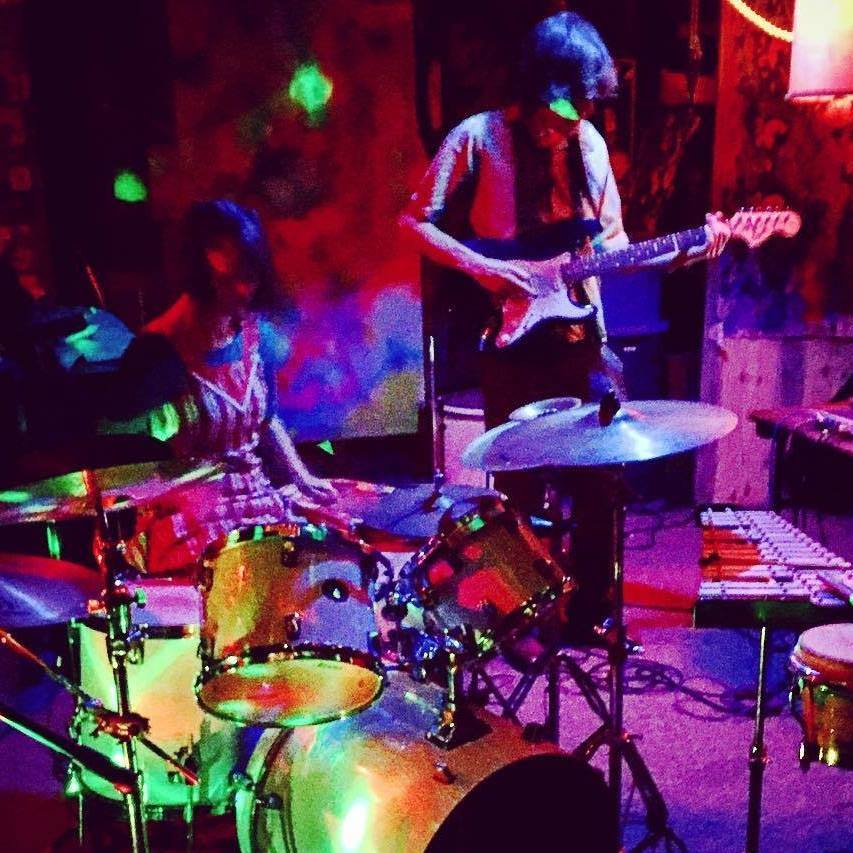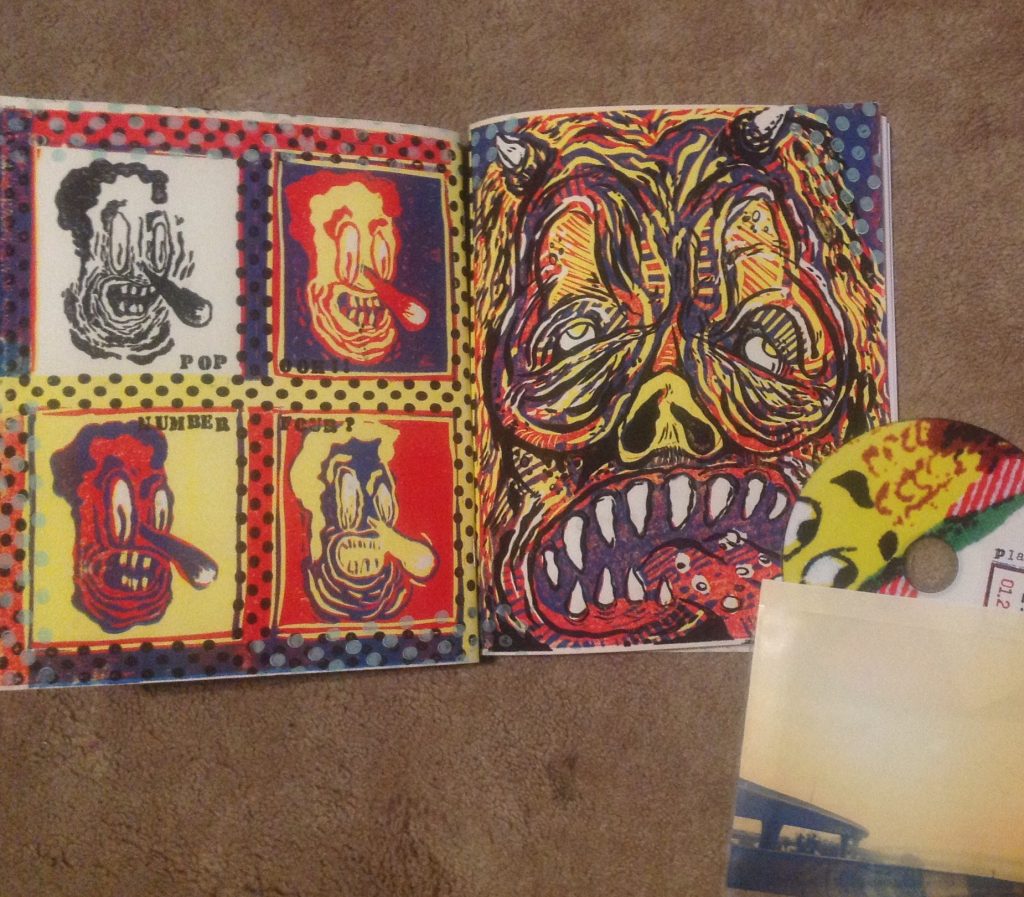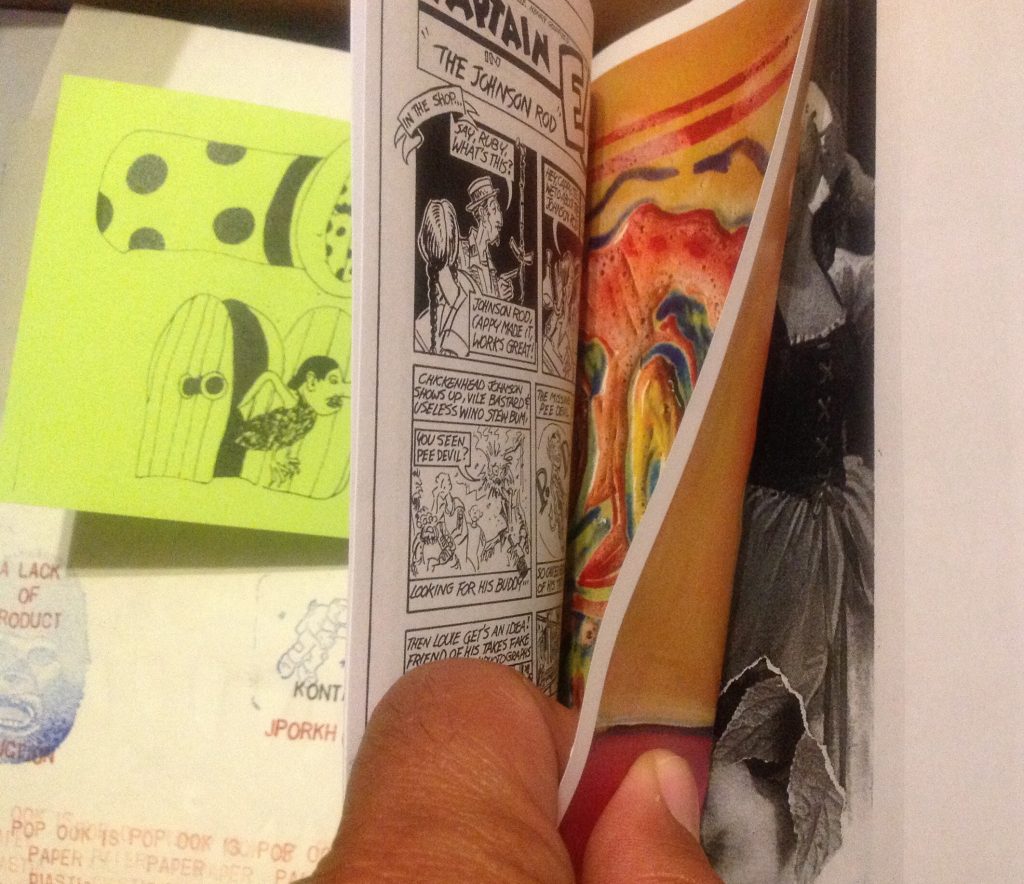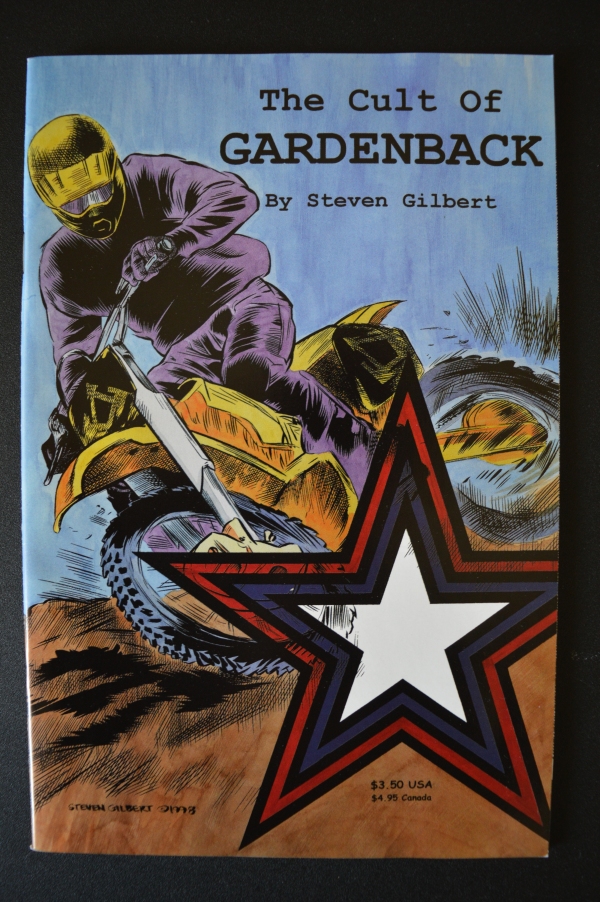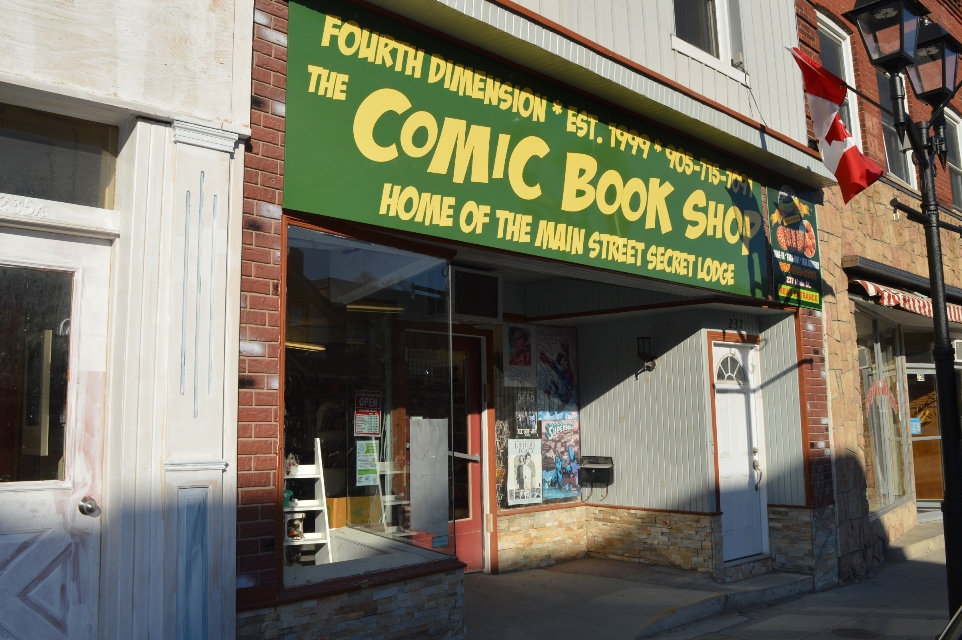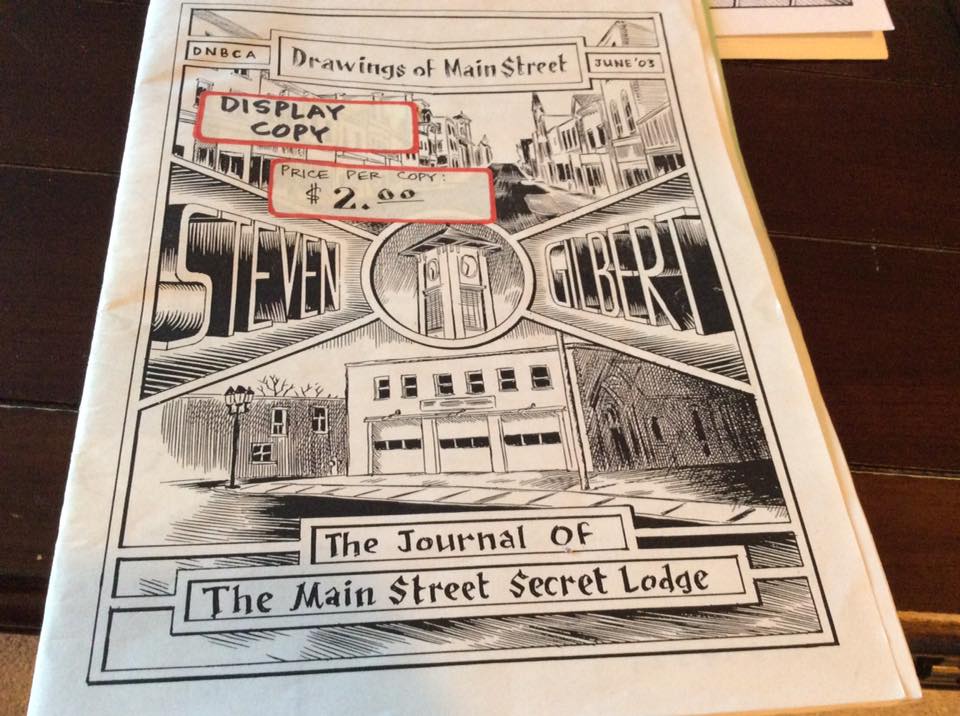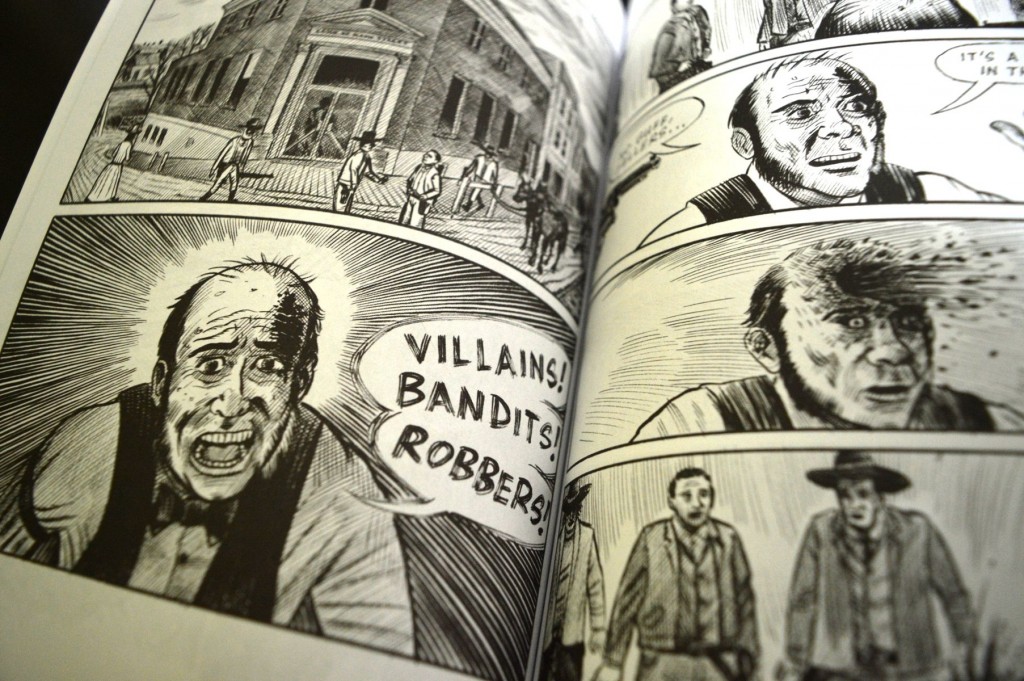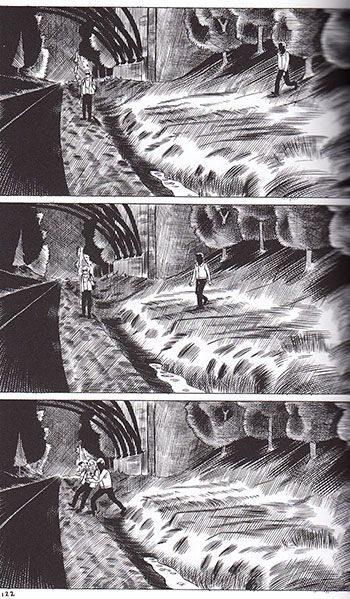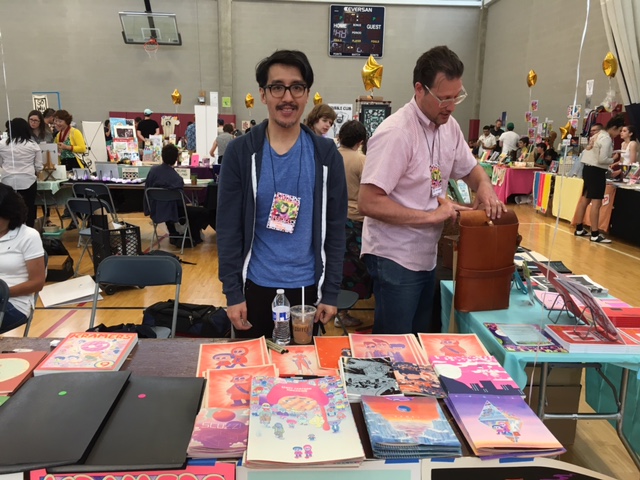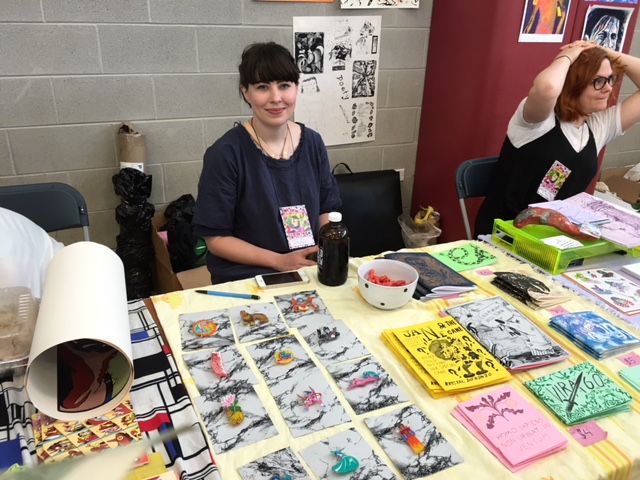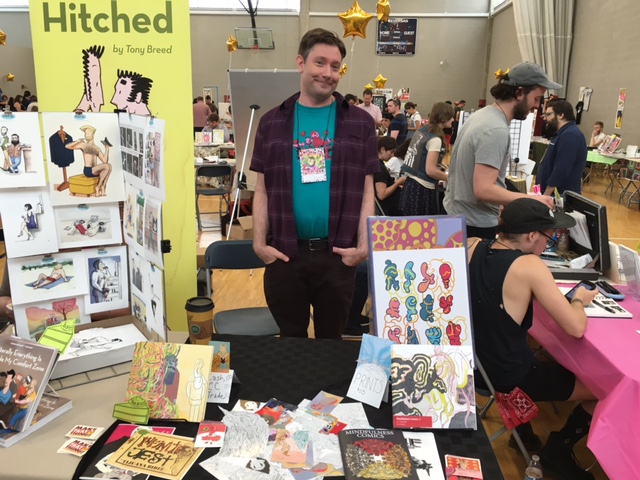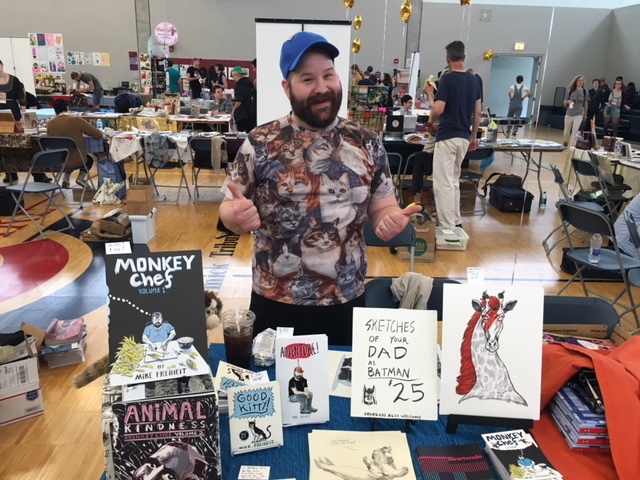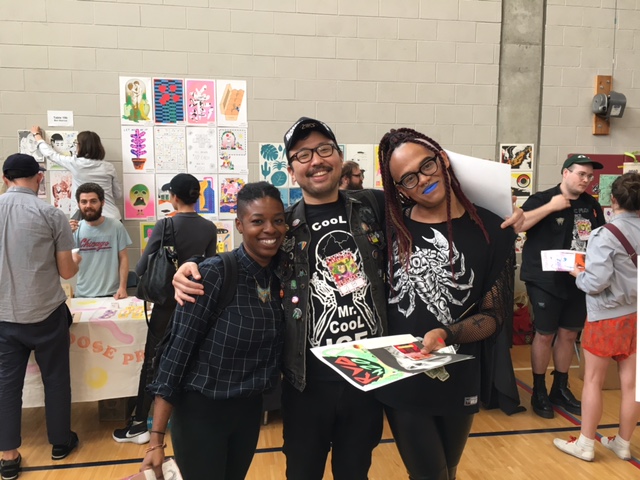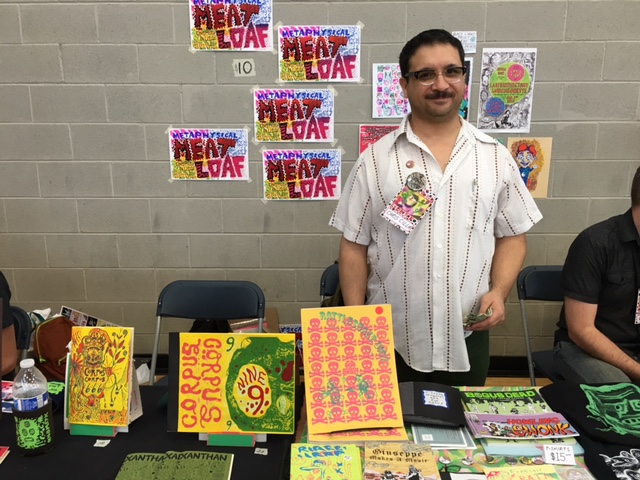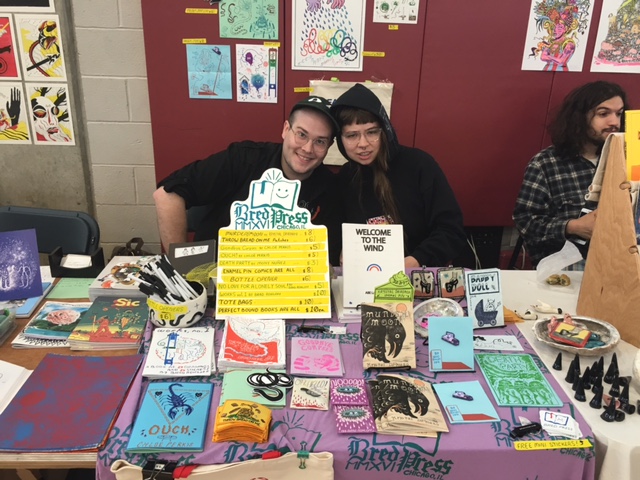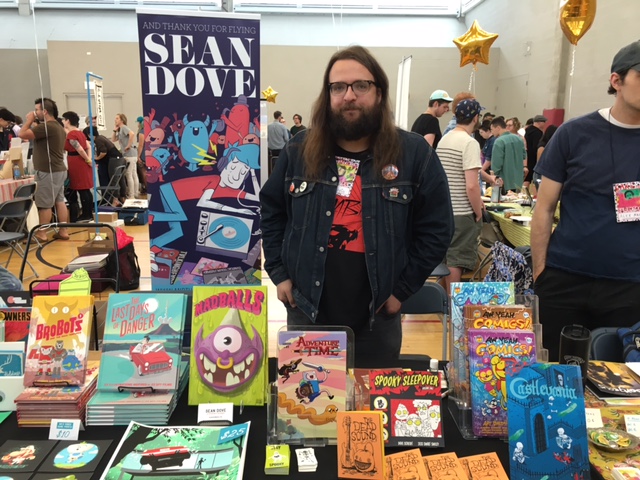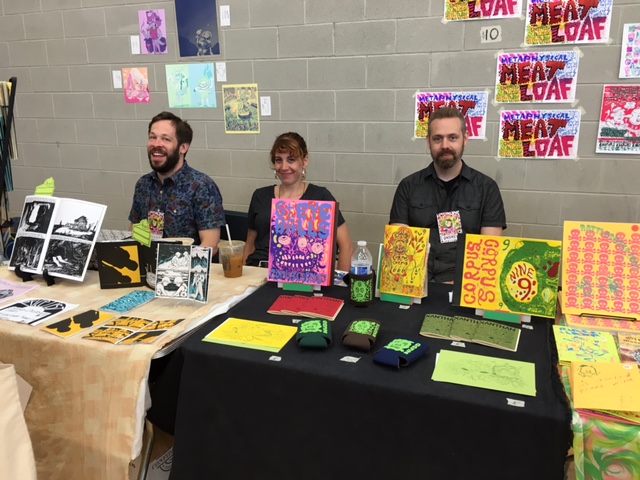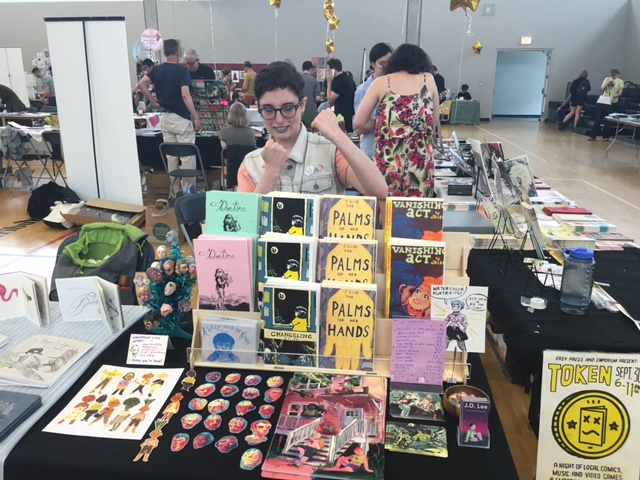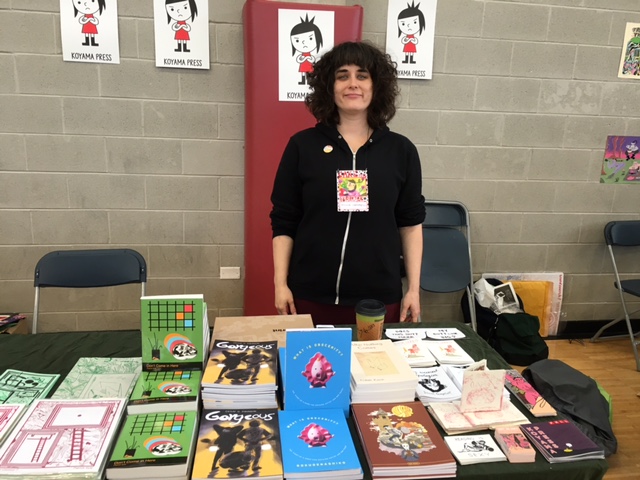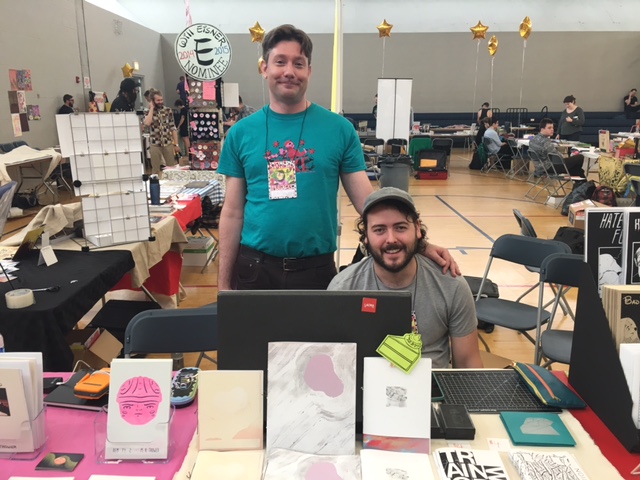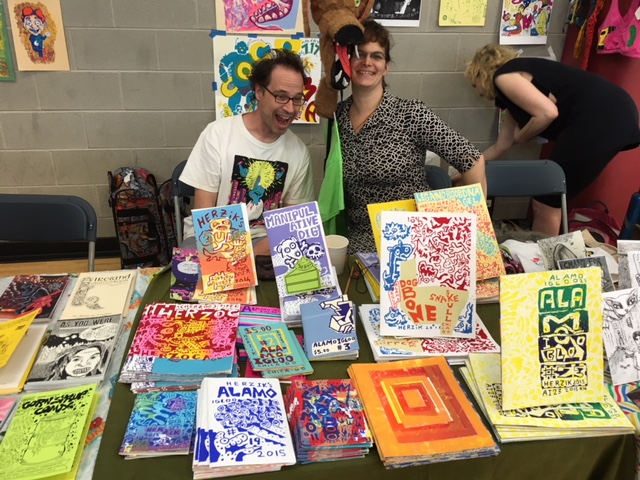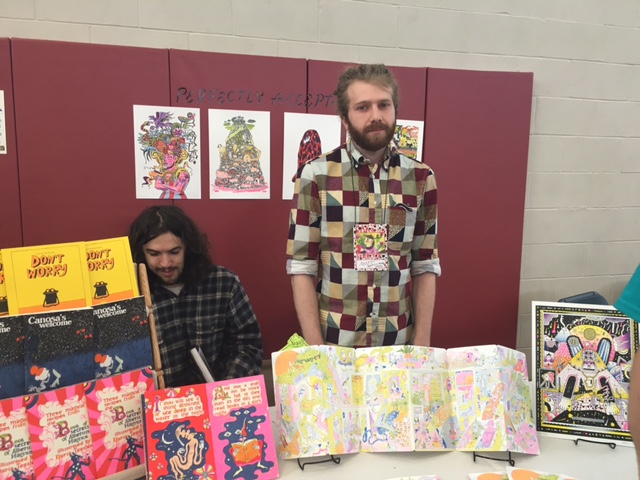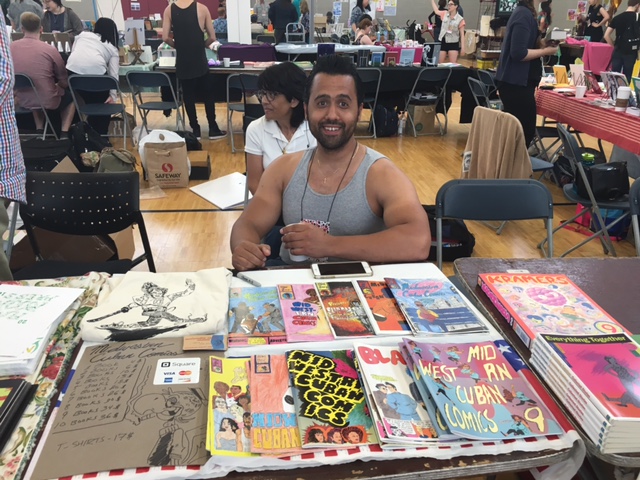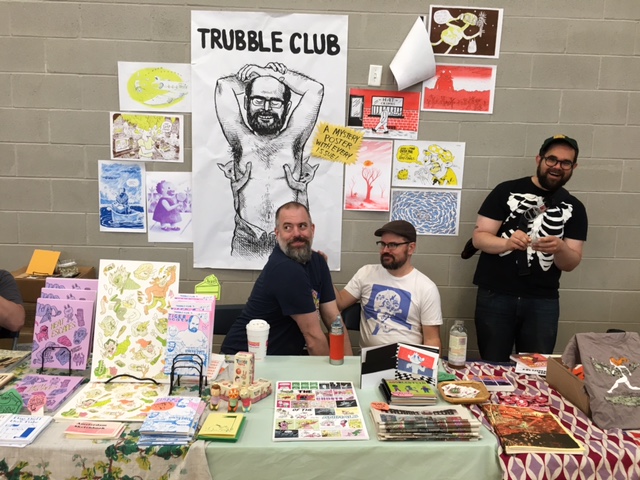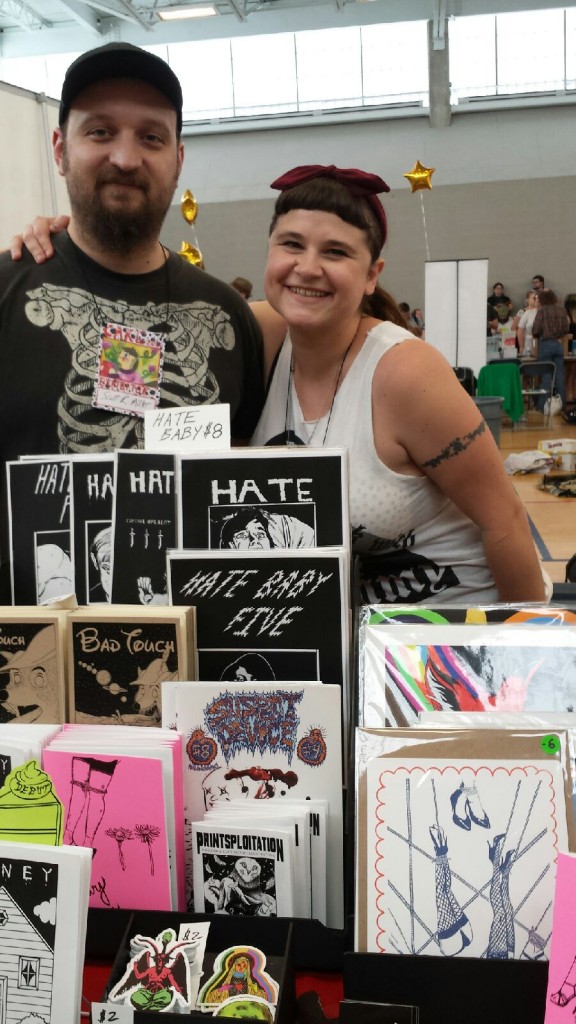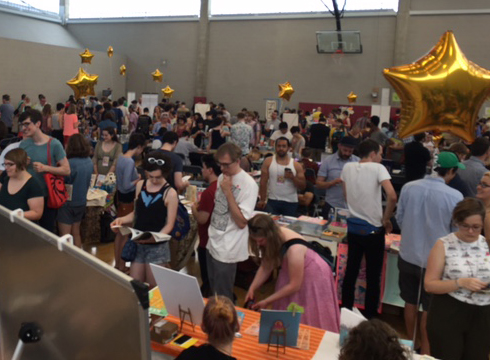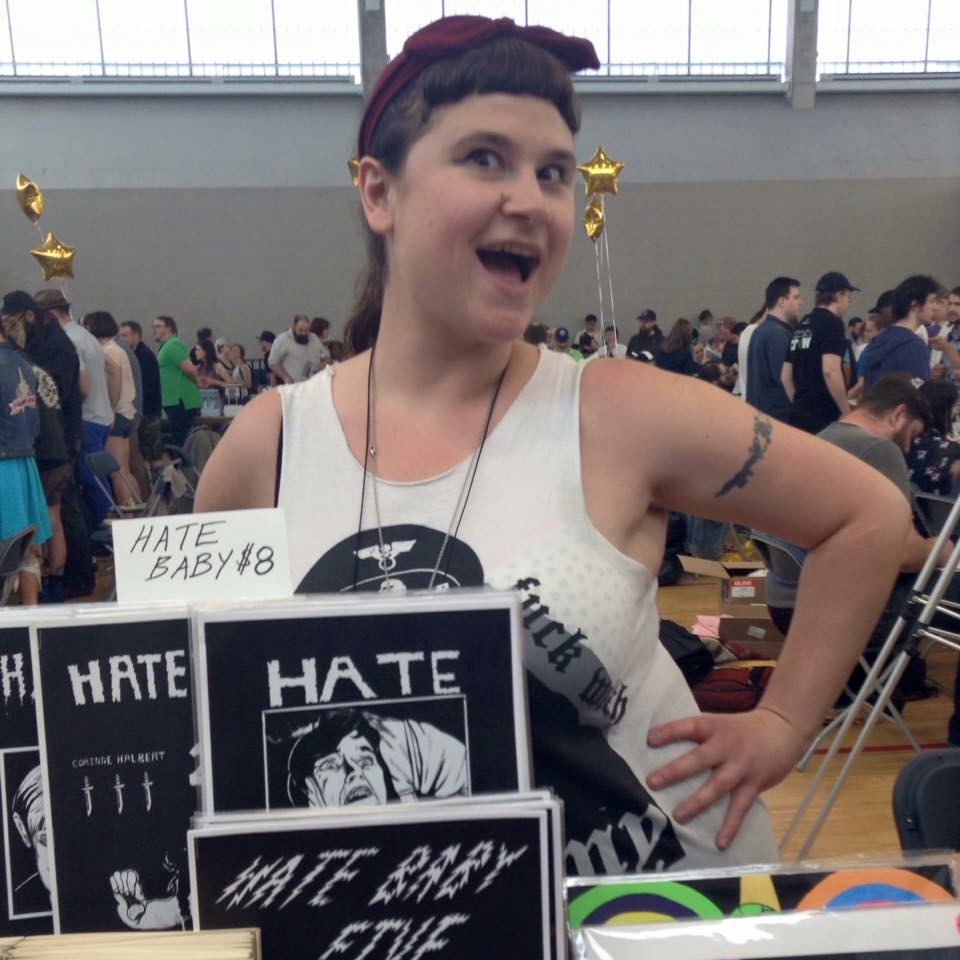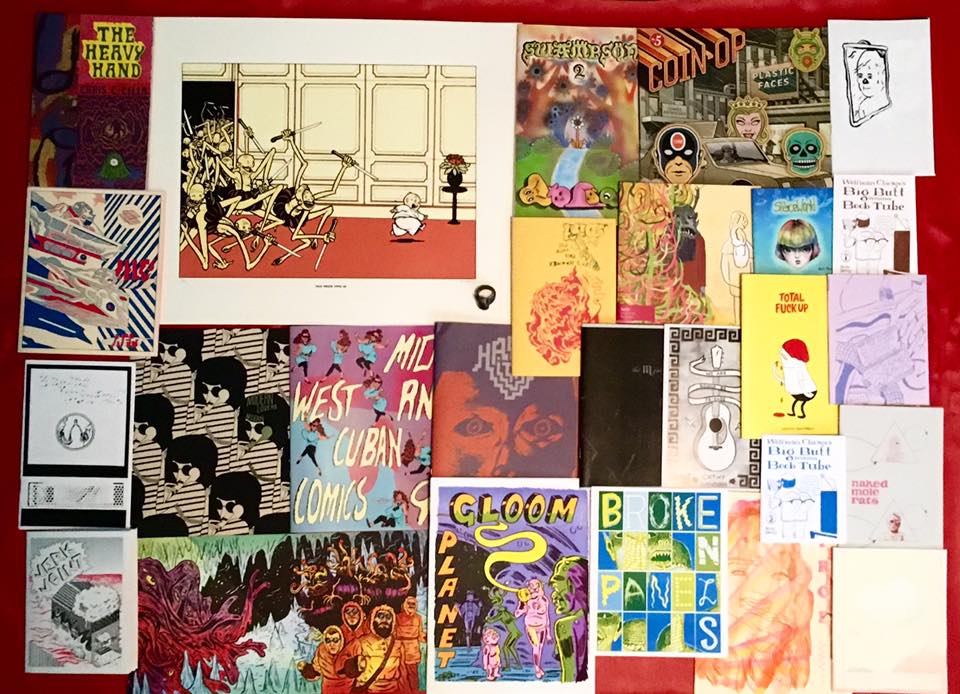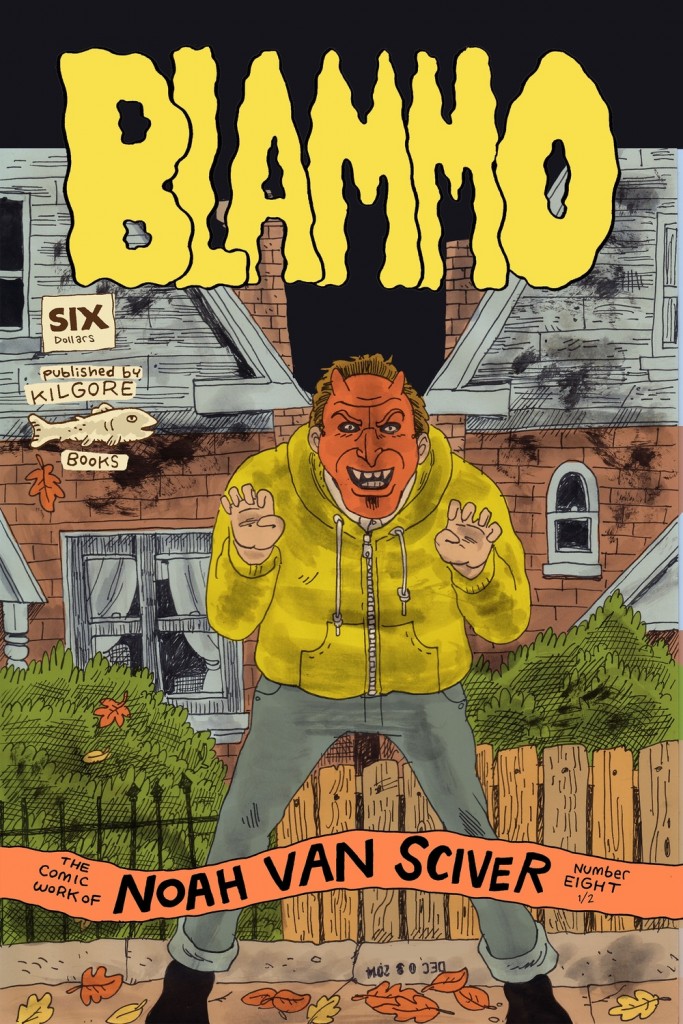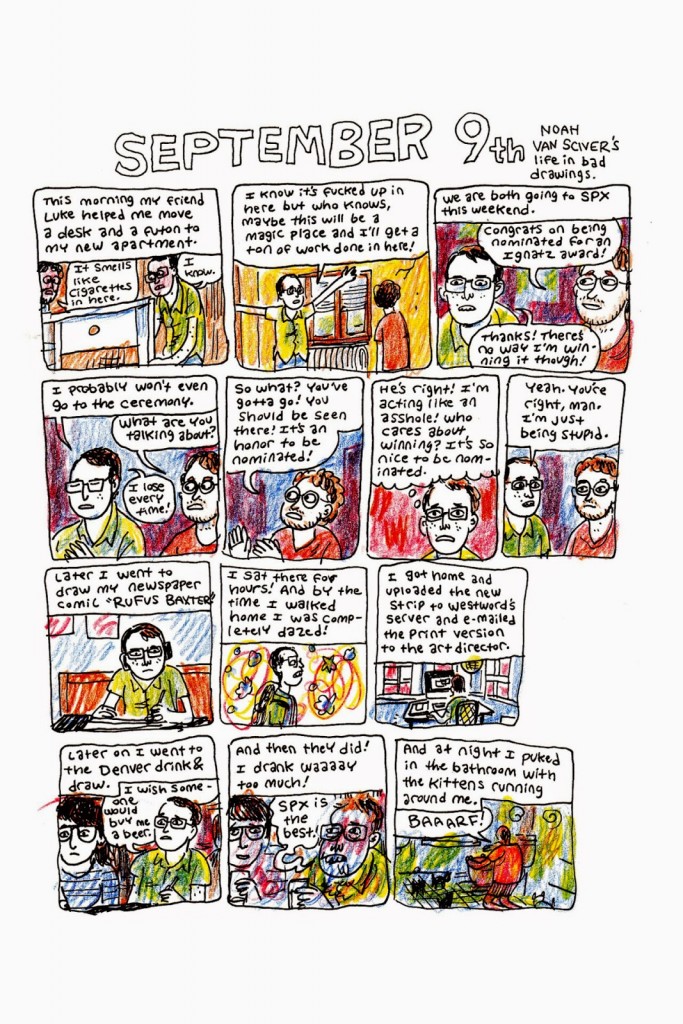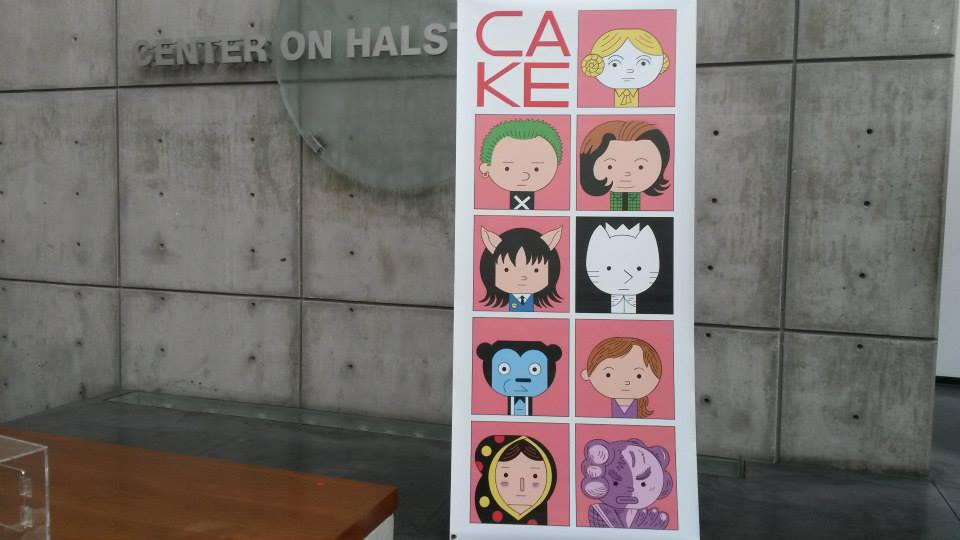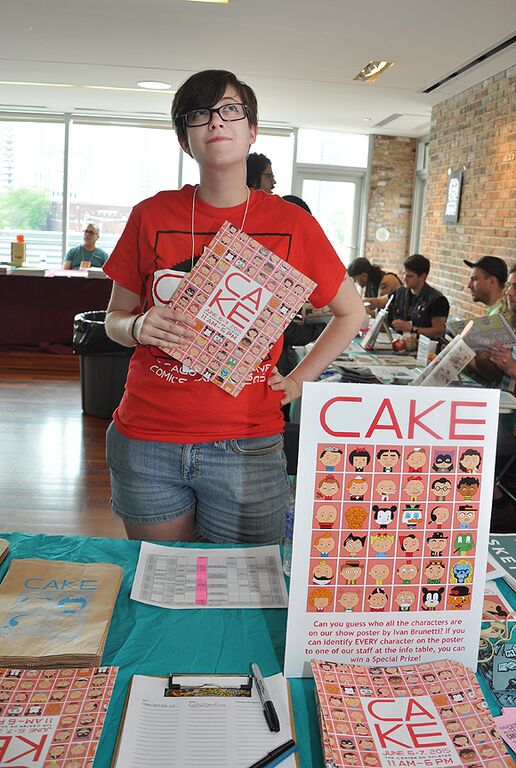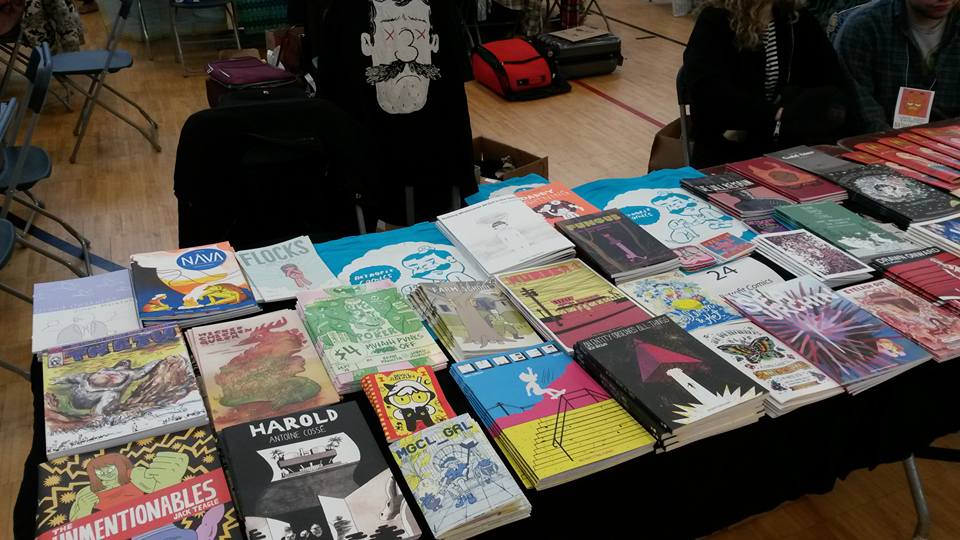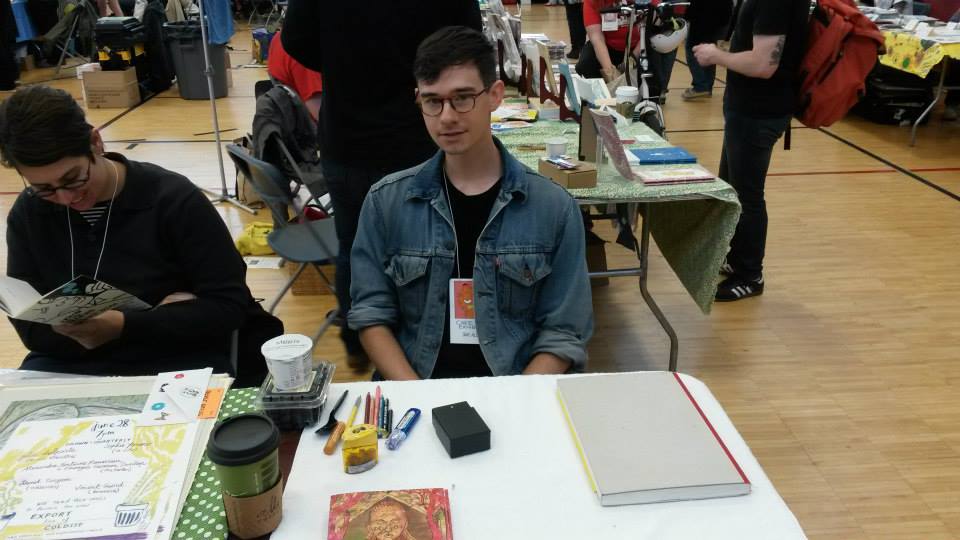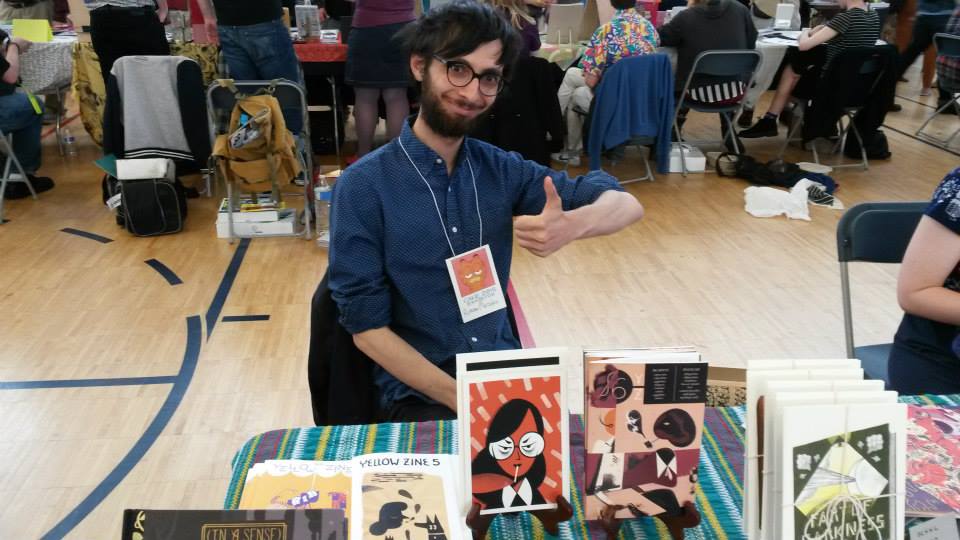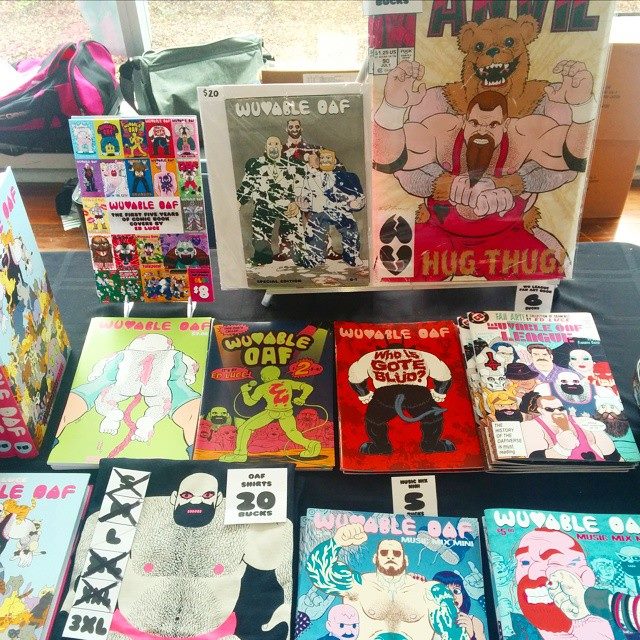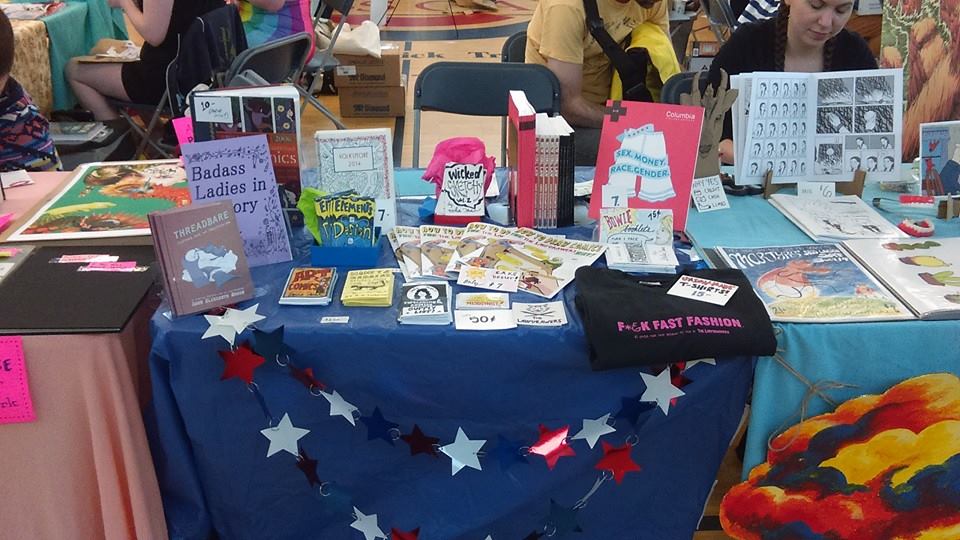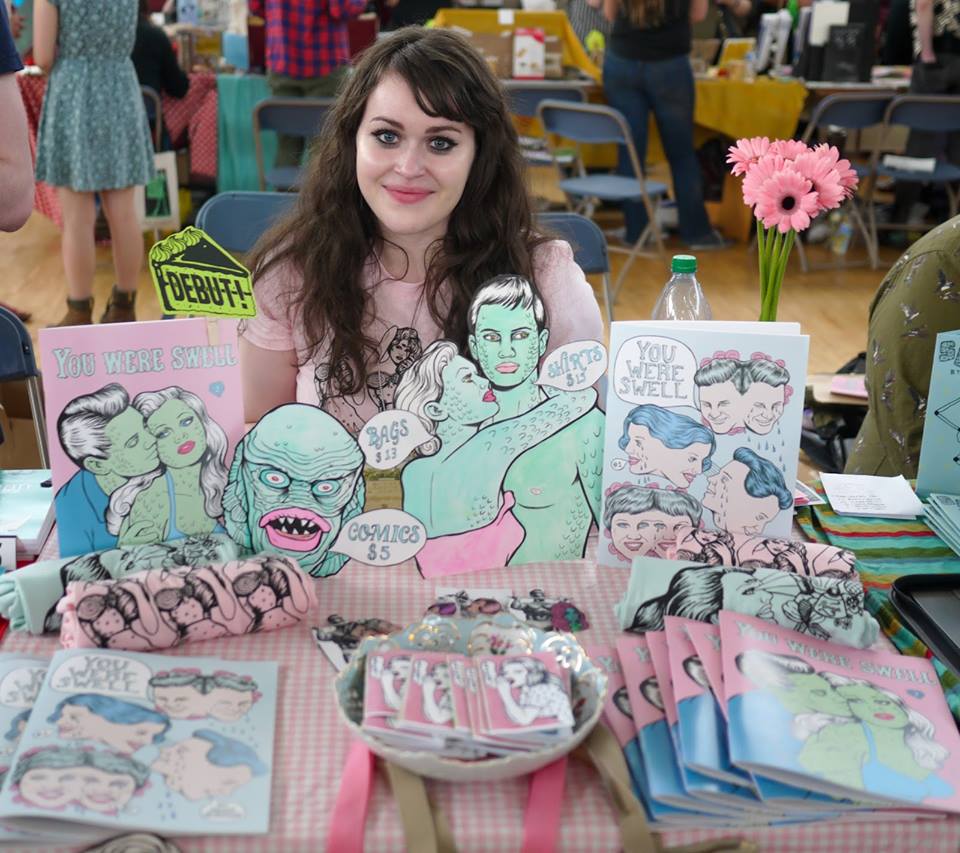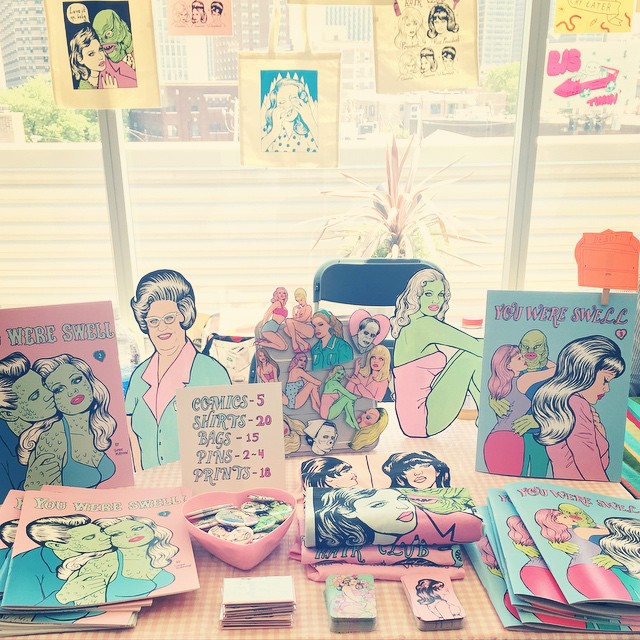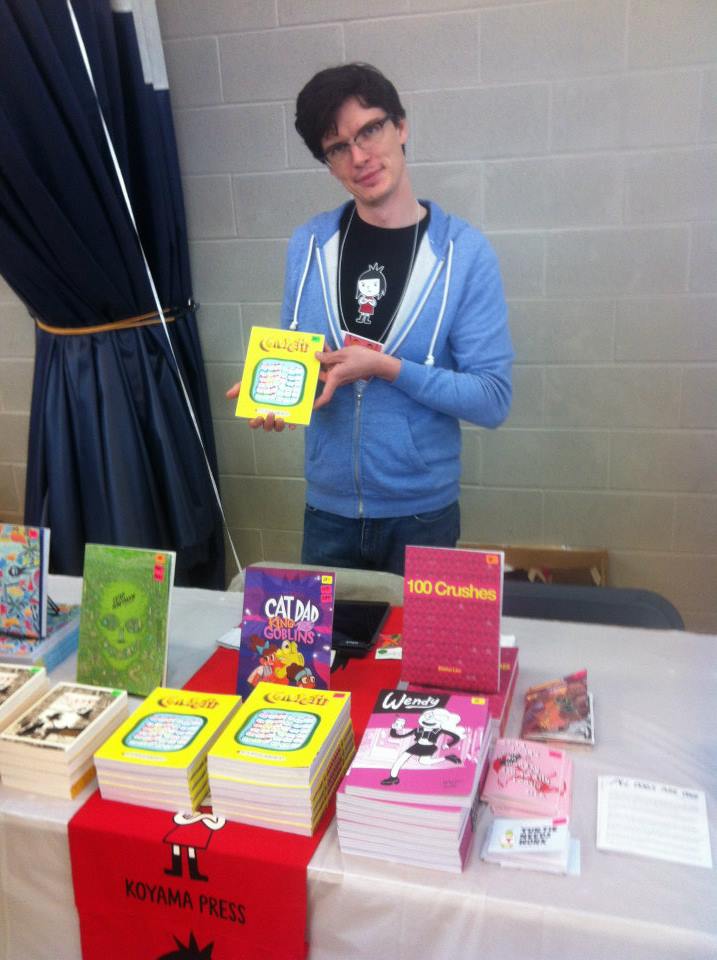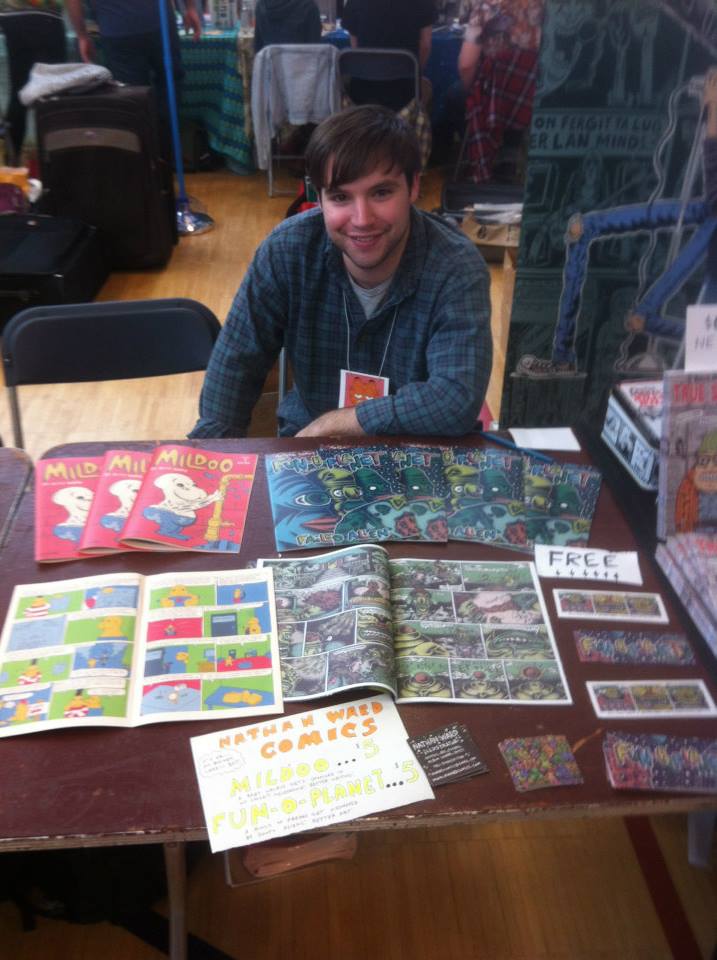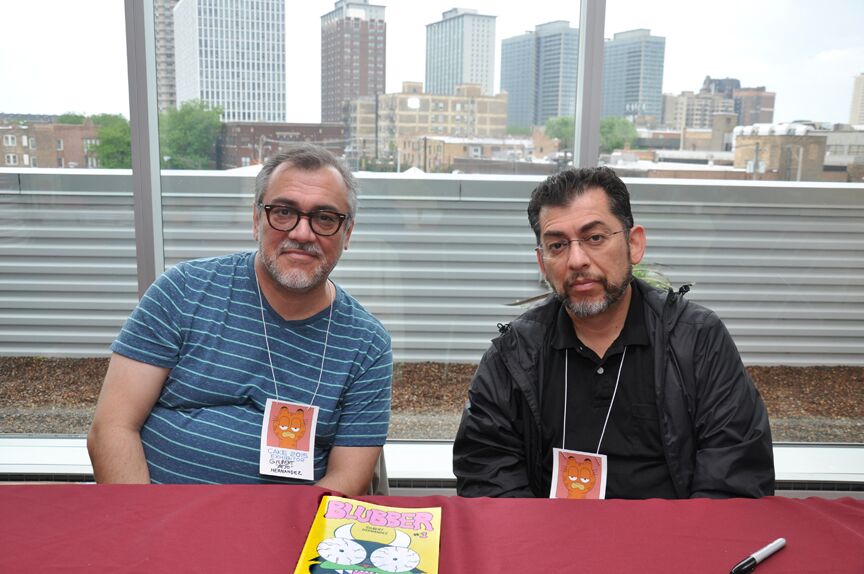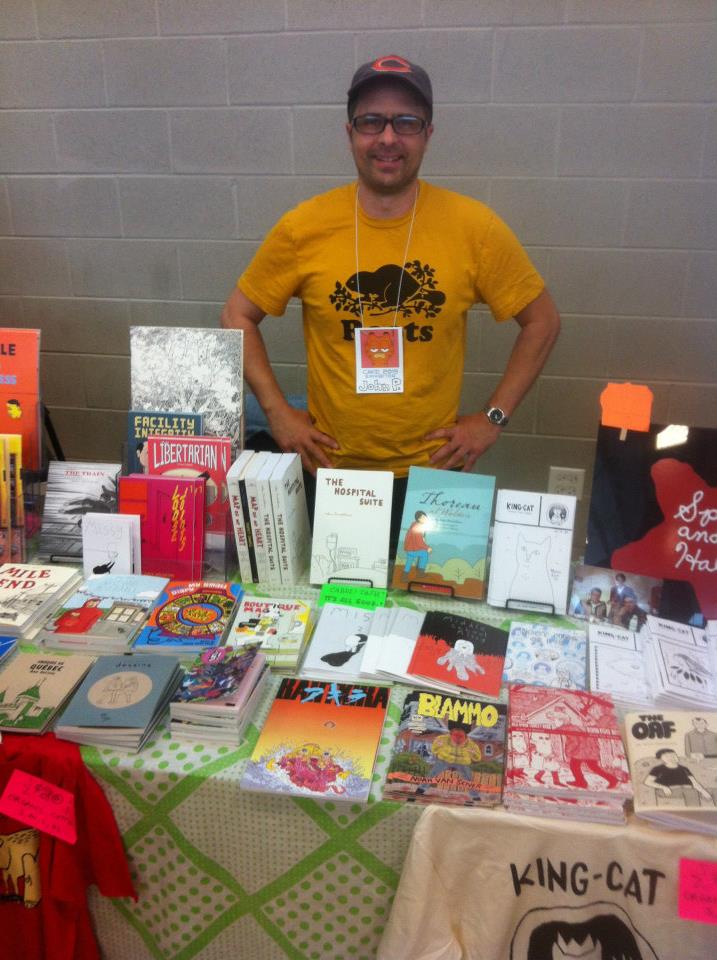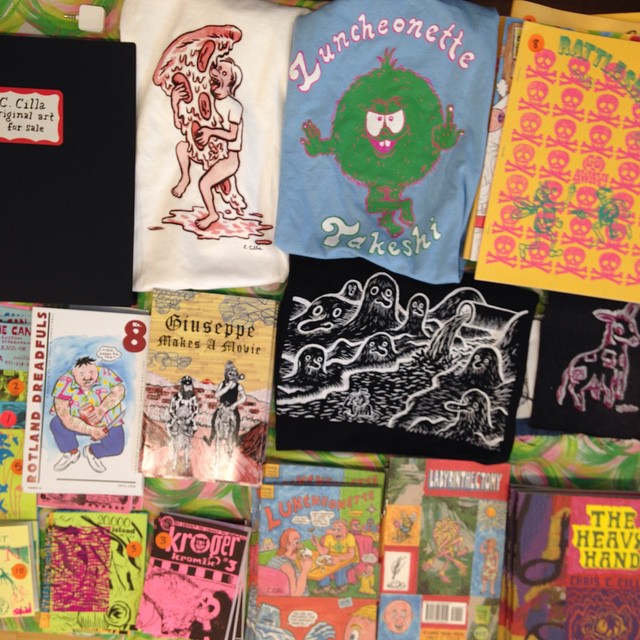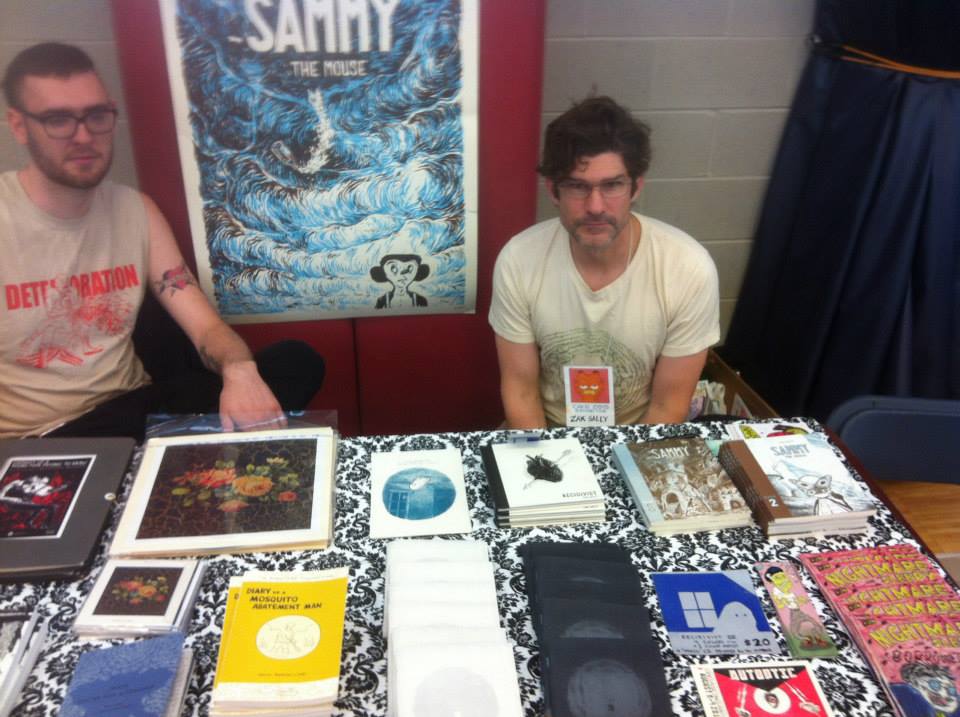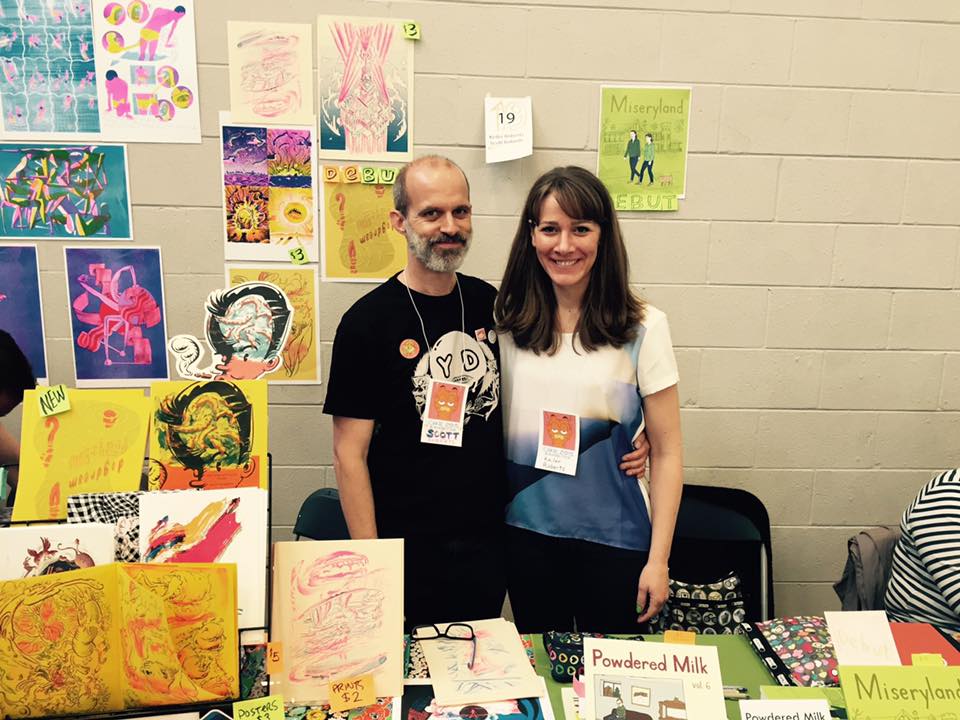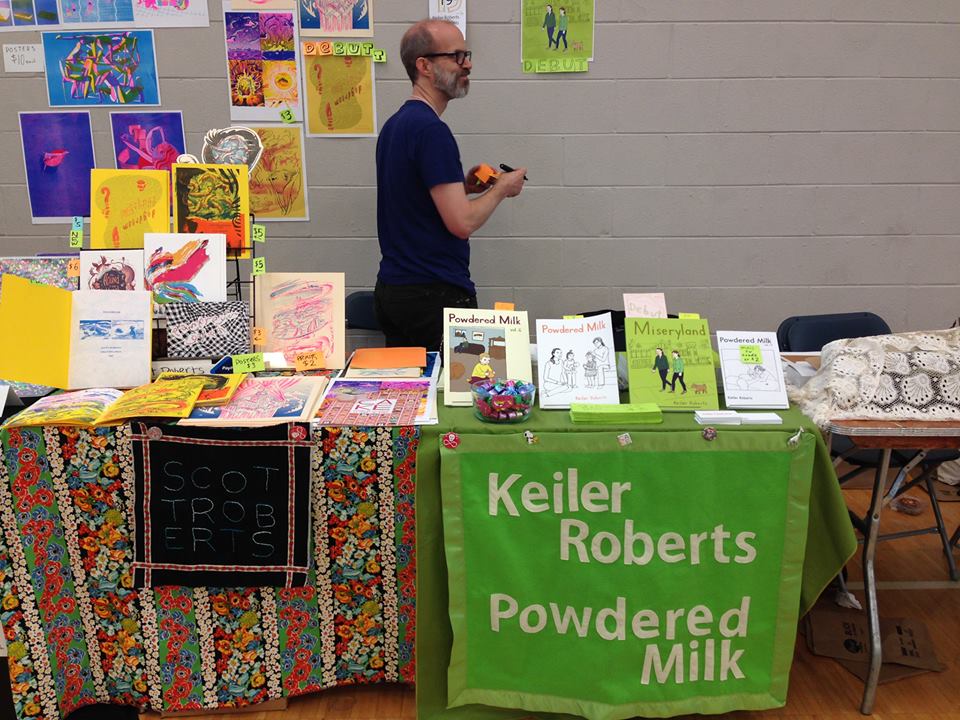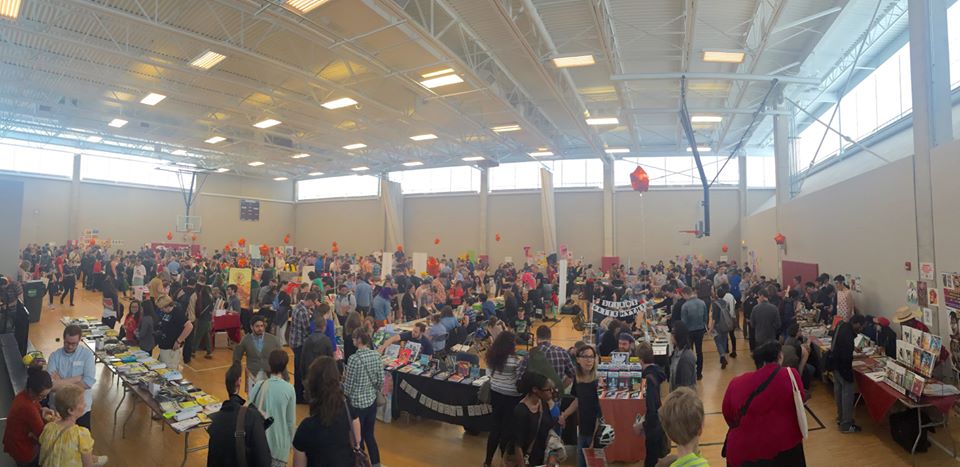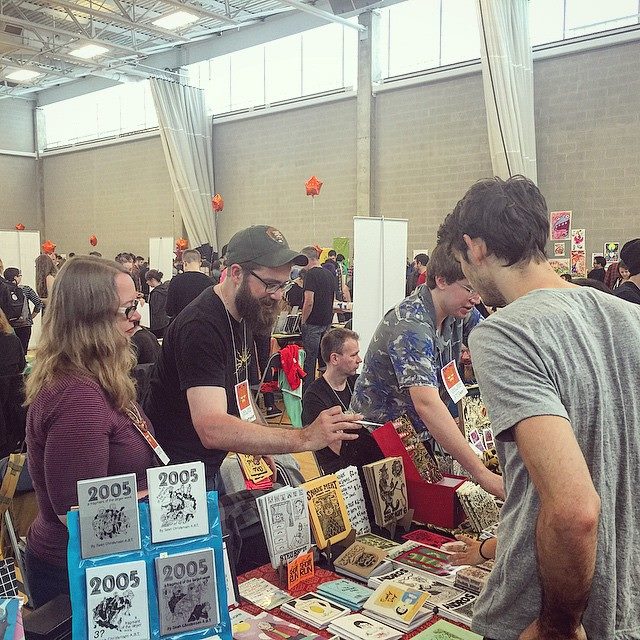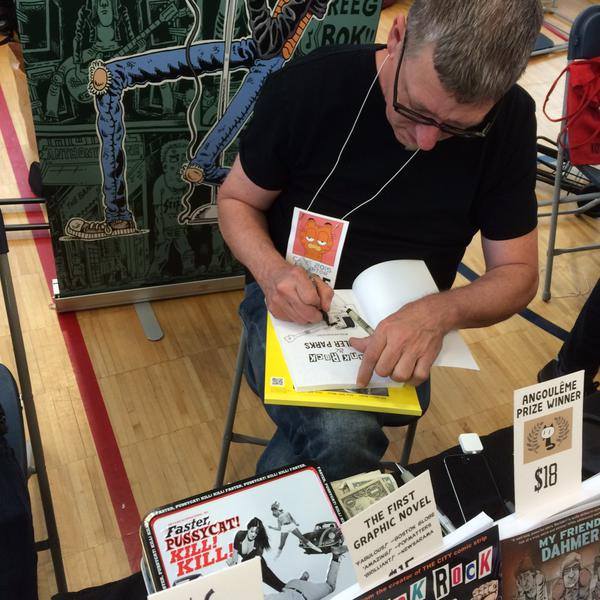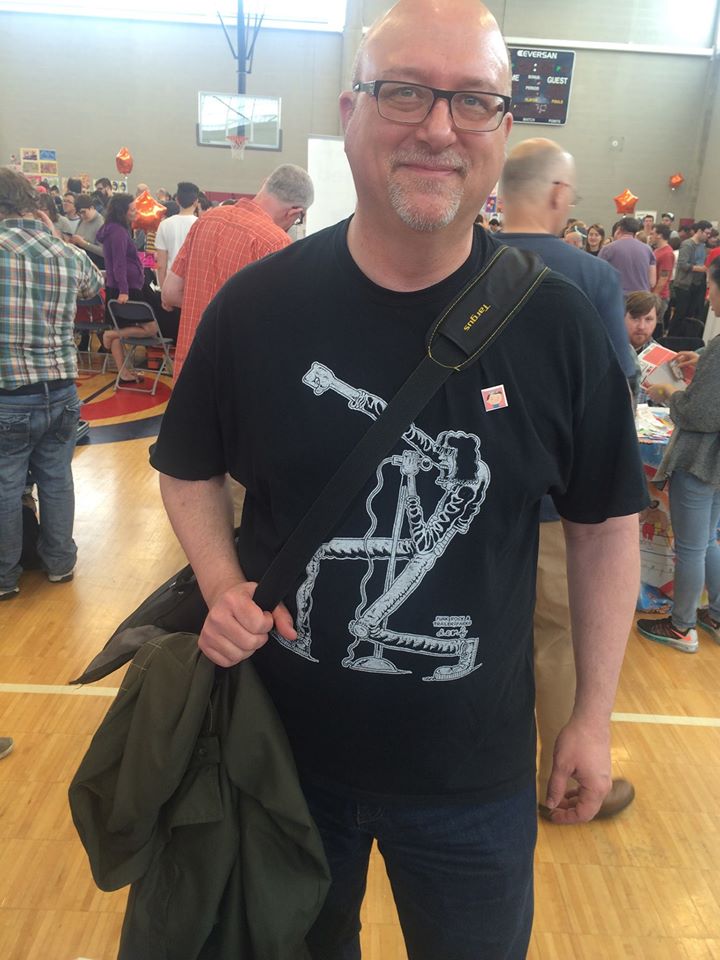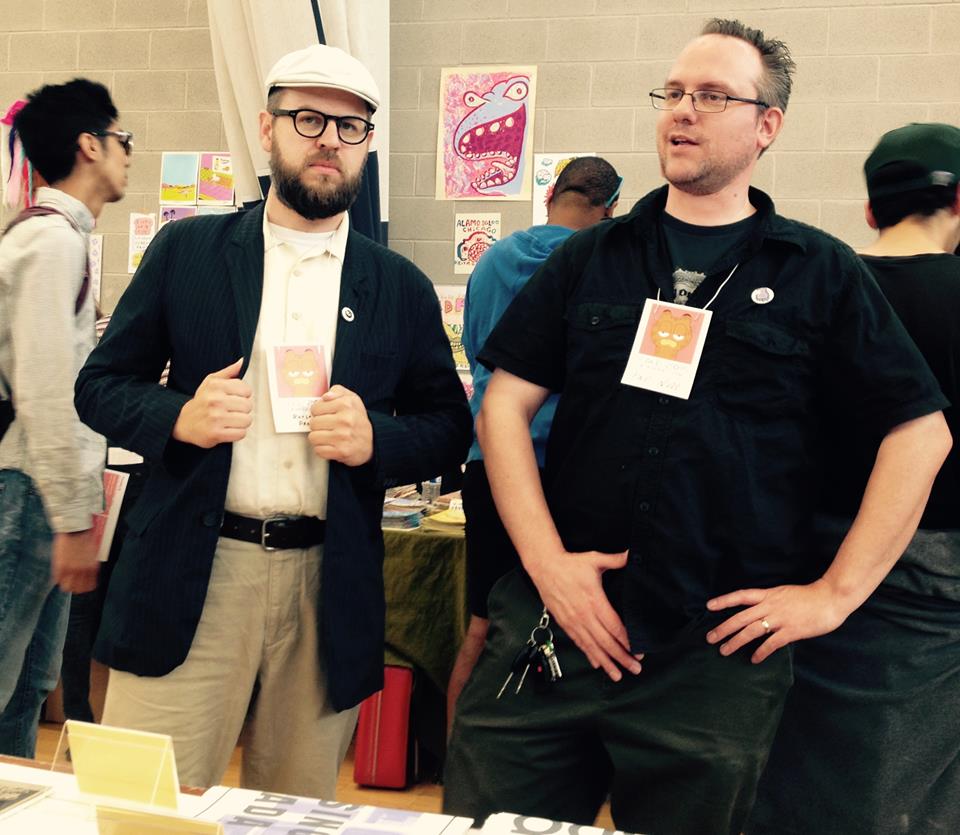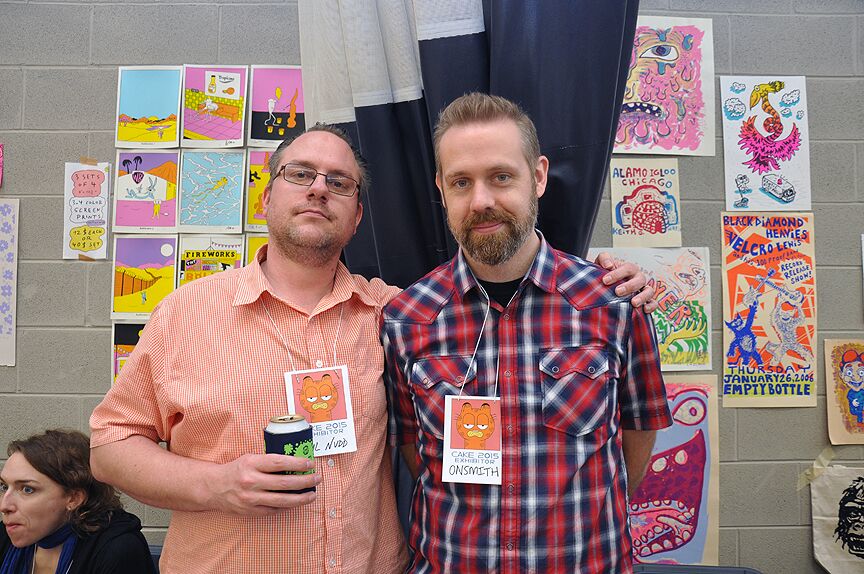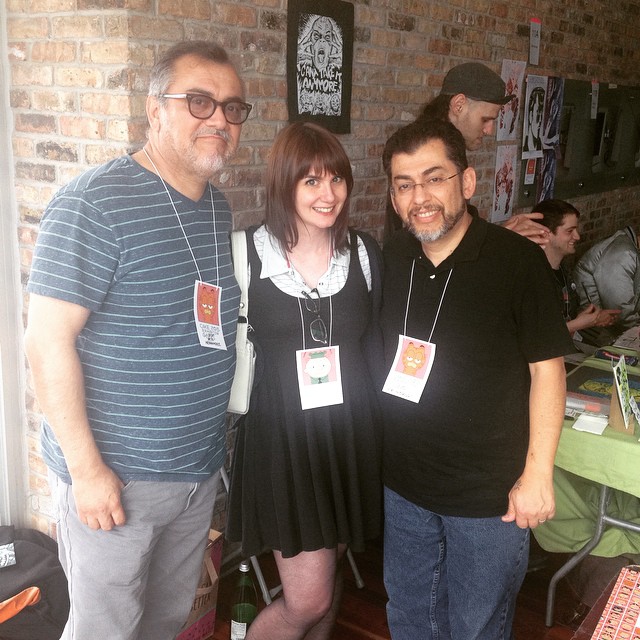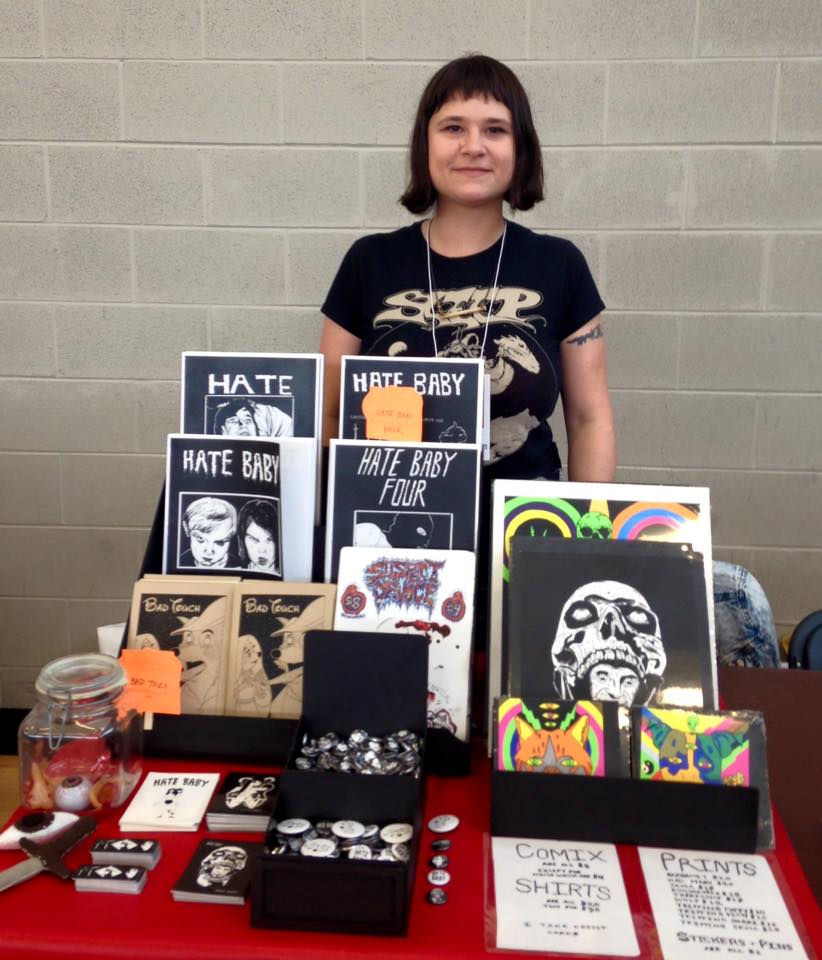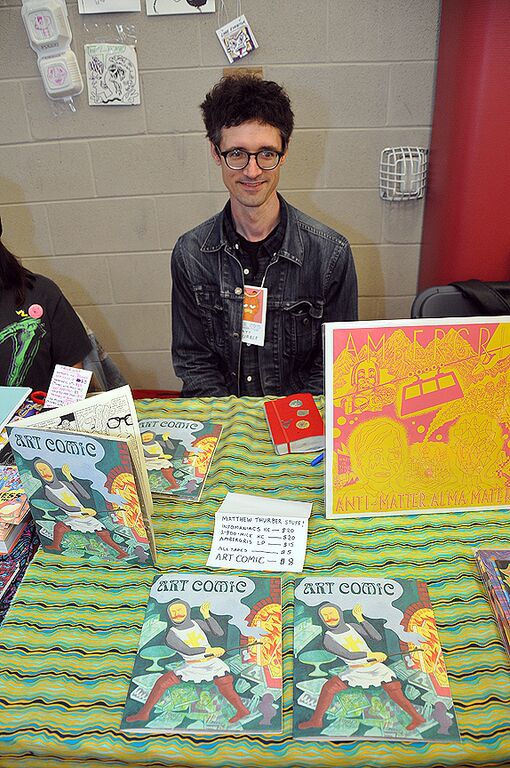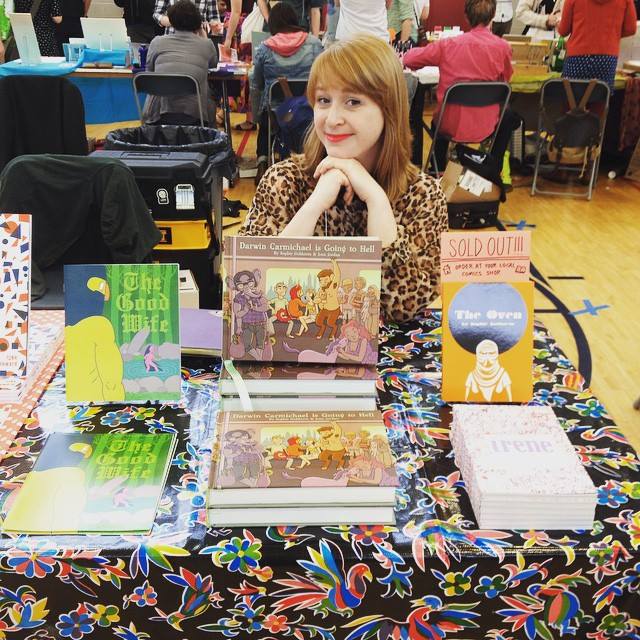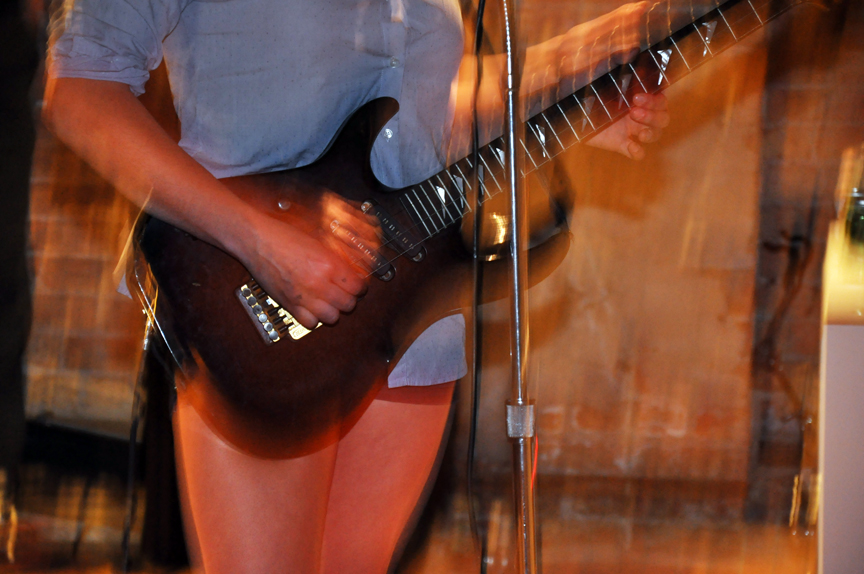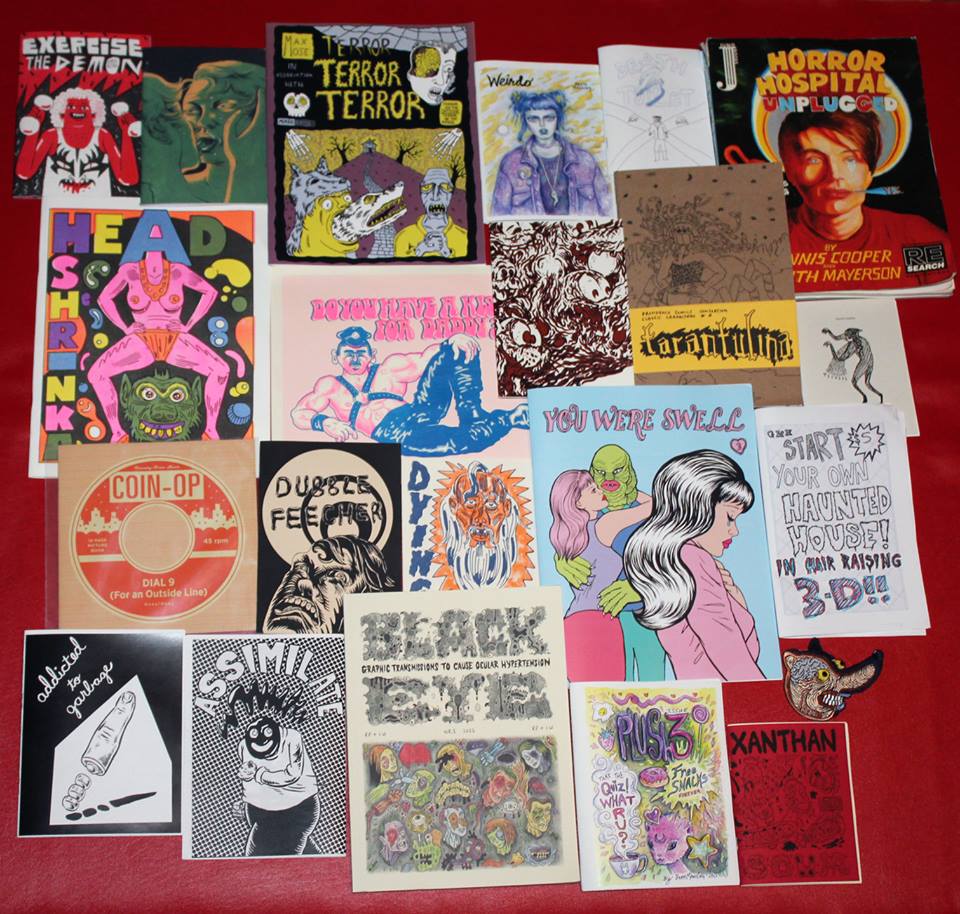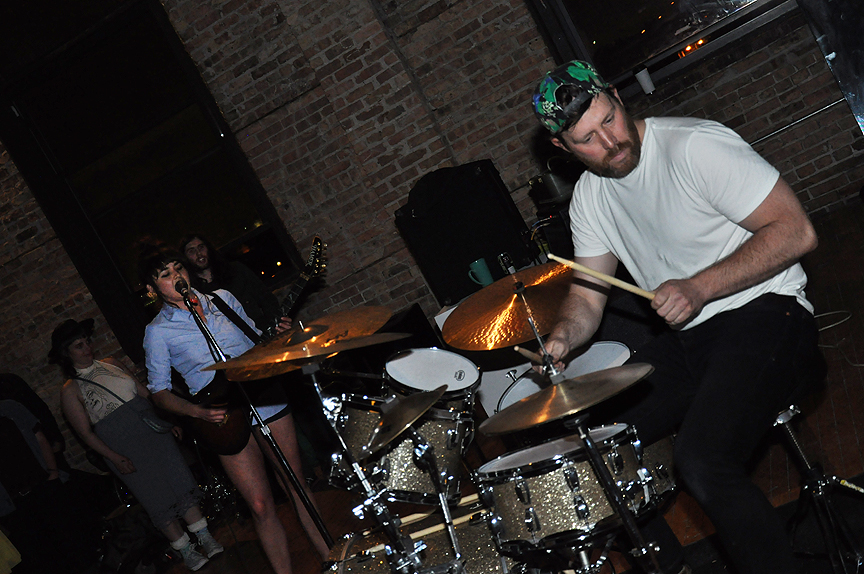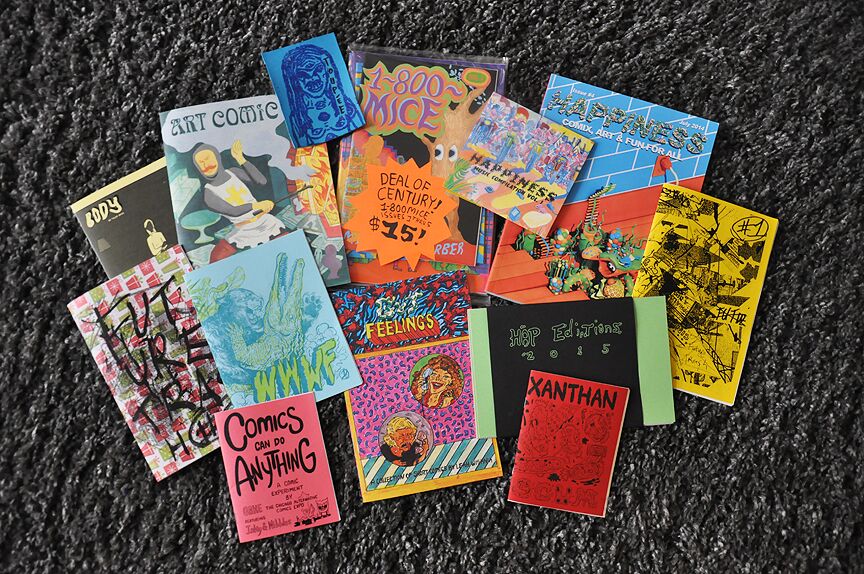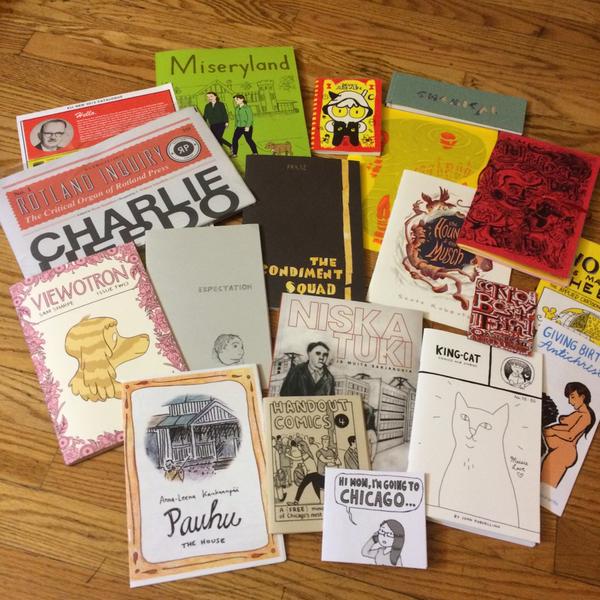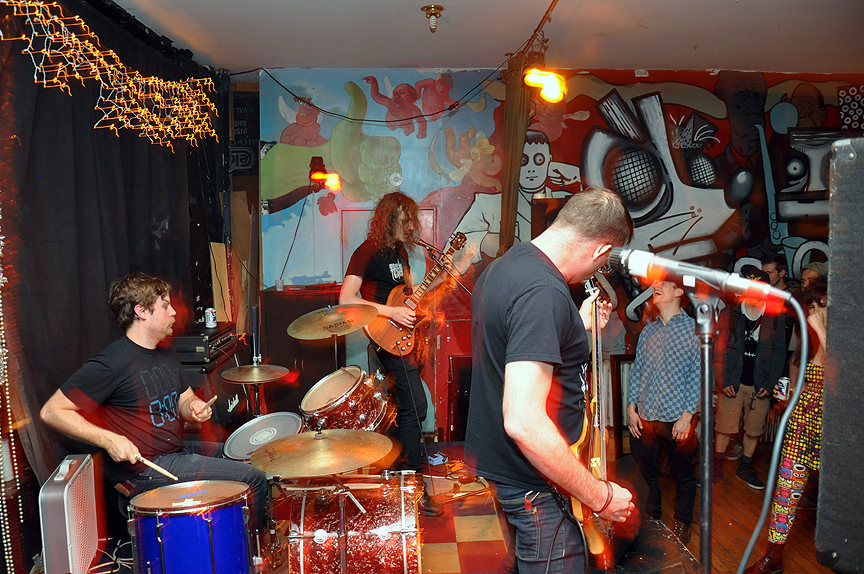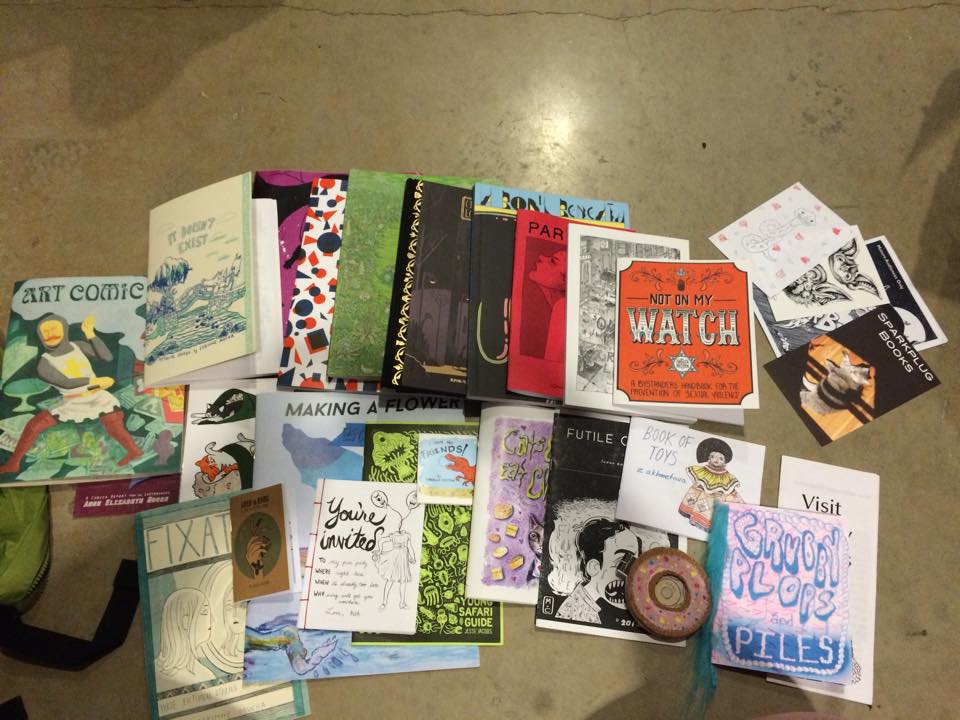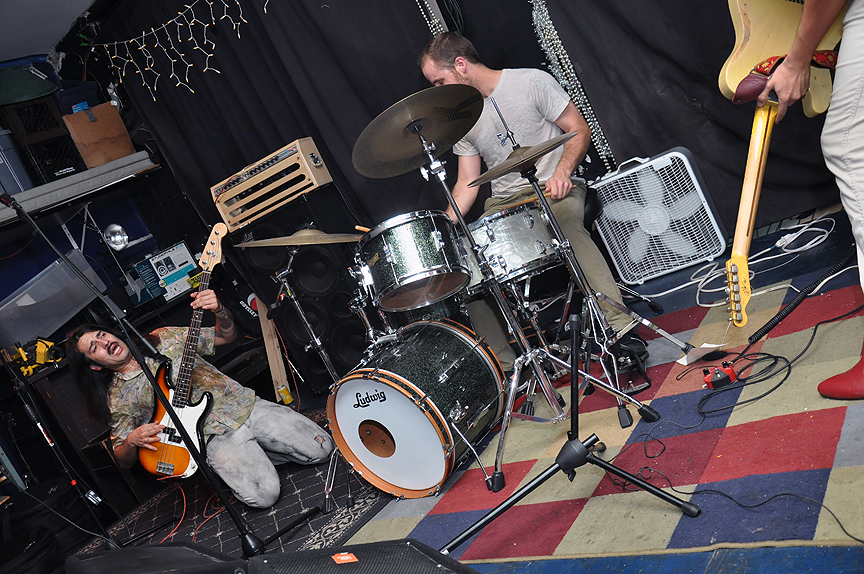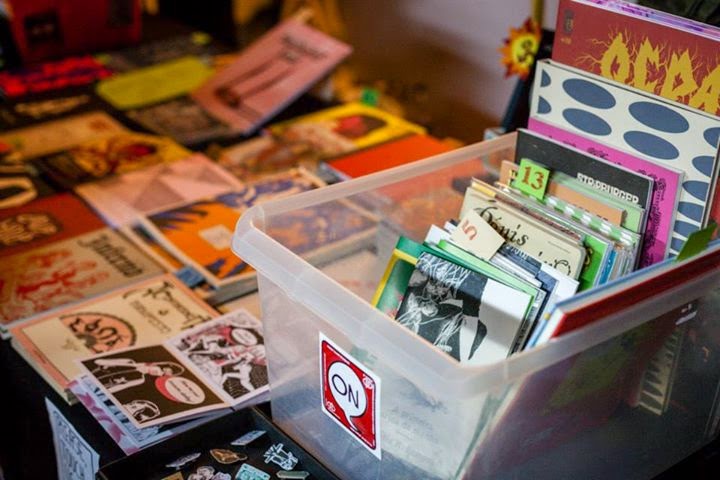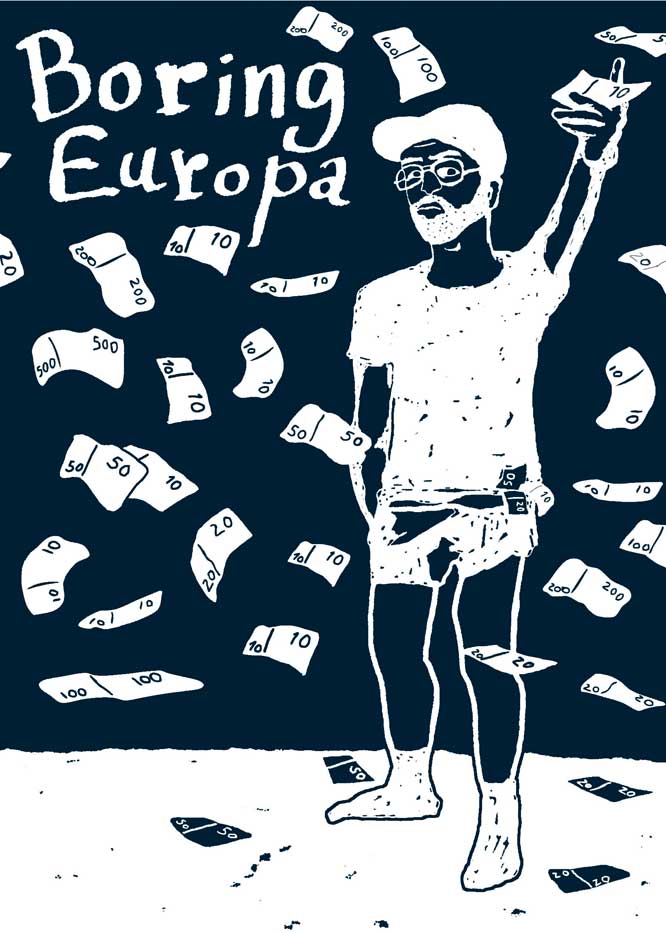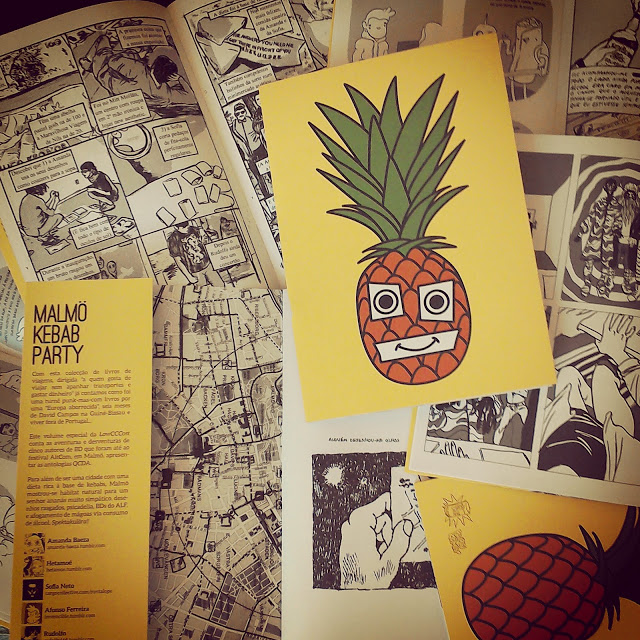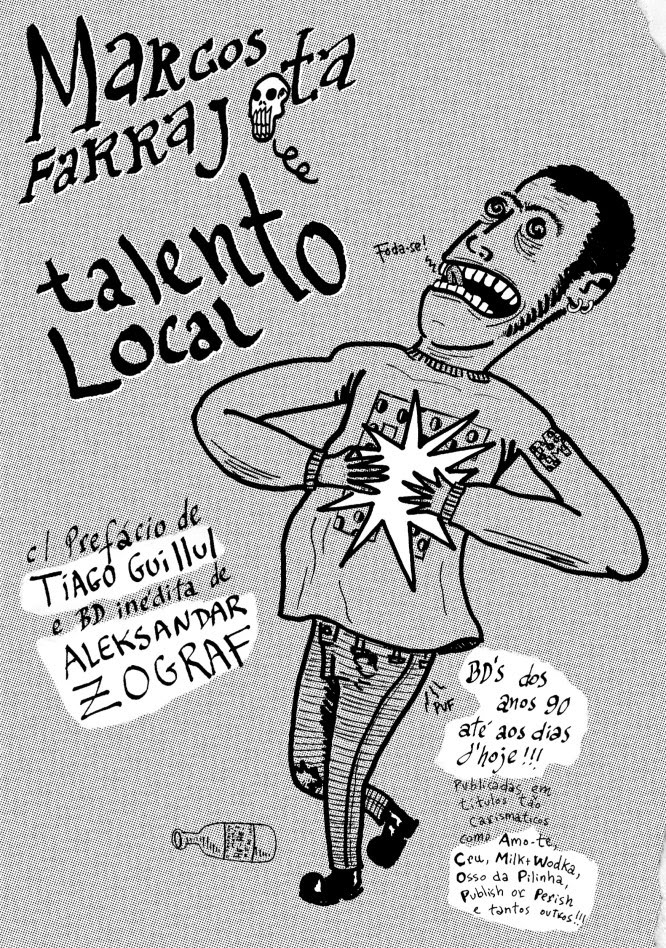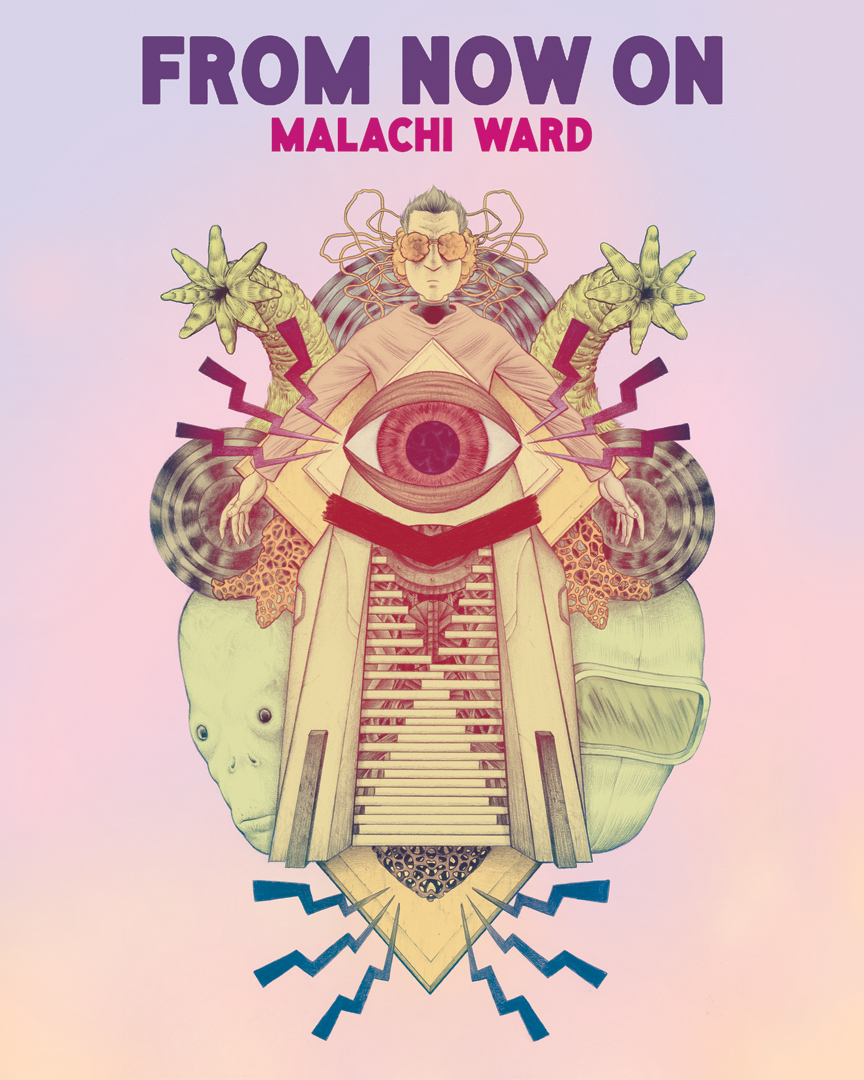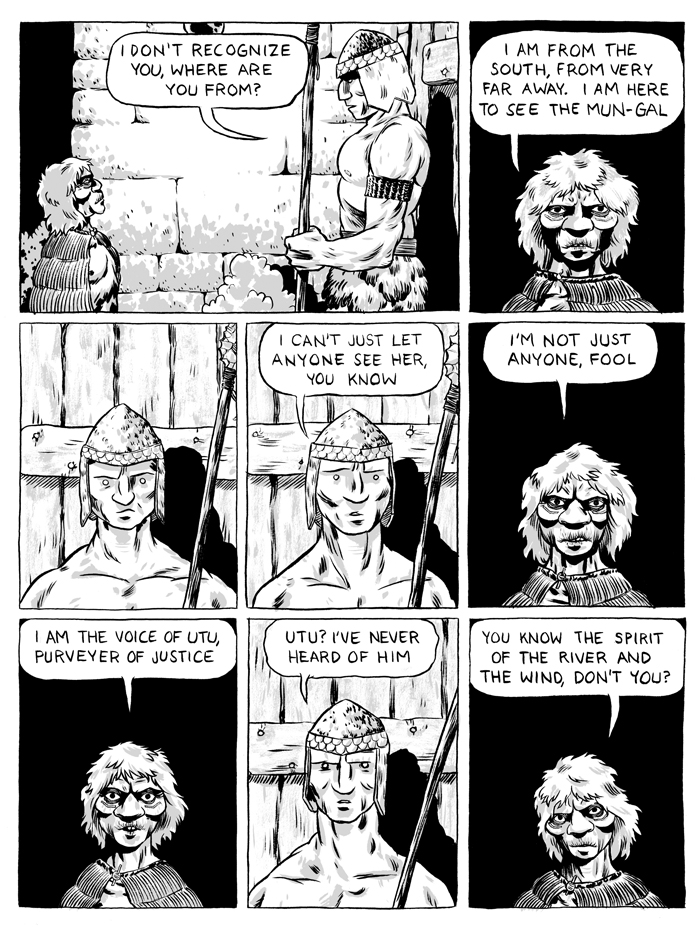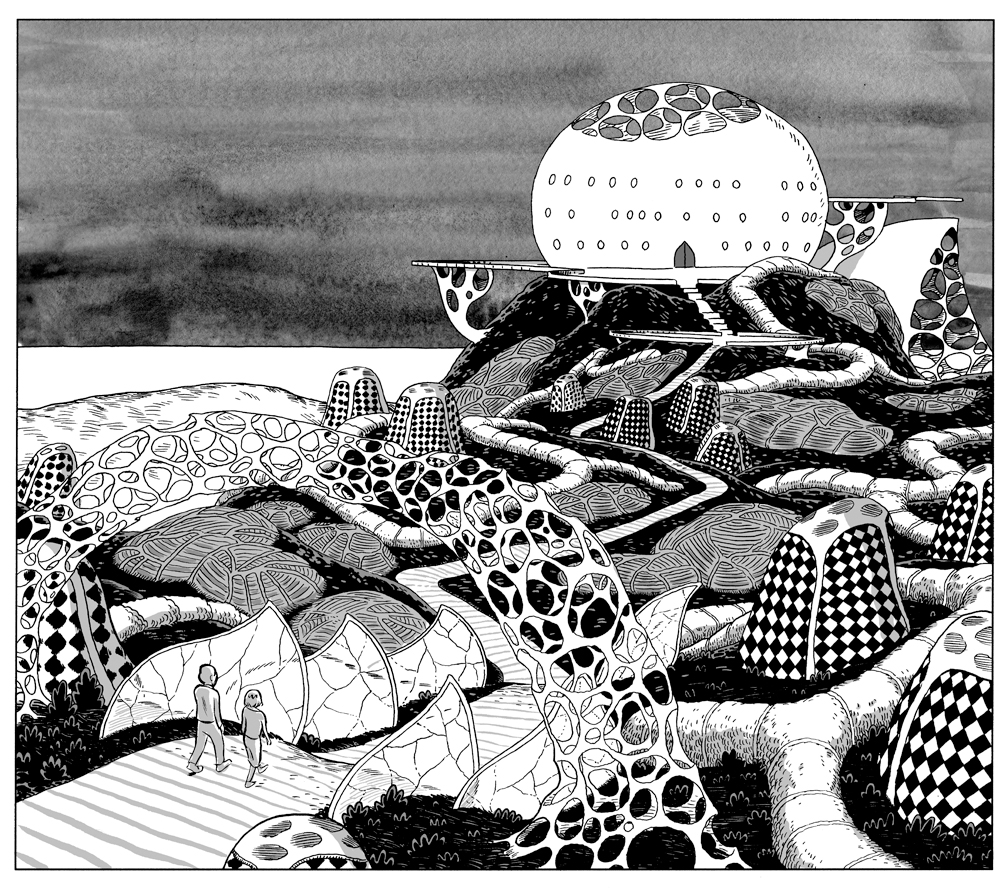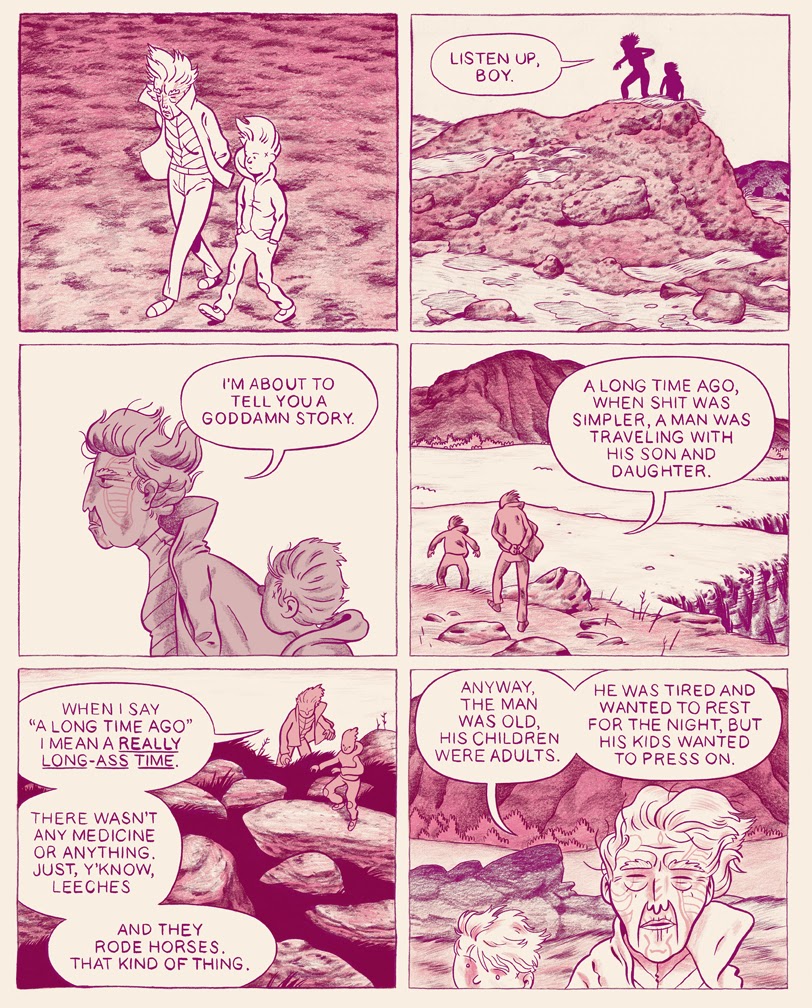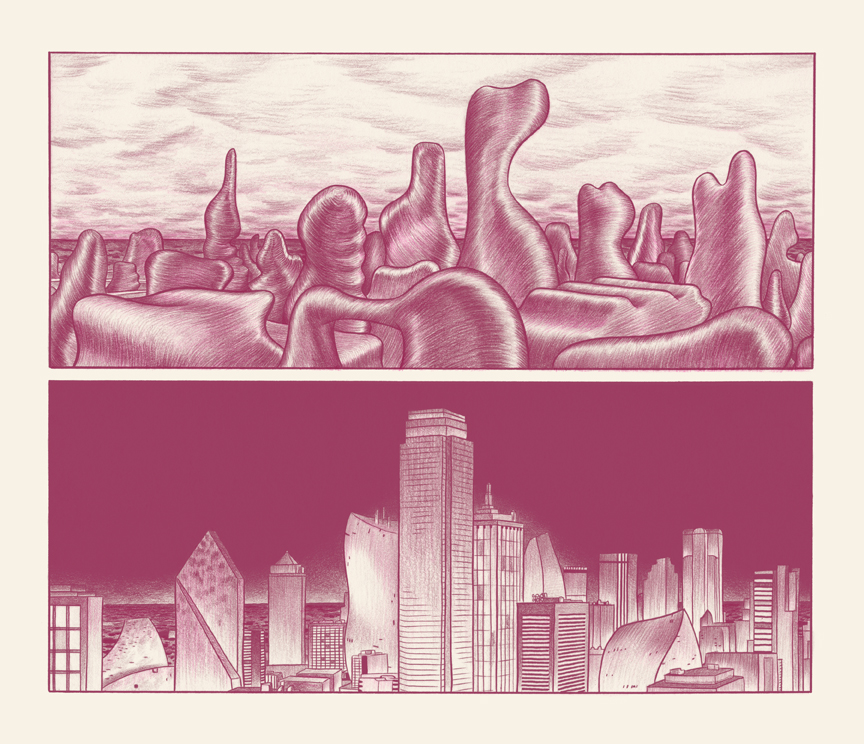An interview with Conor Stechschulte
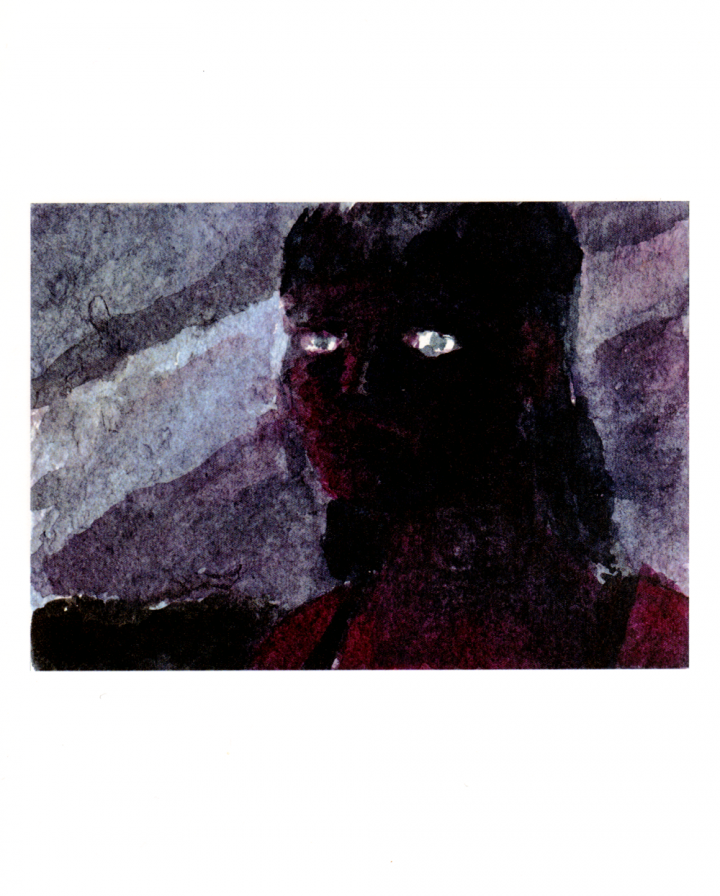
Conor Stechschulte is the author of The Amateurs, a graphic novel published by Fantagraphics in 2014, of Generous Bosom, a series for Breakdown Press now at its third installment, and of several self-published comics. Conor will be in Italy for BilBOlbul festival in Bologna, where he will have Il peso dell’acqua (The Weight of Water), an exhibition of his works open from 24th November until 20th December at the Spazio & gallery. And in the same days 001 Edizioni will publish I Dilettanti, the Italian translation of The Amateurs.
We asked some questions to Conor to introduce him to the Italian audience. The interview was conducted by e-mail between September and October 2017 by Gabriele Di Fazio, Elisabetta Mongardi and Alessio Trabacchini.
The Amateurs reflects your ability to introduce mystery in everyday life. The story seems to illustrate through the various characters (both in the main plot and in the frame) different ways to relate to the mysterious and non-rational aspect of existence. We don’t know if you agree with this interpretation, but we would like to begin this interview talking about your relationship with this element and how you think it can be communicated, displayed or evoked through art.
Fiction can help demonstrate ways to look sideways at what we’re experiencing. This is a great gift I’ve gotten from art and one I’m trying to pass on. Similarly, I really enjoy when I dream about something really banal – that I’ve moved a small object in my apartment or retrieved something from the car – and because it fits right in with reality, it’s like a weird boring time bomb that goes off with a light pop. It makes the rest of my day feel a little unreal. This just happened to me recently, I dreamt that I’d accidentally sent a bunch of pictures from my phone to a stranger and he’d replied simply, “Ha”. Several days after the dream I had a real moment of panic that this lightly embarrassing thing had actually occurred.
So, if dreams of objects from ordinary life are important for your art, it’s also true that the beginning of The Amateurs shows the opposite process, since something strange pops in everyday life. In fact the head found in the river kicks off a series of extraordinary events, as it happens with the severed ear found in the field at the beginning of David Lynch’s Blue Velvet. Your comics reveal the permeability between dreams and reality, but can you tell us more about how dreaming experience goes into your work? And do you look at some artists in particular who have taken this road?
I’d really like to lucid dream, though so far I’ve not had any success with it except in the early-morning time between hitting “snooze” on the alarm. I’ve come up with a lot of solutions to story problems and images in this space (one I can recall for sure is the final image from The Dormitory of the guy smoking in the basement window).
An author that immediately springs to mind on this subject is Jesse Ball. I had the privilege of advising with Jesse during my last semester at the School of the Art Institute this past spring and I just read Sleep, Death’s Brother, his book on lucid dreaming. He has much more interesting and useful things to say about dreaming than I do but I am especially excited by his idea of the dream-space as a training ground for the will; his book on dreaming is in fact intended for children and incarcerated persons for the exercise of the will under restricted circumstances.
Most of my favorite authors and artists have “taken this road.” Kobo Abe is an important favorite of mine, I’m thinking a lot about his book Secret Rendezvous in the most recent volumes of Generous Bosom. In his journals, Werner Herzog makes no distinction between everyday events and dream imagery (though he claims not to dream at night). The originating idea for The Amateurs sprung from a scene I read in his journals where he describes inept butchers on the banks of a river in Iquitos. In comics, I think that Olivier Schrauwen is a master of dreamlike/fantasy/subjective points of view and playing with the humor of their discontinuity with outside reality. Other important books/authors/artists for me in this vein are J.G. Ballard’s Unlimited Dream Company, Solaris by Stanislaw Lem, The Journey to the East by Hermann Hesse, Wind up Bird Chronicles by Haruki Murakami, Borges of course, Philip K. Dick, Apichatpong Weerasethakul, Tarkovsky, Lynch of course… And lots of others I’m forgetting.
The Fantagraphics edition of The Amateurs shows some differences from the first version you self-published in 2011. The most significant is the replacement of the hand-written introduction with a completely new storyline about two schoolgirls finding a man’s head in the river, the same river where they will perform a graduation ritual along with their classmates. Why did you decide to revise the original comic and how did you create this other storyline?
It started with simple dissatisfaction with the letter visually. It was one of the last things I had added to the comic and the more I looked at it the more unconvinced I was. A couple months after I’d self-published the book, I had the idea for that second storyline and thought, “Well if I ever have the chance to reprint it, I’ll include that”. So when the opportunity came along with Fantagraphics, it was one of the first things I did.
Animals have a key role in The Amateurs, they look strong and aware, while Jim and Winston, the two butchers who are the main characters of the story, are weak and confused. This, and the use of brutal violence in some sequences where animals are considered only as food, seem to imply a condemnation of eating animal meat. It should be interesting to understand if you wanted to convey a sort of “message” or if the interpretation is more metaphorical.
I made Jim and Winston butchers because it’s a profession that deals intimately with death. I wanted to talk about how people, rather than reckoning with death, will externalize it and locate it in the body of another, this always leading to harm on both sides of the equation.
That said, at the time I made the book I’d been a vegetarian for twelve years. I’ve since starting eating meat again. Haha, not sure if that shines any kind of light on the content… If someone were to decide become vegetarian after reading the book, that’d be great.
While reading The Amateurs, the impression is that the gender of your characters is not randomly chosen. In addition to some obvious hints (the all-girls school, the two customers…), all the animals that at some point rebel against humans are female (the sow, the mare, the cow), while the male are somehow more subdued (the pig walks into the slaughter of its own accord; the turtle gets tortured in the woods). It also seems like whatever the sinister power of the river is, it doesn’t affect women: they bathe, wash their clothes and make rituals in it, and nothing seems to happen to them. On the other hand, when Winston and Jim go into the water, they get literally shredded. There is also a scene where Winston – right after he has grinded his own fingers – yells at the two customer, saying he won’t put up with a woman telling him his work is not good enough. Not to speak of the fact that he remembers the two customers dressing him up as a girl when they were all kids. It seems to me that your book is filled with subtle references to men-women relationships (or to the general opposition between masculinity and femininity). Was that intentional or we are overthinking it? And does the river have anything to do with the representation of femininity in your book?
Thank you for such a close reading. You’re absolutely right that, at least in terms of my intentions, gender was a primary thing I was trying to address.
At the risk of over-explaining and squeezing out better and more interesting interpretations, I’d say that The Amateurs is an attempt to lampoon, ridicule and take apart (literally, haha) the idea of self-reliant, non-relational masculinity – the man who has all the answers. This is the character that Jim and Winston try to perform for the women in the book.
A huge influence on The Amateurs was the book Flesh of my Flesh by Kaja Silverman. She argues for replacing the Oedipus myth with the Orpheus myth with regards to gender – a story based on mortality rather than castration. She says our mortality allows us to relate to one another analogously, through our resemblances rather than metaphorically which always presumes a hierarchy. I was trying for a lot of these ideas and borrowed imagery from the Orpheus myth (i.e. the head washed up on the shore).
Thank you for pointing out this pattern in the gender of the animals, I don’t think I consciously set that up. I think a similar sort of pattern is emerging in Generous Bosom as well, where the main character and “Hero” of the story is actually very passive.
As for the water, I think of the water as being representative of an ecstatic/transcendent/undefined state rather than being specifically gendered.
Water, of course… It is a recurring element in your comics, and sometimes plays a major role. It may be the ritual river in The Amateurs, the rain from which the facts of Generous Bosom develop, the lake of impalpable but sharp tensions in Glancing, the sea where the games of Water Phase unfold, and Christmas in Prison’s narrative stream. If we consider water as a symbol, it is necessarily multifaceted, fluid, and seems to be related to desire, change, epiphany. It is the place where things happen, stories are told, secrets come to light. Why is water so important to you?
Thank you for tracking this image so comprehensively throughout my work! You’ve done such a good job of outlining how I’ve used water that I’m not sure if I can add anything…
Of the symbolic meanings you’ve listed I identify most with the idea of change. Water is a place where boundaries break down, things dissolve, definitions shift.
With how clear and declarative one must be in telling a story, especially with comics (here’s a guy, now here he is again, see? He’s wearing the same shoes and hat, except now he’s dropped his umbrella, and here he is again but now he’s bending to pick it up), water provides a needed space for vagueness. It’s a place where the closure occurring between each panel might be suspended (or maybe it’s a way of depicting that no-space in between). You can draw a clean, clear black-outlined character for most of your book but if you reflect the same character in a bowl of water, their lines go all wavy. They can be different.
This confirms your are constantly looking for new ways of telling a story. For example another rule-breaking work is your most recent one, Tintering, where you didn’t draw characters but you told the story of five self-taught artists using different broken objects, with the single panels very similar to each other, while the content is mostly developed with text balloons. How did you come up with this, and why are you focusing your attention on objects?
The subject matter for the comic all came from an art history class I took which was taught by Lisa Stone, who is an incredible, generous, brilliant scholar on the subject of self-taught and vernacular artists. The way a lot of these artists related to objects was different from how we do (or must) in everyday life. Kea Tawana, for example, meticulously and respectfully took apart these old buildings in Newark. She had immense sensitivity to craftsmanship and couldn’t stand to see good materials go to waste. Much of the work of self-taught artists serves as a response to our culture’s massive generation, disregard and waste of objects.
I was originally thinking the comic might look like some of the stuff that I’d made for Christmas in Prison, with a character sort of delivering a monologue to the reader. I drew a guy standing behind a tree and then I thought maybe he’d reach out and break a branch off. Then it seemed more correct for the broken branch to talk. Most of the stories of these artists begin and end tragically – they undergo a loss, they make something beautiful which is itself destroyed. It seemed right that something broken would tell those stories and that they’d speak from the site of their injury.
In Generous Bosom, one of your recurring themes is explored thoroughly. We could call it “voyeurism” but it would be simplistic, it is a permanent question about “who watches” and the dynamics of watching. This theme can be found in a lot of your books and is essential in the self-published short story The Dormitory. But who is the real voyeur in your comics, the author or the reader? Or who else?
This is a tough question to answer succinctly. Mostly because it’s still an open one for me since I’m still trying to work these things out…
I don’t think anyone gets to just watch anything without, knowingly or not, participating or altering whatever it is they’re watching. I’m not sure if I can say who is the “real” voyeur.
Maybe comics are based on the fact that the act of watching affects the things you watch at. Can you tell us about your experience as a reader? How do you like to read/watch comics?
I think you’re right. In a comic, there’s no escaping the fact that whatever is on the page was put there by someone and through the act of drawing there’s no difference between what is seen and how it is seen.
That said, on the reading side of it I really like that comics are an elective medium. It doesn’t happen to the audience the way movies do, the audience/reader is the one who animates the action. To answer the question above, I think Generous Bosom is about this dynamic in the reading of comics – that you can pretend that you’re watching something happen both as the reader and creator but in actual fact you are making that thing happen.
I like reading comics over and over. I like that it’s a medium that allows and encourages this; it’s always easy to find a favorite scene again, because there it is. I like that in reading a comic you can go very quickly from the what to the how of a story. The density and depth of really good comics are immediately accessible.
So, this is your idea of reading comics, but what about making them? Your work finds a unique and original way to balance flow and structure, and it is very difficult to understand where you started, if from the plot or from the drawings. Glancing, a work based on the juxtaposition of wordless watercolors, could be an excellent example. What is your idea of comics and narration?
Thank you! I think my idea of comics and narration may go back to your earlier questions about water and the mysterious or irrational arriving in the everyday. Structure = The Everyday = The main narration of a comic/ consistent drawings/ Clarity, while Flow = Mystery = Water/ Change/ Irrationality.
With comics, I’m trying to get things across, to tell an actual story and to do that you have to establish rules that the reader can follow and rely on (I think this is what you mean by “Structure”). These rules start to stack up and can very quickly become impediments to freedom and to feeling like there’s possibilities in the world I’ve created which is where the energy to make more story comes from. At this sort of point it’s time for me to change the rules, insert a different story with different rules, or to maybe work on another project with different or as-yet-undecided rules.
Making Glancing felt very fun and active in this way where I made three or four drawings and then could make more drawings in between those drawings, or after them, or before. I could look at the whole thing laid out on the floor and get a feeling for it comprehensively. I want to make more comics this way.
Another reason of interest in your work is that you generally avoid the opposition between narrative and non-narrative comics – and between fiction and poetry comics – alternating the two approaches or demonstrating their substantial identity in the medium. Do you agree with this perspective?
Thank you again! Yes, I think this also relates to the answer above. I might add that decisions about the structure, whether something is “poetic” or “narrative”, etc. are made by tracking my own excitement about what I’m working on. Bringing in something mysterious/ poetic/ irrational/ non-narrative is often a solution to my becoming bored with a portion of a story or wanting to skip over a part that doesn’t feel compelling to make or to read.
Your work considers both the literary comics developed in the ‘90s and the formal experimentation diverging from the standard of the “graphic novel”, such as Fort Thunder and the output of “art comics” in general. But what is your background? And we aren’t talking only about comics, obviously.
My most important influence is the group of friends that I found at the Maryland Institute College of Art, the folks that made up the Closed Caption Comics group. We all sorted out how to make comics together at a young age. This was exactly the same time that PictureBox was starting up and a lot of the stuff surrounding Fort Thunder was coming to light and that was perfect for us – the immediacy of that work and how it was really visually-oriented spoke to us. Kramers Ergot 4 & 5, the old Fort Thunder Website and meeting CF and Brian Chippendale at SPX gave us all the sense that this was an art world that we could find a place in. And for a good while, I’d say that was about the size of the art world I cared about, it was my circle of friends and those couple guiding lights outside.
Other than that, growing up in rural Pennsylvania has had a huge influence on the imaginary worlds of my books. I also read a lot of literature. I just finished a master’s degree at the School of the Art Institute of Chicago… But are you more interested in my education/influences or in my biography?
Especially your influences, but also your biography, to the extent that it has influenced your work…
Beyond Closed Caption Comics, I’ve been involved in other collaborative art projects that have had a huge impact on my life. Shortly after school, I helped to found the Open Space gallery in Baltimore. We curated shows, held performances, established a zine library and put on a publications and multiples fair. I’m also helping to organize the first Chicago Art Book Fair here.
I was also in a band called Witch Hat for seven years which I started with Noel Freibert and Lane Milburn. Lane left the band after three years and Chris Day joined. Chris and I are in a new band called Lilac with Anya Davidson and Kenny Rasmussen here in Chicago (Chris and I moved here at the same time). When I got involved in the underground comics scene, there was a lot of crossover with the underground music scene. I met lots of musicians through comics and lots of cartoonists through music.
Do you think your art or your approach to art changed since you moved from Baltimore? Chicago has a big comic scene and a long tradition of contemporary art, we can think to Hairy Who first of all but there is probably much more we don’t know about in Europe.
My art and my approach have definitely changed a lot since moving from Baltimore. I’ve been in school the last two years, so just being exposed to tons of new work and people and ideas has been totally invigorating and overwhelming. I think I’ll be digesting all of it for years to come.
On a basic, lifestyle level, moving here and attending school has allowed me to stop working a non-art-related day job (at least for now). That’s a great gift that I didn’t previously think was within reach for me. I think I’m now more dedicated to the idea of trying to make, or at least to make and to teach, art full time.
As for Chicago, it’s an amazing city for cartoonists. There’s a beautiful supportive community and stuff like the Zine Not Dead reading series run by Matt Davis and Brad Rohloff which carries on the tradition of performative comics reading started by Lyra Hill with her Brain Frame series. I mean just in my neighborhood I’m about five blocks away from a house where Anya Davidson, Lane Milburn, Margot Ferrick and Andy Burkholder all live (Edie Fake used to live there in the attic). A couple blocks in a different direction are my dear friends Molly O’Connell and Chris Day – both of them with beautiful diverse practices that include but aren’t limited to comics and bookmaking.
The Complete Strange Growths 1991-1997
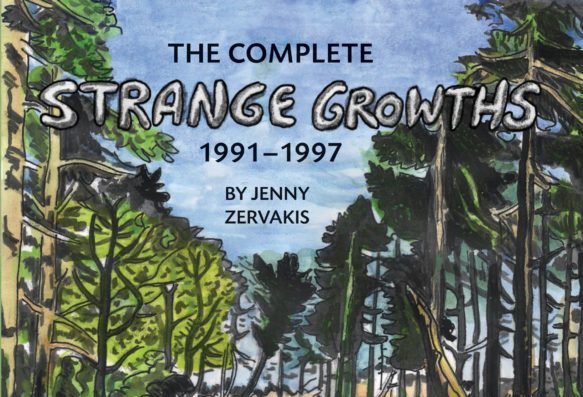
Tra la pubblicazione dei primi numeri di Eightball, il debutto dell’Hate di Peter Bagge, la nascita della Drawn and Quarterly con il lancio di serie regolari a firma di autori come Seth, Chester Brown e Joe Matt, il periodo a cavallo degli anni ’80 e ’90 ha segnato una notevole rivoluzione per il fumetto nord-americano, trasformando definitivamente il concetto di fumetto “underground” e “indipendente” come era concepito fino a quel momento. Innanzitutto le storie di questi cartoonist si proponevano con un linguaggio nuovo e meno autoreferenziale rispetto al passato a un pubblico più vasto, e in secondo luogo alcuni di questi autori uscivano dagli schemi abituali del fumetto “alternativo” come veicolo di contenuti esclusivamente anticonvenzionali, sarcastici, iconoclasti, provocatori. Se la qualità di quel materiale rimane uno dei vertici raggiunti dal fumetto nei suoi tanti anni di storia (almeno dal limitato punto di vista di uno che quella “roba” ha cominciato a leggerla in piena adolescenza, rimanendone irrimediabilmente colpito), è doveroso dire che gli autori citati in precedenza non erano gli unici a portare nuova linfa nel panorama del fumetto a stelle e strisce. Sotto, nel più profondo dei mondi della micro-editoria di cui in Italia poco si sapeva nell’epoca pre-internet – a meno di non incappare in una pubblicità o addirittura in una recensione su The Comics Journal – si muovevano una serie di autori misconosciuti che consapevoli della rivoluzione del do it yourself applicavano i principi produttivi del punk alle loro esigenze, dando vita alla cosiddetta “zine revolution”. Tra questi una delle prime fu Jenny Zervakis, chicagoana di origini greche che nel 1991 cominciò a autoprodursi la fanzine Strange Growths, “strana” come il titolo suggerisce per il modo in cui mette in pagina senza mediazioni racconti autobiografici, aneddoti raccolti sull’autobus, poesie scritte a macchina, ritratti degli abitanti del quartiere, dettagliate descrizioni di sogni, diari di viaggio, riflessioni, saggi in forma di fumetto, disegni di animali, piante, giardini. Il tutto rappresentato con uno stile che definire scarno è poco, dato che la bozza, l’approssimazione, la semplicità erano conseguenze dirette dell’urgenza espressiva, e la ricerca della perfezione formale o della bellezza semplicemente non interessava.
Dei primi 13 numeri di Strange Growths è uscita da poco una raccolta assemblata da John Porcellino e pubblicata dalla sua Spit and a Half, prima opera di un altro autore che esce per l’etichetta (e distribuzione) dell’autore di King-Cat Comics. La scelta non è casuale, perché la Zervakis è stata una fonte di ispirazione per Porcellino e per tutto il movimento dei comics as poetry. “I suoi fumetti sembravano come una trasmissione da un altro pianeta – scrive l’editore nella sua introduzione al volume – un mondo di ironica compostezza, suggestione poetica, raffinata capacità di osservazione, a volte caldi e altre freddi, oppure tutte e due le cose insieme. Forse non c’è bisogno di dirlo, ma per chi non conosce i fumetti che venivano pubblicati in quegli anni, non c’era niente di simile. Mentre la gran parte dei fumetti “alternativi” dell’epoca erano chiassosi e sarcastici, quelli di Jenny erano calorosi, emozionanti, sinceri e sorprendentemente complessi”. “Jenny Zervakis – aggiunge Rob Clough nell’intervista all’autrice che chiude la raccolta – è nata nel 1967 nel West Side di Chicago, e fa parte di una generazione di artisti che reagì alla prima ondata di cartoonist alternativi dell’inizio degli anni ’80, oltre che di una cultura legata al punk, alle fanzine e al do it yourself che è esplosa con la nascita del desktop publishing. Le sue attente riflessioni e la propensione a rappresentare l’immobilità sulla pagina furono tra i primi esempi di comics-as-poetry”.
Come accennato, nel volume troviamo tutto il ventaglio dell’offerta della Zervakis, che alla molteplicità degli argomenti e dei toni unisce varietà nella composizione della pagina e nella costruzione dei diversi pezzi. Le storie non sono mai banali né ripetitive, anzi esprimono voglia di sperimentare e curiosità nelle mille possibilità del medium. I testi ricchi di passaggi poetici e di consapevolezza letteraria fanno capire chiaramente che la Zervakis è più scrittrice che disegnatrice, ma sua è anche una notevole capacità di mettere in scena inquadrature e soluzioni stilistiche “sorprendentemente complesse”, come scriveva Porcellino nell’introduzione, oltreché di regalarci alcune tavole più dettagliate e intense delle altre, soprattutto quando la natura diventa la vera protagonista della rappresentazione. I risultati migliori sono raggiunti quando il particolare, apparentemente insignificante, diventa occasione di riflettere sull’universale, catturando la poesia e anche la complessità delle piccole cose con una scrittura lirica, pregnante, emozionante: Passing Time è il ritratto di una donna anziana intenta a lavorare a maglia (She sits knitting as if she is done living her life and instead pours herself out, stitch by stitch, into some future generation / She has grown her hair, plaited on her head, past any usefulness, past admiration of its beauty to the sheer oddity of persistence), in Silent Passenger una coppia torna a casa di notte mentre la donna (con tutta probabilità la Zervakis stessa) viene colta contemporaneamente da meraviglia e insicurezza (Coming home it was 2 AM beautiful / Someone’s singing / It’s only humans that make music for the sheer joy, the need of it, maybe so / I wish I could seduce you, all over again), Chuparrosa guarda al mondo animale per riflettere sulla vita umana (Sometimes I feel there is a world beyond our petty concerns / While I sit, consumed with my thoughts and worries, birds fly overhead through the rows of backyards). The Complete Strange Growths non è soltanto un pezzo di storia del fumetto autoprodotto statunitense ma anche una lettura appassionante, uno sguardo su un mondo intimo e personale capace di trascende la cronaca del quotidiano per emozionare ancora, a distanza di oltre vent’anni.
Misunderstanding Comics #9

Iniziamo questa nuova puntata dell’usuale ma aperiodica rubrica di segnalazioni varie con Steam Clean, un volumetto brossurato di 84 pagine a firma Laura Ķeniņš, cartoonist metà lettone e metà canadese di cui avevo già segnalato l’ottimo mini-kuš! #42 Alien Beings. Con questa nuova uscita, stavolta targata Retrofit Comics, la Ķeniņš conferma quanto di buono fatto vedere in precedenza, trasformando una situazione apparentemente ordinaria come una sauna tra donne in una meditazione sull’identità di genere, la sessualità, i rapporti interpersonali, il conflitto tra tradizione e modernità.
La rappresentazione tutta colori pastello dell’ambiente nordico e la regolarità quasi schematica delle vignette restituiscono un’atmosfera rilassata, in cui sembra di percepire con le nostre orecchie il silenzio di sottofondo. E neanche i dialoghi fitti rompono questa sensazione di pace, inalterata persino quando si esplicitano tensioni nascoste ed emerge un’aura di sovrannaturale mistero, con un’apparizione divina e spiriti dai contorni naif che aleggiano tra i fumi del vapore. La Ķeniņš propone ancora una volta un cartooning consapevole, rigoroso e maturo, capace come pochi di raccontare personaggi in una fase di transizione. E anche di farci sentire lassù, in quella sauna tra i boschi.
Se il volumetto della Ķeniņš sembra ricordare i film del norvegese Bent Hamer, il secondo numero dell’antologia-libro Mirror Mirror edita da 2d Cloud guarda a tutt’altro immaginario cinematografico, come la presenza di alcuni contributi a firma Clive Barker lascia intuire. Sotto la cura congiunta di Sean T. Collins e Julia Gfrorer, il volume mette in fila 230 pagine di fumetti e illustrazioni incentrate su un’idea di orrore legata al quotidiano, al corpo e infine alla pornografia. Eccellenti premesse dunque anche se l’antologia è appunto… un’antologia, con i suoi alti e i suoi bassi, e una buona metà dei lavori che risultano piuttosto ordinari, per niente disturbanti né trasgressivi come lascerebbe intendere il progetto, nel complesso troppo pretenzioso rispetto a quanto proposto. Nonostante ciò, di cose buone qui dentro ce ne sono eccome, per esempio il solito subdolo horror delle meschinità umane a firma Josh Simmons – particolarmente a suo agio con i campi lunghi, quasi a sottolineare anche graficamente l’abituale distanza emotiva – oppure Black Flame, un racconto in cui ritroviamo la Megg di Simon Hanselmann alle prese con il suo “lato oscuro” e che è l’occasione per vedere l’autore australiano confrontarsi al tempo stesso con testi altrui (Sean T. Collins) e con un bianco e nero massimalista fatto di pennellate ben più corpose del solito. Al Columbia (con i suoi Pim & Francie), Uno Moralez, Noel Freibert e Dame Darcy danno a loro volta un notevole contributo, pur attingendo ispirazione al loro rispettivo e usuale canone.
E veniamo a una nostra vecchia conoscenza, cioè Noah Van Sciver, che è tornato di recente al suo personaggio Fante Bukowski pubblicando per Fantagraphics il secondo capitolo delle sue avventure, séguito del debutto del 2015 tradotto in Italia da Coconino. Come lascia intendere lo pseudonimo che si è scelto, il protagonista è uno “scrittore” che vive nelle camere di hotel e usa ancora la matita o al massimo la macchina da scrivere, va con le prostitute e beve solo per darsi un tono. Fante non ha nessuna voglia di scrivere e soprattutto non ha talento: la sua missione è raggiungere lo status di artista, essere amato e invidiato dagli altri come lui invidia i “colleghi” che ce l’hanno fatta. Se la prima uscita originale ricalcava il formato romanzo tascabile, la seconda amplia i centimetri e sceglie una grafica retrò in odore di anni ’60, mutuata dall’edizione Black Sparrow Press di Factotum.
Ma soprattutto se nella prima parte si sorrideva, in questa si ride di gusto, e a me è sembrato di non divertirmi così tanto dai tempi dell’Hate di Peter Bagge, pietra miliare dei comics anni ’90 uscita sempre per Fantagraphics. Vi anticipo solo qualche gag iniziale per non rovinarvi troppo la lettura, come quella in cui Fante rompe una matita in due perché è “troppo gialla” e non riesce a concentrarsi sulla scrittura. E il capitolo in cui decide di pubblicarsi una fanzine di poesia (“Sì, sarò l’editor! Sarò il boss! Accetterò tutte le mie proposte!”) è esilarante. Il trasferimento del protagonista da Denver a Columbus sembra anche autobiografico, ma poi a un certo punto ecco spuntare l’autore in carne e ossa, vittima di una divertentissima auto-parodia, nonché rivale in amore di Fante. Sullo sfondo, e neanche troppo, si muovono riflessioni sulla scrittura, il successo, l’ambizione e la vanità che non lasciano affatto il tempo che trovano, rendendo questo Fante Bukowski Two una delle migliori prove a firma Van Sciver.
Quando viveva a Denver, Van Sciver lavorava da Kilgore Books, negozio di libri e fumetti che è anche una small press dedita alla stampa di mini-comics e non solo. Prodotto di punta è il Kilgore Quarterly, antologia tutt’altro che quadrimestrale uscita di recente con un settimo numero molto più ricco del solito, nascosto dietro a una bella copertina di Jason (rilettura di Le Mal du Pays di Magritte) e come sempre a cura del padrone di casa Dan Stafford.
Il volumetto, che propone in parte storie già pubblicate altrove o di prossima pubblicazione, si apre con Dappled Light di Summer Pierre, una storia di 5 pagine leggera e al tempo stesso malinconica, ritratto autobiografico di una bambina che grazie al fumetto può finalmente rifugiarsi, in senso letterale, nel mondo dei vecchi telefilm. Si prosegue con la solita intervista scritta a mano (vezzo di Stafford da sempre, come testimonia la raccolta I Hope This Finds You Well con interviste a Crumb, Tomine, Bagge ma anche a Ian MacKaye, Doug Martsch, Dan Fante e altri) al cover artist Jason e si raggiunge l’apice con Steve McQueen Has Vanished, storia “vera” della sparizione dell’attore raccontata con il solito dettagliatissimo stile da Tim Lane, anticipazione del prossimo lavoro dell’autore di Happy Hour in America e The Lonesome Go. Dopo una inaspettata quanto sintetica chiacchierata con Grace Slick, si passa a un più canonico ma validissimo pezzo underground di Joseph Remnant, tra sfighe quotidiane e ricerca dell’amor perduto, dunque ecco Sam Spina con quattro divertentissime pagine metanarrative che vedono il suo alter-ego pesce alle prese con app e sesso occasionale, e infine la riproposizione di un fumetto di Leslie Stein, The Desk, già uscito in formato mini per Oily Comics e forse il contributo meno significativo del lotto. La terza di copertina è dedicata a qualche nota autobiografica nel solco della più piacevole tradizione del self-publishing a stelle e strisce, a ricordarci che di antologie così curate e con un feeling do it yourself ne vorremmo ancora e ancora.
PopOok! An interview with Hamo Bahnam
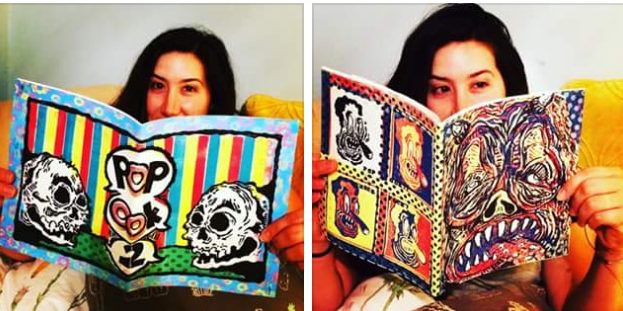
PopOok! is a Los Angeles-based zine self-published by Hamo Bahnam since 2012 and now arrived at its fourth and recent issue. When Hamo introduced me to his project, I wasn’t aware of it and I think a lot of other people really into self-publishing, zines etc. still don’t know about Pop Ook!. In fact, in a world where you can find almost everything on the social networks and in a scene where every cartoonist knows his peers, PopOok! is an exception, the kind of publication that can’t live anywhere else but on paper and whose creators don’t aggressively promote it, because they simply want to do it, without caring too much about the audience’s acceptance. Inside the issues of PopOok! there are very different contents: comics looking directly to the underground revolution like the ones created by Bahnam, the strange cartoons of Rusty Jordan already known for Alamo Value Plus published by Revival House Press (I talked about it on the old website), the nightmares of Marcel Dejure and the “wet dreams” of Yara Zair. And then collages, illustrations, inserts on colored paper, plus a cd of ambient-noise-experimental rock music coming with every issue. All this comes wrapped up in hand printed covers. Not every page is completely accomplished but there is a feeling here of something going on, a love for the subject matter that isn’t related to self-realization but only to real love for comics, music and illustration. I’ve talked about PopOok! with its master Hamo Bahnam in an interview conducted via e-mail in the latest months.
The first issue of PopOok! was published in Spring 2012 but you made comics long before. Can you tell me when you started to create comics, where you published them and how the idea of starting PopOok! was born?
Comics have always been a big part of who I am as an artist. Not really as a fan knowing the hippest books and artists but as an aesthetic, a way of working. I’m more interested in music as a fan than I am in any kind of art. But my wanting to be an artist comes from buying my first copy of Mad magazine when I was 10 years old. I put out my first comic in 1994. I called it Grow Up! (comix and funnies). That first comic was a precursor to what I’m doing with PopOok!. The idea that I could publish my own comics and zines came out of the punk/hardcore culture I grew up around. Comics and degenerate music have a long history together. From 50’s horror comics and juvenile delinquents listening to rock’n’roll to the 60’s underground comix and psychedelic music to punk (Punk magazine’s John Holmstrom and Gary Panter) to 90’s garage and even noise music has artists and cartoonists involved. Low forms of culture breads other low forms. In the early 90’s met two artists, Amos and Marcel Dejure, who were publishing books under the No (Know) information Network. They published me first in their HO! Comix. They hooked me up with other artists and that’s where the idea of Grow Up! came from. I stopped making comics for a while and concentrated on painting and printmaking, however, comics were usually a theme in the format I was working in. Around 2005 I started making comics again for a leftist newspaper in Knoxville TN. The comic came out twice a month. It was called Juicy Pork Head. About a corrupt industrialist named Harry Bowels, who hypnotized children into killing their parents, then turned the dead parents into ice cream. That scenario would fit into todays’ political climate quite well actually.
I started PopOok! in 2010 when I moved back to Los Angeles after being gone for 12 years. I needed an artistic direction and a focus after separating from my ex-wife. I met Meredith Wallace who was a co-worker with me at a local library. We began talking and it turned out she had a small zine distribution company. She eventually became instrumental in starting the L.A. Zine fest and I just figured this would be a great moment to start making comix again. I invited some old friends to contribute and met some new folks and Bingo! PopOok! was born. I took what I learned from years of printmaking, comix reading and my love for music and now I’m working on a fourth and fifth issue.
The zine is “a lack of Product production”, while the music cds coming with every issue are credited to Plastic Factory Records. Are only you behind these labels or there is someone else?
Yes, it’s just me behind those labels. Artist and musicians send me their work and I put it all together. I create comics and music too then I assemble the whole thing, I hand print the covers then cut, staple or glue. I’m the owner/publisher/editor/labor and janitorial staff. But I couldn’t do it without all the talented people who contribute to it. I make enough money from sales to cover my costs and the contributors get no salary. They do it for free and I guess they trust me to make a product they can stand behind. I love them all for believing in this project.
And so, how you select these artists? Are they people you know in the “real life” or you contact them on the internet? Because, seeing it from the outside, PopOok! seems the expression of a scene and it could seem a zine of another time, when social networks still didn’t exist. I don’t see in it “famous internet people”…
Most of the people involved are friends and acquaintances that I’ve known for some time. Some of these friendships go back 20-30 years. Others I’ve just recently met because of my doing PopOok! Or friends at work who are creative types. Some people I meet at zinefests and music spaces where I see/hear their work or they see mine. And also others are people I’ve never met that I have admired their work from seeing/hearing it on the internet. As far as a “scene” goes most of the artists/musician have never met each other! Some do know and are aware of each others work but it’s mostly a scene comprised of many cities and countries and PopOok! provides the glue that binds them together.
What are your inspirations both as an editor and as a cartoonist? Ok, you were influenced by Mad magazine but I guess you also love the underground comics from the 60’s or the 70’s, because most of the works in PopOok! can rememeber Zap Comix and sometimes they have a psychedelic style or a punk feeling. On the whole your zines seem a sort of “old school” work, as if the people who created them love the classics while they aren’t really interested in the latest tendencies of cartooning. And this is pretty strange in a world where everything looks like something else…
Yes, Punk and Underground Comix culture are two big influences on me. As a cartoonist my influences are many and they are one’s that I’ve held on to for a long time. Robert Crumb is godhead to me. He’s just an incredible talent and genius that changed me forever. Of course with Crumb comes the Zap artists: Clay Wilson is fantastic as well as Gilbert Shelton. The Harvey Kurtzman years at Mad, especially the cartoonists Will Elder and Jack Davis. Later Mad artist Don Martin was a childhood favorite only replaced when Crumb walked into my life. George Herriman and the absurdity of Krazy Kat. I love absurdity in everything! And also the raw energy of Savage Pencil and Gary Panter are always present for me.
As an editor my two influences would be Robert Crumb and Art Spiegelman. Crumb’s embrace of punk cartoonists and punk culture when he published Weirdo plays a huge part on me with PopOok! And Art Spiegelman’s RAW magazine is great too. The multifaceted aspects of Spiegelman’s work is top notch. As an editor my influences do come through in the contents of the comic and music cd. I think the old school aesthetic comes from my age and what I grew up on. I’m old enough to have been alive for those things to be new. Those artists are my teachers.
Another feature of the zine is that every issue is very “physical”, the packaging is really accurate and there are a lot of inserts, you use different paper colors, the covers are mostly printed using linoleum blocks and hand stenciling, and one is silkscreened (#3). These are books you absolutely can’t read as a PDF…
Right. And that goes back to Spieglman’s Raw. I have a copy of #7 where he tore a piece of the cover off and taped it to the inside. And the original chapters of Maus where printed and stapled inside the bigger comic as a mini book. So that playing with the medium, how he deconstructed/tore-apart comics is fascinating to me. I’m also a printmaker and make assemblage paintings so the physical object is very important to me. The human artifact speaks to me and the need to touch things to have an actual experience with art is what I’m going after. I’m strictly a 20th Century boy. PDF comics are bullshit.
Would you like to present to the readers of Just Indie Comics some of the cartoonists you’re working with for PopOok!?
Sure. All the artists are worth mentioning and there are so many but we can talk about some of them.
Alex Chiu and Rusty Jordan are two artists I met while they lived here in Los Angeles. They both moved up to the state of Oregon a while back. Alex is a prolific artist who creates complex, fanatical drawings in a crazed, almost a free associative, doodle style. He not only paints, teaches, does comics, runs a small publication press called Eyeball Burp but also is creating illustrations for children’s books all while having a YouTube cooking show with his daughter!
Rusty is a cartoonist whose work features characters who remind me of the people that occupy the world of writer Bohumil Hrabal. With absurdist, lonely yet loveable “everyman” losers in a very American setting. Rusty is a sign painter by trade but also publishes comics. I first saw his work in a collaborative comic named Moulger Bag Digest. He also puts out Alamo Value Plus and created the anthology series Shitbeams on the Loose.
Marcel Dejure and Amos. Marcel’s comics are claustrophobic punk rock acid trips. Roller skaters, burnouts, porno queens, meth-heads, drugged out animals and other Los Angeles dissidents make up his transgressive world. Marcel rarely makes comics anymore but when he does they’re for Popook! He spends countless hours working on a fashion line of clothing that combines the erotic with cartooning. He’s also the creator of the live puppet performance group Cinnamon Roll Gang.
Amos’ work mixes dystopian landscapes with bebop jazz and drugs. He loves his cats who once in a while make it into his comics. I’ve been a great admirer of his work for many, many years. He’s a printmaker as well and has worked for the legendary print collective Self-Help Graphics in East Los Angeles.
David James-Dimitrov is a Canadian cartoonist and painter. I met him online and he sent me copies of his incredible no text comic A Sunburned Heart in the Skin Celled Desert. His work is incredibly detailed and lovingly rendered. Science fiction dream stories… Mixing a weird combo of Twilight Zone and Alejandro Jodorowsky.
And what about the musicians?
Bryan Davis makes music as Bleeding Gorgon. I first met Mr. Davis in Knoxville, Tennessee when he was video taping my band for his public access show Kill Your Television. An artist and filmmaker, I never knew he made music until he submitted some prerecorded, phone called, industrial noises to the first PopOok! His more rockin’ tunes are a combination of the bands Chrome and the Humpers. He writes songs of loss, rejection, abandonment and loves horror movies and punk.
In the years 2005-2011 Grant Capes co-ran the alternative art/music space Echo Curio in Los Angeles. The Echo is where the seeds of PopOok! germinated as I met artists and musicians that would fill the pages and sounds of the comic/cd. His current project is Borne on a Train, a podcast series where he showcases live performances from some of Los Angeles’ premier experimental musicians. He has contributed to the first four issues of PopOok!, mostly under the Sleepwalkers Local moniker. Sleepwalkers Local is an improv situation involving Grant and whatever instruments are about. The set of songs included in the new issue of PopOok! comes from an old piano and a newly acquired harmonium and chord organ all processed for your enjoyment.
I’ve been waiting a long time now for Charlie Finch (Professor Husband) to release the vinyl debut of his The Diamond Trip multimedia project. A bit ambient, a bit spacerock, some motoric and krautrock via the American South whatever it is it’ll be monumental! Charlie is a musician and graphic designer living in Knoxville, Tennessee. The Diamond Trip consists of the Electric Jeanni and Professor Husband, who play music and visuals. They say some influences include birds, grains, grass, ghosts and mirrors…
Another Knoxvillian, Jason Bowman, is the first person I ever knew who made music with a sliver mac. A musician, filmmaker and artist, he is amassing a warehouse of “library” music: incidental soundtracks for all your living pleasure. I’m always looking forward to hearing what he creates.
Mark Cannariato is an artist and sound maker from Brooklyn, NY. I first encountered him in the swamp hell that is Tampa Florida. All black rubber and wood assemblage. Imagine yourself in the last trek of Disneyland’s train ride through the primordial landscape. Giant mosquitoes buzz passed your head in the sweltering heat and the natives are restless… all set to a crazed beat created by the roar of the train.
I’ve yet to meet Maria or Dylan, a duo known as The Vaginals. I’ve yet to see them play live. They live about 3 hours away from me in the city of San Diego. I’m afraid that if they met me they would want to beat me up. They might be street tuffs with switchblades. Their music is categorized as danceable confrontation. I love it!
I haven’t seen it yet but I know you recently published a fourth issue… What can we expect from it?
More of the same quality artwork. Lots of new people are joining the troupe. I’m reaching out to woman. I think they are under appriacted in comics. Also woman musicians are playing a bigger part in the next few issues. The ugliness and hate of the current world political climate is also effecting my work. I’m hoping to voice some truth against these hateful bastards. Hopefully some of the other artists will voice their opinions as well.
To buy PopOok or for any info, you can visit the Facebook page or contact Hamo Bahnam through his Instagram account.
An afternoon with Steven Gilbert
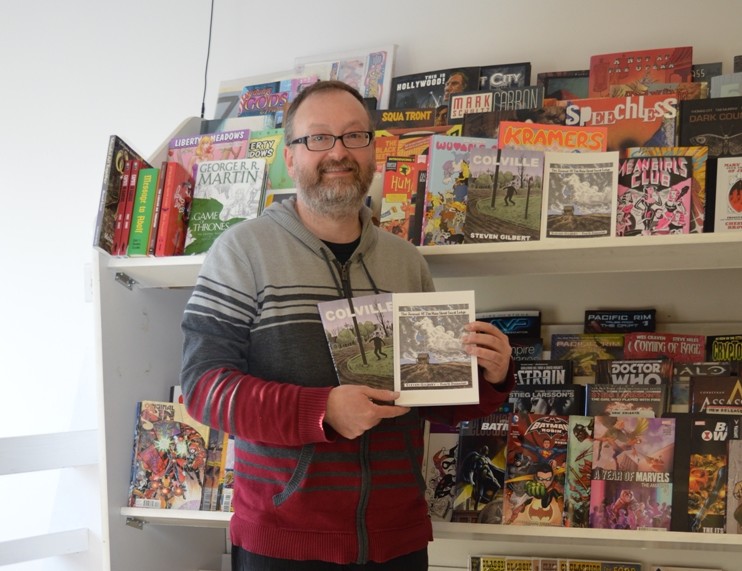
Steven Gilbert is a Canadian cartoonist author of The Journal of the Main Street Secret Lodge, a 2014 Dough Wright Awards winner, and of Colville. Back in the ’90s, he self-published six comic books of a series called I Had a Dream, plus two single issues, Gardenback and The Cult of Gardenback, where he developed the characters and the situations of the previous series. Between the two Gardenback comics, he published Colville, a 64-page comic book that received some good critics at the time. But after 1998 the world of comics lost Gilbert’s tracks and it was very difficult to find informations about him on the web until a few years ago. The most important source, if we can call it in this way, was a 2011 post at the Comics Comics website where Frank Santoro included “the guy who drew a comic from the mid-’90s called Colville” in a list of Good Cartoonists Gone. The same Gilbert contributed at the discussion writing this: “Wow, it’s nice to be remembered…I’m the guy who did the Colville comic. Glad you liked it Frank. I was an exhibitor at the SPX back in ’98 and sold a bunch of Colvilles there. I still draw comics when I can find the time, in fact, there is an entire second chapter of Colville completed (about 48 pages) plus about 25 penciled and lettered pages for a third chapter. Someday it’ll get finished and I’ll get a table at TCAF or sumthin’. Since 1999 I’ve owned and managed my own comics shop here in Newmarket, Ontario called Fourth Dimension. That takes up most of my non-sleeping time. Unfortunately, the drawing board has been back-burnered. I’m probably better at selling other peoples’ comics than I am at making my own!”. But Gilbert came back to comics in 2013 with a 128-page book, The Journal of the Main Street Secret Lodge, which won the Dough Wright Award for Best Spotlight Work the following year. And in 2015 he finally self-published, after nearly two decades in the making, the Colville book, including the original 64-page comic from 1997 and over one hundred pages of new material with the completion of the story.
I found out about Colville online and I was very curious about it for a long time, so when my friend Francesco (best known as the Italian cartoonist Ratigher) told me he had sent an e-mail to Mr. Gilbert ordering a copy of his books, I did the same and asked him if I could also sell Colville in my webshop. Ratigher wrote a review of Colville here at Just Indie Comics and from that moment a lot of people ordered the book or asked me about it. It was very funny to see a lot of Italian comic fans interested in a so obscure work, that it’s hard to find even in North America (Gilbert hasn’t a website and his books have no distribution at the moment). I exchanged some e-mails with Steven in the months after and when I went in Canada for this year’s TCAF I asked him to do an interview in Newmarket, a little town near Toronto where he lives and runs the comic shop Fourth Dimension, in 237 Main Street South. The interview took place on Monday 9th May at the presence of my friend Michele Nitri of Hollow Press and of Gilbert’s girlfriend Stacey.
Let’s start from the beginning. Are you born here in Newmarket?
I wasn’t born in Newmarket but I lived in Newmarket literally my entire life, my parents are resident in Newmarket and I always lived here.
And when did you start reading comics?
I was very young. My first recollection of comics is getting my hair cut at the barber and seeing this stack of Archie Comics and Disney Comics with the cover stripped off. But I had no affection for them at that time. When I was a kid I loved cartoons, I watched Bugs Bunny cartoons all the time. I was maybe more interested in animation at that very young age. When I was about 9 years old I had my tonsils removed at the hospital and my mom bought me a Spider-Man comic, that was kind of when I really became interested in comics.
Well, I read comics since I was very young but I was definitely hooked into them with a Spider-Man comic too, it was an issue with Doctor Octopus in the Bill Mantlo-Al Milgrom run.
Sure sure, Al Milgrom, yes… Mine was a Marvel Team-Up with Spider-Man and Doctor Strange.
Ok, and so when you started drawing?
As a young child, I remember drawing a lot before I was in the comics. I liked cartoons, so I doodled all the time. My dad used to bring home stacks of office paper, there was the letterhead on one side so I used the back of the sheets. I think at that age I was really into ninjas, I liked monster movies and I remember being obsessed by werewolves movies for quite a long time. I had tons of drawings with werewolves and monsters and stuff like that.
And this was still before comics?
Yes, and then when I discovered the comics I used to draw recreations of the cover artworks to try to figure out how that style worked. It was probably a little bit more when I was getting into twelve, thirteen, fourteen years of age that I started trying to make my own comics. When I was in high-school age I seriously started drawing comic books. My brother once wrote the script for a sequel to the Frank Miller’s The Dark Knight Returns, it was for a class project. And when I understood it would be about 30 pages I said “I won’t draw 30 pages for free”, so I charged him 200 dollars (laughs). I think my parents gave him the money to pay me, so they technically funded it.
Do you remember the story?
Oh no, it’s been a long time ago, in high school. I remember only I was trying to ink like John Totleben in Swamp Thing. It didn’t look like Frank Miller’s artwork, it looked like John Totleben from Swamp Thing. I should have the artworks somewhere at home but I never look at them and I don’t really want to look at them. The teacher made maybe a dozen of photocopies at the time and I’m petrified that somebody could have a copy of it. It was horrendously awful. Then I remember doing a comic book about the Travis Bickle character of Robert De Niro in Taxi Driver and then I drew another book with Grendel. My big dream at the time was that Matt Wagner could hire me to draw Grendel.
Were you a Matt Wagner’s fan?
Well, Grendel was a comic I read when I was fourteen-fifteen, and it was maybe the first step away from totally mainstream comics, because it was basically a super-hero comic but for grown-ups. The interesting thing is that Matt Wagner, who was a very skilled artist himself, was allowing other cartoonists to draw his character and so I thought “It can be my big chance”. I also thought to send my artworks to Matt Wagner but I never did it. My Grendel comic was a sort of remake of the movie Die Hard but with Grendel in it (laughs). I’m pretty sure the comic ended with the character blowing at the top of a building and it was totally ripped off from the end of Die Hard, I saw it like a month before and it was in my head.
And did you like also Sandman Mystery Theatre by Matt Wagner? It was one of my favorite comics back in the ’90s.
I actually read only a few pages of it, I knew at the time he was doing it because I worked in a comic shop but I never really read it. It was published in a period of my life when I didn’t read any Vertigo stuff, because alternative comics are the blast at the time for me.
So did you learn to draw by yourself, right? You didn’t take lessons or attended some school.
Well, in high school I had an art teacher who was very sympathetic to comics and encouraged me to do them. Well, he is in Colville, I drew this scene where there are my art teacher and my high school. He actually came into the store about two weeks ago, someone showed him the comic and he visited me specifically to say “Don’t put me in your comics anymore”. I think he was ok with the book until he arrived at the last 40 pages… However, in high school I was lucky to have an encouragement to draw comics but I didn’t get any specific instructions, I was purely absorbing from as many comics as I could, lots of copying and trying to figure how to put things on the page.
And what happened until I Had a Dream #1? You self-published it in June 1995 with your own imprint King Ing Empire but you created comics even before I guess, so I’m curious if you made something before that issue.
I tried several times to get a comic put together. I was in my mid-twenties when I published the first issue of I Had a Dream, so it was a lot of time after high school. In the meantime, I worked at a comic store and I also drew comics.
But only for yourself.
Yes, it was my training ground, I drew hundreds of pages of comics and illustrations but I never showed them to anybody, maybe just at few friends. There was a couple of crime comics I worked on, a sort of murder mystery stories I was trying to figure out how to develop and at a certain point the actual events that inspired Colville occurred and I immediately thought “This is the story I want to do”.
And this is before I Had a Dream.
Yes, it was long before I Had a Dream but I already drew a cover for that story, even if it was a different cover both from the one of the Colville comic book than from the one of the Colville graphic novel, but more similar to the latter. At the time I thought the comic should be called Warning Shot but I had this intuition I wasn’t still good enough to do the story I had in my head, because at the time I never drew a comic that was more than 25 pages. I needed to figure out how a comic book works. So, it happened that a friend of mine, one I knew from years without really knowing he drew comics, came in the comic shop…
What was his name?
His name is Jason Williams.
Ah ok, I thought he was him, his name recurs in your first comic books.
Yes, so he came in the shop and showed me a Spider-Man comic he drew, and maybe it was the worst comic I did ever see. It showed me also a rejection letter from Marvel. Then, he started drawing a comic called Underterra and he wanted to publish it but he wasn’t really ready to publish a comic. He also gave me the pages of the first issue asking me to edit them. I read it and it was full of mistakes, so I wrote a lot of notes and at a certain point I begged him to redraw it, proposing to co-write and ink but at the end he published the first Underterra how it was, with all the mistakes. And he printed five thousand copies per issue, distributing all the six issues with Diamond. But I think he sold only 90 copies each.
So, was that an inspiration for you? (laughs)
Well, what I got from him basically was… the name of his printer (laughs). He gave me this contact information and so I made the decision “If this guy can do a comic, I better get off my ass and do a comic”. I already had the first versions of the first three issues of I Had a Dream drew very rough because I made them like 24-hours comics. So I completely redrew them. Looking back, now I’m not satisfied with the results and probably I shouldn’t have published them but at the time they helped me learning cartooning. However I think there is a big shift in the fourth, fifth and sixth, I managed to put my ideas on the pages, the artworks got better. But with those sixth issues I felt I was done with that, I thought I was ready to do the Colville comic. But then I drew a really big picture for a friend of mine as a birthday present and it was a very big comic with like 40 panels. That became the first Gardenback comic and I published it before Colville.
But looking still at the first three issues of I Had a Dream, these follow the same patterns of the newspaper strips, there are these two “guys” in another dimension who face each other, with a lot of situations which can remind Krazy Kat or some cartoons.
I’m sure Krazy Kat didn’t have any kind of influence on me at the time, but as I said before I loved the Warner Brothers-Looney Tunes stuff, just absurd violence, things crashing together, walls being knocked down and so on… They surely influenced me. You know, the firsts I Had a Dream were very nonsensical, I was a huge Chester Brown fan and I remember reading an interview where he talked about his process of doing comics and he said he drew panel after panel, without having a precise idea of the whole…
Yes, like in Ed The Happy Clown…
Exactly, so I worked in that way too.
Then with I Had a Dream #4 you started Slipstream, a very different two-part storyline about Roswell, psychological operations, Russians, conspiracy theories. Did you plan it from the beginning?
Absolutely not. I was probably watching some X-Files episodes and reading about the Kennedy assassination, I read about 40-50 books about it. I was obsessed by conspiracy theories in my twenties, these things took a lot of my attention at the time and comics in some way are what got me out of interest. After doing those comics I never got interested anymore. That was the end of it for me.
Between Gardenback and The Cult of Gardenback you published the first issue of Colville, right? It should be from 1997…
Yes, in the beginning it should have been much smaller, like 25 pages, and it had to be only about the confrontation in the schoolyard. It was loosely based on a true crime story, I clipped the newspaper article when it was happening because I remember reading it and thinking “It could be an interesting comic”. But those were just the bare bones, the story began to grow around the episode of the shooting in the schoolyard. I thought to do a 64-pages comic and I had the bones of the story and a lot of the imagery was in my head. I went up to Keswick, a small town 20 minutes up the highway from Newmarket where the facts actually occurred. My friend Jason Williams lived there, so he knew all the neighborhoods. We drove there one day and took photo references I used for the comic.
Do you use a lot of photo references, right?
Yes, these researches are part of my methodology, because I don’t write scripts…
Never?
I tried but I never successfully wrote one, when I finish and read a traditional script with panel descriptions, dialogues and so on, usually the ideas just seem stupid and I can’t use them. The only way I can make comics is to sit down and draw. My process of writing is the creation of the comic.
The 64 pages of the Colville comic book from 1997 are exactly the first pages of the 2015 book or you changed something?
Yes, the first 64 pages of the graphic novel are the same of the comic book, except for maybe one or two extremely tiny revisions of the artworks.
That comic book was really different from I Had a Dream. There is a new feeling in it, like the inspiration came more from the movies than from other comics or conspiracy theories. I can feel the mood of some American movies from the ’70s or the early ’80s, I think to Brian De Palma, Martin Scorsese or also David Lynch of Blue Velvet.
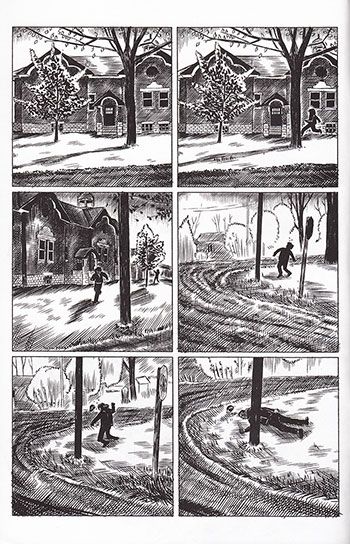 I usually deny any influence and I don’t think for cartoonists is a good idea to look at cinematic references, because comics are their own thing. But, having said that, at that time I was a huge fan of David Lynch and of the Blue Velvet movie in particular, that was a small town perverted crime story. I was also a big fan of the Twin Peaks tv show and I can tell you a little trivia about that. I decided on the title Colville from the Canadian painter Alex Colville, even if there isn’t really any direct visual correlation to the comic, it was more about the mood and the atmosphere. But there is a scene in the Twin Peaks tv show where they’re describing the geography of where Twin Peaks is and – it’s been a long time since I watched it but the line of dialogue should say “In the North-East corner of Washington state right on the border with Montana and just below the Canadian border”. And for some reason, I decided to get out a map to look at what’s there and there is a town called Colville. You can look at a map, it isn’t a joke. This was after the Colville comic book was drawn, so I thought “Well, the force of the universe are working together…” (laughs). This is about the Lynchian influence, about Brian De Palma, well, I co-dedicated the graphic novel to Brian De Palma and Nick Cave, and the first is largely for the use of the tracking shot in his movies. I’m a bit of a sucker for tracking shots when I’m watching the movies… The second chapter of the book begins with the character recording with the video camera, so you can read the entire chapter as a long tracking shot, as if the camera never leaves.
I usually deny any influence and I don’t think for cartoonists is a good idea to look at cinematic references, because comics are their own thing. But, having said that, at that time I was a huge fan of David Lynch and of the Blue Velvet movie in particular, that was a small town perverted crime story. I was also a big fan of the Twin Peaks tv show and I can tell you a little trivia about that. I decided on the title Colville from the Canadian painter Alex Colville, even if there isn’t really any direct visual correlation to the comic, it was more about the mood and the atmosphere. But there is a scene in the Twin Peaks tv show where they’re describing the geography of where Twin Peaks is and – it’s been a long time since I watched it but the line of dialogue should say “In the North-East corner of Washington state right on the border with Montana and just below the Canadian border”. And for some reason, I decided to get out a map to look at what’s there and there is a town called Colville. You can look at a map, it isn’t a joke. This was after the Colville comic book was drawn, so I thought “Well, the force of the universe are working together…” (laughs). This is about the Lynchian influence, about Brian De Palma, well, I co-dedicated the graphic novel to Brian De Palma and Nick Cave, and the first is largely for the use of the tracking shot in his movies. I’m a bit of a sucker for tracking shots when I’m watching the movies… The second chapter of the book begins with the character recording with the video camera, so you can read the entire chapter as a long tracking shot, as if the camera never leaves.
Ok, we’ll say more about Colville later, when we’ll arrive to present days. Now I’d like to talk about your long pause if it isn’t a problem. In less than three years, from June 1995 to April 1998, you published 6 issues of I Had a Dream, Gardenback, the first issue of Colville and The Cult of Gardenback. Then between April 1998 and 2013…
Nothing!
Yes, exactly (laughs). Nothing until The Journal of the Main Street Secret Lodge came out in 2013. Fifteen years is a long break.
When I finished the 64 pages of the Colville comic book, I realized that there was room for a couple of more connections. Initially I saw Colville as a 64-pages story with completion and nothing more, but as I was maybe about two-third of the way through I started thinking about it as the first chapter of something larger. But I had also an attachment to the Gardenback comics and I got this idea I should rotate between the two and each year I would do one or the other. So I drew and self-published The Cult of Gardenback in 1998, it was a pretty quick process to draw a comic, then self-publish and sell it through Diamond…
Did you use Diamond since the first issue of I Had a Dream, right? And also Capital City Comics at the time.
Yes, at the beginning I was distributed also through Capital City but then Diamond swallowed everyone up. However, after The Cult of Gardenback was published, I started working at the second chapter of Colville. My plan was that my next book would be Colville #2. In the meantime I was working at a comic book store, The Comic Wizard here in Newmarket, just across the road from where we sit now. Yes, my whole life is in this corner basically (laughs)… As I was working there, the store changed ownership but I continued to work in the shop. The manager bought it in December of 1996 but the business was failing and the store wasn’t doing very well. He owned the store for a couple of years and he struggled to keep it alive. At a certain point I thought to buy the store but then I realized it wasn’t possible. So, I was going to be out of job and I had absolutely no marketable skills to work in the real world. The only thing I ever did at that point was selling comic books, so I decided to open my comic shop.
So, did you open Fourth Dimension after The Comic Wizard closed?
Well, it was basically at the same time. At one point it was clear that the comic shop was closing in two weeks, so I immediately signed a lease on my store and called distributors to set up accounts and everything. But the owner of The Comic Wizard attempted to keep things going and so there was actually a very weird time where I opened my store but he was still open trying to liquidate.
So, there were two comic shops? (laughs)
Yeah, within a block, in the same street. But one was closing and I was just getting things started… What happened with cartooning, well, I never worked that hard in my life, opening a business was just insane because I was doing it on my own. My plan was to put the comics aside for six months and then get back to them. But the store was so much hard work, at the end of the day I was exhausted and I couldn’t work on comics when I was at home. That period of six months turned in two years and then three, four, five… I remember pulling out those unfinished pages with the intention of completing the book but I looked at them with my pencil for twenty minutes without drawing a single line and then I put them away. And then a year would go by before I tried again. It happened in 1999, 2000, 2001 and continued for several years. I still did some drawings and caricatures of customers in the store purely for my own enjoyment, but not comics.
And landscapes? There are a lot of landscapes in The Journal of the Main Street Secret Lodge book, did you work at them in those years?
No, no landscapes. I don’t even know, they were mostly wasted drawings. At a certain point I remember having the realization “I’m not a cartoonist anymore, it’s a long time since I’ve done a comic”. But then, after some years, I did start drawing seriously again, when I invented the fanzine Journal of The Main Street Secret Lodge. It was about 2003 when I self-published one of them, just for fun, to give it to friends and customers. Maybe I photocopied a couple of them even before, they were a sort of merchant newsletters. I was interested in the historical side of Main Street, the buildings, and the atmosphere. I started to do it fairly regular, creating little stories about Captain Woodrow Gilbert and his adventures, following more or less the same formulary, usually bad guys coming in Newmarket to rob the bank and Woodrow going to fight and kill them. It was totally for my own amusement. They started to become more and more ambitious, I changed format, some were published like digest size, some had 24 pages, then 36, some 48…
How many of these zines did you publish?
I think I did five or six of them after the one of 2003. The last one was still photocopied but it had 84 pages and I took about a year to finish it. It had a ton of illustrations and a long hand-lettered short story. It was just pure insanity to do that and just photocopy. When one of my customers who used to write comics himself back in the ’80s read it, he came in the store and he gave me a three-pages letter that basically said “You’re an idiot for not doing comics because this is great but it’s not what you should be doing” (laughs). And I just laughed, because these zines were purely for my own self, I didn’t care about people reading it, I produced them only for my satisfaction, to do something creative. But I think at that point I did have the idea for The Journal of the Main Street Secret Lodge. Actually it was an idea that has been in my mind since while I was working on Colville, I thought at this western bank robbery story using Newmarket as the backdrop. And it sat there in my head for years. Then, it happened I found out that article on the website Comics Comics, probably I saw the link on another website I was on, because at the time I didn’t use so much the web, I never googled anything I guess (laughs).
So, did you know the Comics Comics website?
No, I had never seen that website before. The only thing I knew was that Comics Comics was a print publication, they did a couple of magazines I had in the store but sold out before I even read them. I didn’t know Frank Santoro was involved with them at all, I knew Santoro for his comics like Storeyville that I was a big fan of. However, I think I saw it on Heidi MacDonald’s page, The Comics Beat, there was this link saying something like “Frank Santoro at Comics Comics has an article about cartoonists from the ’90s gone”. I remember I had the mouse cursor over that on the screen thinking “If my name is on that list I’ll shit my pants”. And I clicked on it and I found “The guy who did Colville“. So, I thought “Shit, I’m on this list and that means someone remembers my comics”. And I just knew, it was like a light switch going off in my head saying “You’ve to do another comic book”. So, I immediately started working on The Journal of the Main Street Secret Lodge.
It was 2011, right?
I think so, I’m not so good at archiving things in my mind. However, I started drawing with the idea to do another photocopied zine. The previous one consisted of 21 pieces of paper put together, stapled and then folded to make 84 pages, plus the cover. I had to staple some zines three times and it really pissed me off. So I thought 84 pages were the limit and while working on the Journal I paid attention to the pages and as I got to 70, then 75, 80 and so on, I started worrying. And when I finally finished it and it was 130 pages, I showed the work to my friend Eddie and he told me “This has to be a book, it can’t be just some photocopy bullshit you put near the counter giving away to people who enter the shop”.
Did you think to propose it to a publisher or did you want to self-publish it from the beginning?
I never really thought about sending it to anyone, self-publishing was really my only idea at the time. I thought of something like print on demand or at a very small print run, because I was selling a hundred of the photocopied zines, so I thought I would need a hundred copies even this time. I did a lot of researches about print on demand but when I talked to some people at comics conventions everybody seemed not satisfied with the resulting product, they talked about problems with the binding, the glue and so on. While I was doing these researches on printing, I found somewhere the name of the printer I dealt with 15 years earlier and I thought for the first time to do a proper offset printing. I contacted the same guy I talked 15 years before but I found an old e-mail because somewhere along the line he changed printing company, but he was looking at this old e-mail once in a while and e-mailed me back. Well, I don’t know where I’m going with this answer…
Well, I think this is the point when you decided to do it in offset.
Yeah! (laughs). Well, I think a big fact was the affordability because printing in offset the minimum was typically a thousand copies, you know, it’s a bit more an investment doing that financially that a hundred print on demand copies. But I found out that the costs of print on demand were really high. It was 9 dollars per copy, plus 2 dollars to ship to Canada since it was a USA printer, so I had to pay 11 dollars per copy, plus the exchange rate while to do one thousand copies in offset I would need 2200 Canadian dollars. It was a really good deal. So, that was the point when I said “Ok, I’m going to print it, for real”.
That book won the Dough Wright Award for Best Spotlight Work, right?
Yes, things went a little bit crazy, because initially I was just selling it only on the counter here in the store. I had plans to go to TCAF the following year but I didn’t have any thoughts of submitting the book for consideration for Dough Wright Awards. Then a friend of mine, who lives in Winnipeg, had a copy of the book and told me there would be a Chester Brown signing there in a couple of days and I said him “Damn, I’d love to give Chester a copy of the book, but I couldn’t send you one in time” and he said “Well, I’ll give him my copy and you can send me another one”. So he gave a copy to Chester and he e-mailed me “Oh, Chester was so happy to hear you made a new comic”.
You already met Chester Brown at that point, I guess.
Yes, I knew Chester very formally and casually at signings and talked to him. He knew my comics from the ’90s too. I don’t know how many time passed but one day I had this phone call from Chester at the store and he was very complimentary about the comic. And he said he was on the nomination committee of the Dough Wright Awards and he asked me to submit The Journal sending five copies to the members of the committee. He even joked that he tried to buy some copies at The Beguiling in Toronto but they didn’t have it and they didn’t know how to get. I said “I know how to get copies, I’ve boxes full of them” (laughs).
So at that point you hadn’t even sent copies to The Beguiling.
No, I actually called Peter of The Beguiling right after that and I asked if he wanted some copies and he said “Yes”. When the nominations for the Dough Wright Awards came out, it was 2014, my name was on the list with some pretty awesome cartoonists. And it was very very weird to me, there was a lot of disbelief that I had my name written down with those other cartoonists. Well, you know, the Dough Wright Awards people invite you to the party at TCAF because you’re nominated and I said “Well, it would be probably bad form to not be there when you’re nominated and you’re exhibiting at the show”. And they reserve seats for you like in the front row in a sort of VIP section, but even on the day of the awards I wanted to seat in the back because I figured that it could be an easy escape afterwards. We went there with Stacey but we sat midway, we didn’t sit in the VIP section, I didn’t feel it was appropriate for whatever reason…
You found a compromise…
Yeah yeah, midway back. Then, it seemed pretty surreal to me what was going on. The category I was nominated for, there were four other cartoonists that I think they are amazing, there were Dakota McFadzean, Connor Willumsen and… Oh man, I’m drawing a blank on…
But the category Best Spotlight Work was for young cartoonists, right? (laughs)
Yes, it was for upcoming cartoonists, which was a little bit of a joke, I found it was kinda funny. But if you watch the page of the awards, there is no age specify, the category is for emerging cartoonists but they don’t have to be young. I don’t’ really have any nerves about this nomination until I was there, then it was really terrible. In the days before the awards, Stacey looked at me and told me “You’re gonna win” but this seemed totally impossible to me. But she knew it.
The award didn’t change your style, because after that you worked on and finished the Colville book but you didn’t think to propose it to some publisher, right?
Well, not to digress back, but after the Colville comic book in 1997, I sent copies to Seth and Chester Brown, and Seth mailed me a little postcard where he wrote “You should send this to Chris Oliveros at Drawn and Quarterly, I think he’d like to see this”. So I sent a copy to Chris Oliveros and he wrote back saying he saw some merit in it, asking me to keep him informed on my future projects. Of course, right after that I stopped making comics for a long time. But Drawn and Quarterly is probably my favorite publisher of comics and I felt like they were beyond what I thought of my own stuff. Part of me feels like my comics aren’t good enough to be published by the publishers I like…
Do you really think this?
Probably yes, you know, I like Drawn & Quarterly, I like Fantagraphics, I like Conundrum, I like Koyama Press and maybe in a few days at TCAF I’ll give them some copies of the books, I don’t know… I know some of the people know who I am but I’ve never sent a submission. Maybe I can do that with the next Journal, probably I would like to see my comics having wider distribution. I got some ego and I’d like to see a few more people having access to my books easier than finding my e-mail at the bottom of a review. But I also like self-publishing because it’s entirely my own creation, I don’t have to change anything for anybody that I don’t want to change, every single line can be whatever the line that I want to be. I’m grateful also that both Colville and The Journal have broken even, they sold enough copies through the store, TCAF and a handful of locations to cover the costs of printing. And in some way that was my goal, when I did The Journal I thought “If someday I can break even of the printing price, I can consider it commercially successful”.
Very small ambitions (laughs)…
I mean, I never submitted my new books to Diamond Comics for distribution, maybe it’s the fear of possible rejection, that Diamond could say “We don’t think this is good enough to carry”…
Well, you don’t have to care about Diamond’s opinion!
But Diamond represents a huge avenue in the comics stores in North America and around the world, every English language comic store is ordering from Diamond. I mean, I don’t really care about an aesthetic judgment from Diamond… Well, I’ll get around to it, I have the contact information, so at some point I think I’ll do it.
Speaking of The Journal of the Main Street Secret Lodge, the main character is Captain Woodrow Gilbert. Is he based on a real person?
At this point, he totally exists in my head. In full disclosure, the character is completely stolen from this tv miniseries with Tommy Lee Jones and Robert Duvall called Lonesome Dove. It’s a western, and probably it’s the best western I’ve ever seen. It is based on a novel of the same name by Larry McMurtry. In Lonesome Dove, the main character is a cowboy, a former Texas ranger named Captain Woodrow F. Call. The characters go from Mexico to Montana to establish a ranch and all the story is about this giant cattle drive. When I saw this movie, I used to joke with my friend who is now in Winnipeg, James, saying that I would close my store to go in Mexico, rustle five thousand cattle and make my way up to Montana. The two characters in Lonesome Dove are Woodrow and his friend Augustus and I thought the only thing keeping me to go in this cattle run is I don’t know if I’m Woodrow or Augustus. James looked at me one day, like if he was considering the question, and he said “You’re Woodrow”. So I developed this odd idea that I had a distant relative who was this former Texas ranger who had been on a cattle drive and at some point in his old age moved from Montana to Newmarket operating in The Northern American Hotel on Main Street. And he became the character I wrote this Journal story about. The idea of the character is totally taken from Lonesome Dove but I feel like if I made it into something different.
The book includes this main story with Woodrow but also a lot of landscapes, a hand-written text about hotel robberies, women portraits by William Bobo…
Well, I try to satisfy all interests…
Yes, there is a bit of everything. But do you think the real main character is Newmarket?
I think so, and even more as time is going on, I feel like a big part of doing The Journal is drawing the town. There is much more emphasis on this in the second book I’m working on, it’ll be a real travelogue, a visual representation of so much more of the town. It’s a 250-page comic and about 150 pages of it are just touring the town, there are a lot of scenery from real references of Newmarket.
Did you search for actual references to depict Newmarket in the past?
I have tons of reference material of the history of the town and a lot of visual representations. Being a life-long resident, it was very easy to understand what this journey through the town would be. I could sit, close my eyes and know exactly every corner, every location. It isn’t hard to find the locations since I live here, I can go and photograph if I need something, it’s pretty easy to do.
Ok, let’s talk more about the Colville book. I think the story is really more impressive read as a whole because the reiteration of the key scene is very important and gives power to the entire work. This wasn’t an idea from the first comic book, right?
When I had the idea of developing a follow-up to the first comic book I hadn’t any clue visually on how I could connect the story more directly. There was a point in those first 64 pages, when I introduced the Paul Bernardo character, that was a very disturbing thing to do, because he is a real person, he was actually a serial killer and serial rapist in the Toronto area in the early ’90s. His favorite tool was the video camera and when I decided he would play a bigger role in the second and in the third chapter, I had this idea of replaying the crime, so it just seemed the right thing to use this guy in the bushes recording. He really used to do stuff like that, following people, recording them and so on. Colville is a story in three sections but originally I was working on another section, a whole chapter following the police officers who investigate. I actually drew about 25 pages and then scrapped them because they were getting away from the visual replay of that crime. Once I drew them for the second time, they became like in the movie Rashomon, where they replay the same crime from four different perspectives. So at that point it was something that immediately suggested itself as a way of spinning the plot line out in the other characters.
Yes, it’s interesting because this works as a connection between different stories and this makes me think the main character is still the town, Colville, as Newmarket was in The Journal.
Well, I put a lot of effort into making the environment a part of the story, I like stories about a specific region, where you’re finding enough about the characters but you’re also seeing the landscapes, the geography and so on.
And it’s not only about the city but also about the “town criminal organization”, as is the title of the book sent by David’s girlfriend along with his adaptation of Twilight of Superheroes, a never-published comic by Alan Moore…
Well, I call it the Watchmen‘s ending…
In fact it’s very similar and I wanted to ask you about this. Did you want to insert a sort of quotation or to literally reply the Watchmen‘s final scene?
I wasn’t consciously thinking of it as a direct reference, there was a period like years ago, back in the 90’s, when I used to fantasize about the ending of the comic, and I knew there would be this scene where the girl Tracy mails the artwork to me. Initially, I thought about doing that the kid had drawn a mini-comic about this criminal activity, then I thought there would be no book because I wanted to draw this scene in the post office but it should be difficult to take some photo references inside a post office…
And so you used the mail box…
Yes, I thought “I can do it without drawing a post office”. The title of the book, Nomenclature of a Small Town Criminal Organization, was a little bit of a note to my JFK’s days, there was a self-published book I purchased, it was just a photocopied book that you can order through mail, it was called Nomenclature of an Assassination Cabal and I’ve always said “That’s a fucking awesome title”. And so this little idea of this Nomenclature of a Small Town Criminal Organization was a little detail I had in my mind for ten or fifteen years. But definitely as I was drawing it I thought “This is kinda Watchmen‘s ending”.
And this nomenclature is also in the book, page after page the reader is meeting more wicked criminals, so we’ve David, Van, Alan Gold and then Paul, who is the scary guy… Did you imagine it like a sort of crescendo?
I hadn’t the idea of an escalation, no… But I think one of the reasons I didn’t do the book for so long was that I was very uncomfortable with what I decided the ending was gonna be. Originally I decided to draw ten pages of Paul Bernardo in the basement with the girl but I didn’t feel like I had whatever I needed to draw how awful those ten pages were, so I kinda rejected to finish it for a long time. It’s a horrible subject matter.
But you had decided this subject matter had to be in the book.
It’s funny because I could have changed this to do something different but once I decided some years ago that this was the ending, there was no changing option to me.
This could be another reason because you stopped making comics…
You know, opening the store is a big part of it but probably I also felt like I just didn’t have whatever I needed to draw those pages, it was a pretty sickening material to me. I read some books about Paul Bernardo so I knew how horrific the crimes were, so when I came to interpret them fictionally in the comic, to make this character of the girl as a victim of Bernardo, I knew it wouldn’t be pleasant to draw. I didn’t want it to be titillating or exciting, I wanted it to be horrible. And I felt horrible drawing it and I talked to people who felt pretty horrible reading it, so I suppose it was successful if it’s possible to say this.
Finishing the book was a sort of liberation?
I’m glad that I’m done with it and I don’t really have any interest in doing that kind of story again. To me, The Main Street Journal stories have extremely gruesome violence but in the meantime there is a sense of fun and play to them, there isn’t any level of seriousness for the most part.
Yes, and even the drawings are very different, Colville is more realistic.
Well, I think Colville is the best I’ve ever drawn. I’m also very pleased about some pages of the next Main Street Journal but I don’t think I’ll ever put the kind of work I put into Colville into anything else.
I suppose the pages from Colville needed more time than those from The Journal, the cross-hatching is very detailed, especially in the second and third part. And the cross-hatching is a sort of trademark for you.
The Colville pages were drawn much larger for the most part and yes, they took forever. As for the cross-hatching, well, I wouldn’t recommend it to anybody. I think sometimes comic books’ artists put a lot of lines on the page to disguise the fact they can’t draw. But I figure any bad drawing in my comics is there for anyone to see. There is no intention to disguise bad drawings, I’m using the cross-hatching more to create a kind of mood. I think in my earlier comics this was more stylized, then it became more realistic and now I’m going back to a sort of stylized in the next one. I’m going to print in gray tones, drawing in separate black and white layers, a little bit different from the past. It’s hopefully a positive progression, even if I’m sure the next book I’ll do after the new Journal will be the most massively cross-hatching thing I’ve ever done.
So, you’re going back and forth, I guess.
Yeah, I think so (laughs).
Pics & Words from CAKE 2016
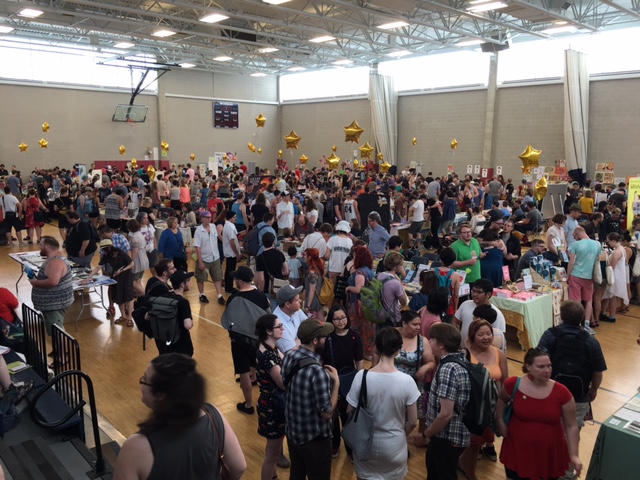
by Corinne Halbert*
CAKE 2016 was a huge success and a ton of fun, here are some highlights from the 5th installment of the Chicago Alternative Comics Expo.
Chester Brown was signing books and celebrating his newest Graphic Novel Mary Wept Over the Feet of Jesus at the Drawn and Quarterly Table. Leslie Stein and Paco Roca were at the Fantagraphics table. John Pham and Sammy Harkham were slinging the fantastic Kramers Ergot #9 as well as several gorgeous books by Pham. Gabby Schulz was at the Secret Acres table signing his new gut wrenching and exquisitely rendered Graphic Novel Sick. Sacha Mardou and Ted May were at Alternative Press/Revival House Press table. Sadly Trina Robbins had to cancel her appearance due to health issues but Scottish Cartoonist Eddie Campbell, creator of From Hell was able to make a guest appearance and fill in for her panel. Ed Luce of Wuvable Oaf had so many fantastic publications. Krystal DiFronzo created the artwork for CAKE 2016 and had beautiful books available at her table with the amazingly talented Lale Westvind tabling right next to her.
Quimby’s, the legendary Chicago bookstore, celebrated their upcoming 25th anniversary with a panel discussion with Liz Mason, Gabby Schulz and Laura Park moderated by Jake Austen. Chris Gooch and Sarah McNeil from Melbourne Australia were the CHIPRC inbound TRANSIT artists in residence. Sparkplug Books celebrated 14 years of excellent publications and Cathy G. Johnson lead a roundtable discussion about journal comics.
There were so many great small publication debuts this year at CAKE. Jon Drawdoer had his comic hello, Anya Davidson with her gorgeous comic Gloom Planet risographed by Perfectly Acceptable Press, Lisa Hanawalt with her book Hot Dog Taste Test, Lane Milburn with Broken Panels #1 , Victus #4 by Tyrell Cannon, Bad Dog!!/Good Kitty! by Mike Freiheit and Isabella Rotman, Coin-Op #6 by Peter and Maira Hoey to name a few. A more extensive list can be found here. There were even more debuts than the 30 listed as I know there were artists working up till the last minute to finish up their books.
To mention a few Chicago staples Trubble Club was there debuting their amazing Nate Beaty themed comic Tiger Beaty. Prolific illustrator and comics artist JB Roe was representing Chicago but hanging with the incredibly cool Providence publishers Hidden Fortress Press. Dynamite illustrator and comic’s creator Johnny Sampson had his killer debut Total Fuck Up. Onsmith and Nudd were stirring up trouble as usual and Laura Park had her gorgeous debut Do Not Disturb My Waking Dream #5.
Spudnik Press was slinging fabulous publications as usual and Tan and Loose Press had some sexy ass prints for sale. Keith Herzik creator of Alamo Igloo had incredible hand-screen printed books and posters available and Eddy Rivera had his sexy anthology zine Puddin #3 on debut. Scott and Keiler Roberts, Brad Rohloff, Chloe Perkis, Grant Reynolds, Brett Manning, The Ladydrawers, Odin Cabal, Jonathan Bell Wolfe, Cathy Hannah, Gina Wynbrandt, Kevin Budnik, Chris Cilla, Math-you-Land-vote, Jessica Campbell, Danielle Chanette, Josh Cotter, Henry Guerra, Amy Peltz, Tony Breed, Radiator Comics, RJ Casey of Yeti Press, Dave Scheidt, Scott R. Miller, Ian McDuffie, Matt Davis of Perfectly Acceptable Press and Kelsey Choo were all there with beautiful books to list some more.
I’d like to take a moment to mention some of the current core organizers of CAKE. Jeff Zwirek, Neil Brideau, Max Morris, Ben Bertin and Alli Alleman. Without their tireless efforts and undying commitment to the alternative comics community in Chicago CAKE wouldn’t be possible. They are all wonderful, generous and devoted people and their continued support of artists both local and from all around the world should be recognized and celebrated.
In addition to support the core organizers are the other kick-ass CAKE coordinators Jessica Campbell, Brian Cremins, Mike Freiheit, Amy Peltz, Chris Lopez, Matthew Brady, Isabella Rotman, Henry Guerra, KT Hawbaker-Krohn, Marnie Galloway, Jon Mastantuono. There were too many talented artists to list them all! Thanks to everyone who made it out to CAKE 2016, I hope to see you all in 2017!
*Corinne Halbert is one of CAKE coordinators and exhibited at the show with her mini-comics Honey, Hate Baby and Bad Touch (the latter in collaboration with Scott R. Miller). Below Corinne at her table and her haul at the festival.
“Blammo” #8 1/2 di Noah Van Sciver
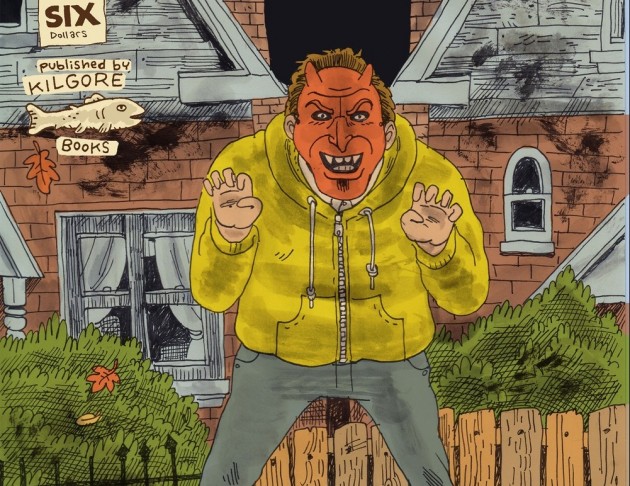
Dimenticate i tipici racconti alla Van Sciver, quelli che vedono protagonisti i suoi loser brutti, sfigati e rovinati dalla vita e che erano la principale attrattiva dei precedenti numeri di Blammo, nonché il cuore dell’antologia Youth Is Wasted (ne ho parlato qui). Come la numerazione lascia intendere, questo ottavo numero e mezzo dell’antologia è un albo atipico, che mette insieme in un bella confezione impreziosita dall’uso del colore una serie di contenuti eterogenei, già pubblicati altrove oppure realizzati per l’occasione.
Il “cuore” di questo albetto, come al solito pubblicato da Kilgore Books, è costituito dai contenuti autobiografici, a partire dai diary comics già visti on line e che, riprendendo la struttura del comic book I Don’t Hate Your Guts uscito per 2d Cloud, ne proseguono anche la storia. Se in quell’occasione il sarcasmo spietato e l’ironia affilata di Van Sciver lasciavano spazio al romanticismo, qui assistiamo all’epilogo di quella relazione amorosa, in una serie di pagine dai colori pastello in cui a prevalere è la malinconia. Van Sciver non si mette completamente a nudo, non rivela particolari intimi come farebbero altri autori, ma raccontando piccoli fatti della quotidianità riesce a raggiungere il lettore, a stabilire un’empatia. Disegnati in fretta sul suo sketchbook, questi diari sono per me una delle cose preferite della produzione di Van Sciver e in un’ipotetica classifica dei molteplici “generi” affrontati dall’autore statunitense li metterei al secondo posto, subito dopo le storie dei perdenti di cui dicevo sopra. La tematica della rottura con la sua ex è ripresa in un paio di fumetti che fanno da cornice alle sei pagine di diario, in cui si passa da una malinconia ancora più toccante (in una spendida tavola in cui l’autore ritrova a casa le forcine per capelli della ragazza), alla saggezza dell’amico e collega John Porcellino (nel resoconto di una conversazione telefonica) fino alla disperazione (in una tavola che ritrae l’autore a letto).
Se tutto questo vi sembra troppo intimista siete fuori strada, perché in questo numero di Blammo c’è molto altro, come un’apparizione speciale di Fante Bukowski (protagonista dell’omonimo libro fatto uscire qualche mese fa da Fantagraphics), un divertente fumetto con protagonista un killer di comunisti – che uccide demoni con la falce e martello stampata sul petto al grido di “better dead than red” – una storia marinara (o presunta tale) piena di mostri, due pagine biografiche (una dedicata addirittura ai Limp Bizkit, chissà perché) e una doppia tavola che ci riporta alle atmosfere del graphic novel The Hypo. Citazione a parte merita la ristampa di alcune strisce uscite per il giornale di Denver Westword, in cui possiamo notare l’abilità di Van Sciver anche come autore di newspaper strip, qui incentrate su temi di volta in volta diversi come la solitudine, i dischi preferiti, la depressione, le sbornie e via dicendo. Tra tutte la mia preferita è quella dedicata all’inverno, con l’inizio cult “I hope this winter is the coldest and darkest on record. I hope the sun goes down at noon and everybody stays indoors and reads”. Come non essere d’accordo?
Ah, se qualcuno ancora non lo sapesse Van Sciver sta per debuttare in Italia con il volume Saint Cole, in uscita in questi giorni per Coconino Press.
A Cake 2015 photo gallery
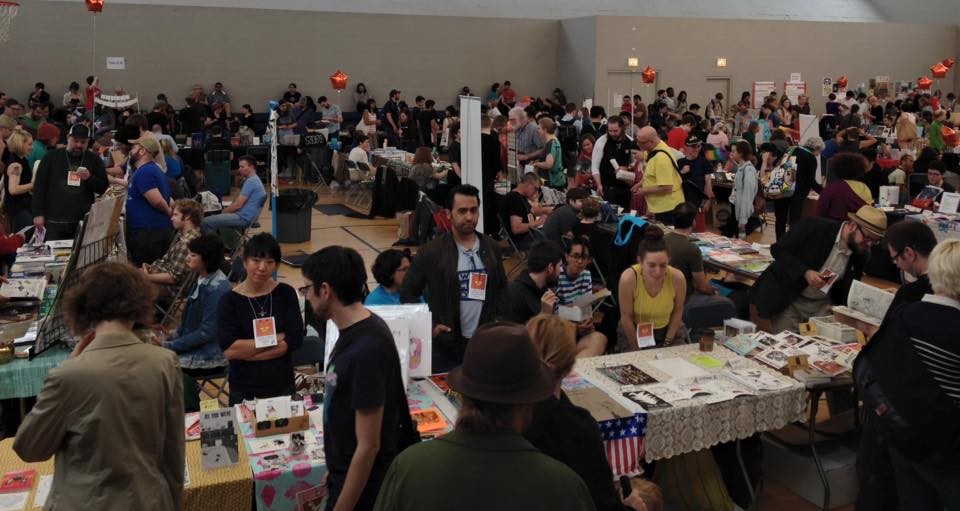
As some of you already know, around here I’m talking mostly about comics (indie, underground, alternative or whatever) from North America and so I find a festival as the Chicago Alternative Comics Expo (CAKE for friends) very interesting, since it gathers a lot of cool cartoonists and publishers from United States and Canada. Even if I wasn’t there on June 6-7, I decided to dedicate a gallery at this event, assembling photos I saw on the various social networks. All the pictures are used with the permission of the authors and if I made any mistake or I’ve forgotten to mention someone, please contact me at justindiecomics [at] gmail [dot] com. Many thanks to everyone for the cooperation. Just click on any image to open the gallery.
- Entrance! (photo by Jared Smith)
- Registration is open (photo by Chester Alamo-Costello)
- The fest just before the door opened (photo by J Derf Backderf)
- CAKE! (photo by Corinne Halbert)
- Retrofit Comics table (photo by Jared Smith)
- Sam Alden (photo by Jared Smith)
- Roman Muradov (photo by Jared Smith)
- Ed Luce’s table with many issues of “Wuvable Oaf”
- Another pic of Ed Luce’s table
- The Ladydrawers Comics Collective at CAKE (photo by Delia Jean)
- Jillian Tamaki signing (photo by Matt Brady)
- Sophie McMahan (photo by Polly Bland)
- Another pic of Sophie McMahan’s table
- Ed Kanerva at Koyama Press table (photo by Matt Brady)
- Nathan Ward (photo by Matt Brady)
- Gilbert and Jaime Hernandez (photo by Chester Alamo-Costello)
- John Porcellino (photo by Matt Brady)
- CAKE by Chris Cilla
- Chris Cilla’s table
- Zak Sally (photo by Matt Brady)
- Scott Roberts with Keiler Roberts, one of the special guests of the show
- Keiler Roberts’ table with the new “Miseryland”
- CAKE 2K15 (photo by Marco Giampaolo)
- Kelly Froh and Max Clotfelter (photo by Marco Giampaolo)
- J Derf Backderf signing (photo by Gene Kannenberg Jr)
- Gene Kannenberg Jr in a Joey Ramone shirt by J Derf Backderf
- Garfield at CAKE! (photo by Alex Nall)
- Darling Sleeper table (photo by Jesse Lucas)
- Ryan Standfest of Rotland Press with Paul Nudd
- Rotland Press table (photo by Ryan Standfest)
- Paul Nudd and Onsmith (photo by Chester Alamo-Costello)
- The Los Bros Hernandez panel (photo by Gene Kannenberg Jr.)
- Caitlin McGurk interviewed Los Bros Hernandez
- Gina Wynbrandt at the 2D Cloud table
- Corinne Halbert with her books “Hate Baby Four” and “Bad Touch” (with Scott R Miller)
- Matthew Thurber (photo by Chester Alamo-Costello)
- Sophie Goldstein
- CAKE Kick-Off, Archer Ballroom, 6-5-15 (photo by Chester Alamo-Costello)
- CAKE haul by Cathy Hannah
- CAKE haul by Corinne Halbert
- CAKE Kick-Off, Archer Ballroom, 6-5-15 (photo by Chester Alamo-Costello)
- CAKE haul by Chester Alamo-Costello
- Saturday’s haul by Gene Kannenberg Jr.
- 2015 CAKE Afterparty, 6/6/15 at The Observatory, with Ambergris featuring Matt Thurber, Traducer featuring Lane Milburn, Pet Theories featuring Brian Cremins, and Naff Whiff featuring Eddy Rivera (photo by Chester Alamo-Costello)
- CAKE haul by Allison Alleman
- Sunday’s haul by Gene Kannenberg Jr.
- Another pic of 2015 CAKE Afterparty, 6/6/15 at The Observatory (photo by Chester Alamo-Costello)
- Keiler and Scott Roberts’ haul
Marcos Farrajota and Portuguese comics
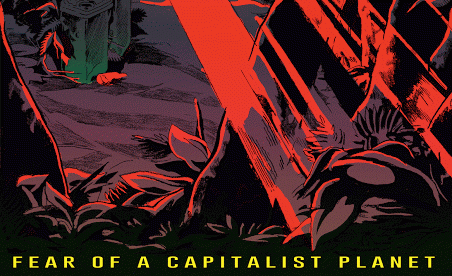
Marcos Farrajota is the editor of š! #20, the special issue of the Latvian anthology dedicated to Portuguese comics (you can read my review here), but he’s also the guy behind a lot of cool projects in Portugal, a librarian in Bedeteca de Lisboa – one of the best comics place in Europe – and a cartoonist, as you can see in his collection Talento Local. I’ve interviewed him to talk about comics in Portugal and some other stuff.
I’d like to start this interview sorting out all your various projects, from the fanzine Mesinha de Cabeceira, born in 1992, to Mmmnnnrrrg collective, which is celebrating 15 years right now, up to Chili Com Carne, perhaps the label best known outside Portugal and with a frequently updated blog. Can you tell me how you’ve evolved from project to project and how you’re giving your attention at the different labels/publications at the moment?
Well, everything is very organic, I mean, there isn’t an obligation to release every year one Mesinha de Cabeceira – like between 1997 and 2000 it took three years to release a new issue… Also, Mesinha is sometimes published by CCC, others by MNRG… A mess to librarians and collectors, I guess.
CCC has also more people involved so we can split work… And MNRG is me and Joana Pires – we are a couple, you see? So we manage at home our ideas.
All projects are “hobbies”, not professional works that put bread on the table… We relax when we have to relax and we act when we need to act!
Looking at your books and at the events you organize, the Portuguese scene seems quite lively. Yet the introduction to š! #20 emphasizes that making comics is a solitary process and describes the medium as “a form of torture, a useless effort devoid of causes or consequences that offers us neither glory nor any sort of personal reward”. It’s a similar concept to Pessoa’s “Everything we do, whether in art or in life, is a defective version of what were our initial ambitions”, as if you came at this idea of the futility of making comics during these years as an artist and as a publisher…
There’s been a darker time in the Portuguese scene but now there’s a new breed full of energy and ideas… It’s been exciting these last five years I guess, after a period of “nothing seems to be happen” from 2005 to 2010. So there are the “pros” working for USA, small publishers growing and keeping the light alive, medium publishers coming back and a growing attention on the graphic novel market. Let’s hope this helps to more experimental and cutting edge comics to develop even more… Because if not, it’s just a big black hole, creators feel hopeless since nobody will understand or care – even the people who state they like comics – those are actually the worst because they are conservative assholes that collect juvenile crap. I guess that’s why I always looked for people outside Portugal so that you may have more perspective and feedback. New generation like Amanda Baeza by instinct already knew that and her first book was published in Latvia, which is an awesome and interesting situation.
Anthologies as Mutate & Survive and Boring Europa, which connected Portuguese cartoonists with artists from all over Europe, date back to several years ago, and the last experience in this field, Futuro Primitivo, is from 2011. Recently Chili Com Carne is focusing more on books made by a single author. Is this a precise choice or only a coincidence? Do you think this is a current trend in the market, that now is harder to sell an anthology or a magazine than a so-called “graphic novel”?
Pure coincidence. It was by cosmic forces that graphic novels of David Campos, Francisco Sousa Lobo, André Coelho and Nunsky appeared… And it’s also true that to make anthologies in an interesting way (by the theme, for example) is some hard work for the editor! We still do anthologies like the QCDA series or the next volume of Zona de Desconforto (about foreign comics authors experiencing live in Portugal). New solo books will happen this year which is good just because in this way there are more different books to read and experience.
As for market, it’s obvious that solo graphic novels are THE market format to sell in the last 10 years but you can imagine that in literature world there are also anthologies and they sell less because they’re for a more restricted public like the people of the “scene”, not for a big audience. For our very small market (in Portugal) and printrun (of CCC or MNRG) actually there’s no big difference, most of our anthologies are sold out and solo books are still available – but then again, solo graphic novels are like only three years old…
Some of your latest books are different from your past publications, since they don’t have the typical underground contents or aesthetics of the past, in the sense that they aren’t provocative or “dirty”. For example Francisco Sousa Lobo’s The Dying Draughtsman is an intimate and deep story, while Askar, O General by Colombian artist Dileydi Florez is a very well-finished graphic work looking at the representation of the great historical battles of the past that we find in painting more than in comics.
We are getting old!!!
No way man… Come on, Papá em África by Anton Kannemeyer is full of black dicks, Erzsébet is full of virgin blood, Rudolfo is puking a lot in Malmö Kebab Party and if I’ll publish a new book this year there will be loads of my bad drawings (and dicks!)… You’ve just got to see some of “clean” phase of ours, or some “clean” books. Wait and see! Hahahahaha!!!
Man, authors do what they like, we don’t impose any aesthetics… Otherwise it won’t make sense unless we were some kind of commercial publishers of sex& violence or artsy-fartsy-two-colours books, whatever…
Well, it seems dicks are everywhere in your comics! However, let’s talk about your activity at the Bedeteca de Lisboa (this is an unoffical website, the old address is now closed). I know you’ve a big collection of comics and that you organize events, classes and so on…
Used to… Since 2005 it’s just going down the drain as for others activities. Now, I’m just a good librarian dude in Bedeteca. If you go to Lisbon, please come by! It has a nice garden, good sofas and chairs, 9000 volumes of zines, mags, books, albums, CDs, DVDs and related items to comics and illustration. Why waste your time visiting tourist’s traps when you can come and relax reading books in Bedeteca? Actually we have books in Portuguese, English, French, Italian, Suomi, Swedish, Polish, etc…
The golden days of publishing, making big festivals, exhibitions and all that it’s gone (I did an interview in Stripburger about that) but the library is good and interesting, come on!
Since we’re talking about Portuguese comics, I’d like to know what is popular or mainstream in Portugal today. In Italy we’ve comics as Tex or Dylan Dog, published by Sergio Bonelli Editore, that represent perfectly the concept of “popular”, I don’t know if you’ve ever seen them… Then there is a large diffusion of manga, we’ve a lot of superheroes and a lot of satirical, ironic and in general funny (or supposed to be funny…) comics. What is “popular” in Portugal?
I guess humour strips are the most popular (Calvin & Hobbes, Dilbert, Adam, Cathy…). And then this pedophilic french-belgian stuff for the 40 uppers, fascist super-heroes for the 30’s up, manga for kids… Disney returned after some years, but maybe they’re selling to nostalgic grown-ups, kids aren’t that stupid to read that crap anymore. Many Portugueses read English, French and Spanish so they buy foreigner editions since the market doesn’t supply enough good books. We’ve also Brazilian editions of Bonelli trash, don’t know who consumes that and I really don’t want to know. I wonder if we can talk about a “mainstream” (excepts humour strips, I guess) because I know that Batman trade paperbacks sold as much as Baudoin’s A Viagem. I guess moronic Saga will sell better than these examples because it’s funny and, you know, comics are supposed to be… comical! Oh, the irony…
Can we say that 3000 copies sold of a book is popular or mainstream? I don’t know…
Moving from the popular to the personal, I’d like to hear from you some names of Portuguese cartoonists you admire and you can recommend to the readers.
Old and new all mixed up, active and inactive, dead and alive, with solo books or not: André Lemos, Janus, Ana Cortesão, João Fazenda, Nunsky, Filipe Abranches, Bruno Borges, Carlos Botelho, Pedro Brito, Pedro Nora, Amanda Baeza, José Smith Vargas, Jucifer, Pedro Burgos, Tiago Manuel, Rafael Bordalo Pinheiro, Francisco Sousa Lobo…
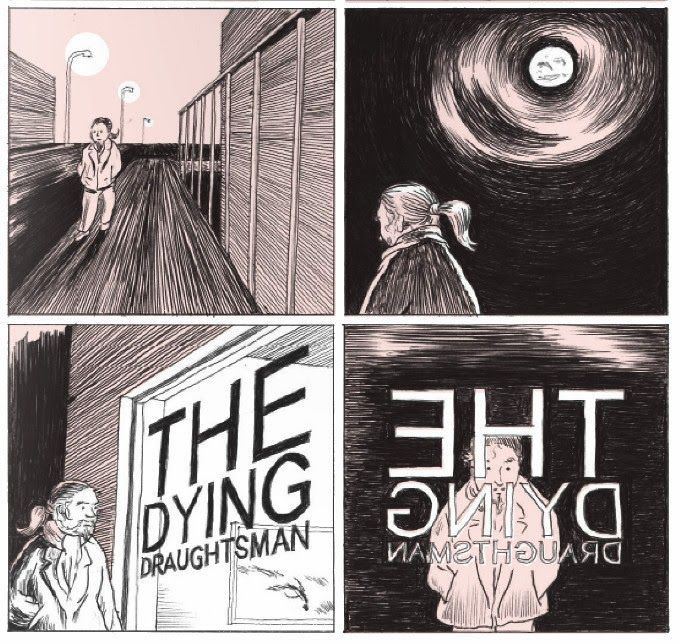 So there’s a lot to discover for foreigners like me… And on the other hand, what do you think of the European scene at the moment? I believe there is a greater and sometimes exaggerated attention to the aesthetic and formal aspects of the comics, probably thanks to the decrease of printing costs and the consequent diffusion of the color… I think this has influenced also the self-published comics, where now we’re finding a lot of conformist products, which are everything but alternative…
So there’s a lot to discover for foreigners like me… And on the other hand, what do you think of the European scene at the moment? I believe there is a greater and sometimes exaggerated attention to the aesthetic and formal aspects of the comics, probably thanks to the decrease of printing costs and the consequent diffusion of the color… I think this has influenced also the self-published comics, where now we’re finding a lot of conformist products, which are everything but alternative…
Yup, graphic novels made the comics looks like literature world: full of light literature, best-sellers and all that… You have to dig depper to find good stuff but that was always like that, no? People get nostalgic when they think they found Daniel Clowes or Joe Sacco in the 90’s and now there are all this Clowes and Sacco clones or subproducts but man, look at Canicola crew, or Glomp anthologies or some Serbian and Croatian guys and there’s still energy and originality to be as exciting as the 90’s. Or look to Olivier Schrauwen that actually can combine the “graphic novel loads of narrative pages to be respectable” with aesthetic and formal aspects at the same time. Or Ruppert & Mulot or Tommi Musturi… Or Jarno Latva-Nikkola who can be pigeonholed as “caricature” but has a full graphic novel depth…
It’s true that graphic novels are growing in the book market with “my mom was a crackwhore” or Pinochet biography, juts like best-sellers are now cook books or cats that saves the day… If all graphic novels were good (a thing that Fantagraphics or L’Association wanted back in the days) the world would be perfect, but as you know there’s still McDonald’s, war, hunger, latest Batman film, racism, Berlusconi out there…
As usual, we need critics – good ones – that can filter all this “new graphic books industry”, where are they?
If you want, I would close this interview speaking of your future projects. I read you’re setting up a lot of initiatives for the 15th anniversary of Mmmnnngggr, can you tell me something more? And what can we expect from Chili Com Carne?
15th MNRG celebrations are almost gone… We made a punk tour with two bands, released a split-tape and my new zine, Anton was in Lisbon in a conference with some public polemics and I’m DJing next week at Beja festival. After that it’s hard work making new books of Aleksandar Zograf, André Ruivo and Tiago Manuel… And something else that comes on the way!
As for Chili Com Carne we still don’t know… But we’re hoping to have new graphic novels of Francisco Sousa Lobo and José Smith Vargas, loads of other zines and books and some exhibition in Amadora Fest and University of Salamanca (Spain). But only after June we’ll have clear ideas…
“From Now On” with Malachi Ward
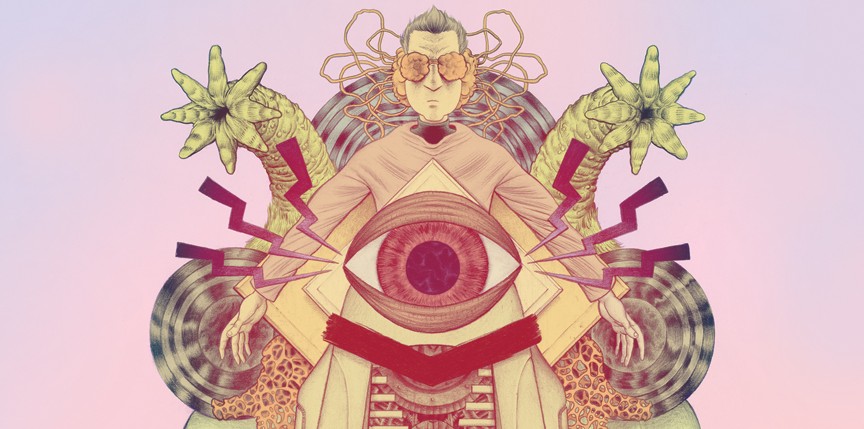
Malachi Ward is the creator of Ritual, a series published by Revival House Press, and the author of From Now On, a collection of short stories which is coming in June from Alternative Comics. He also collaborated with Matt Sheean at the series Expansion and at some issues of Brandon Graham’s Prophet. The interview that follows took place at the end of May via e-mail.
Since you talked about your formation as a comic artist and your inspirations in this interview with Dave Nuss, I’d like to begin this chat with some questions about From Now On. This is your first “book” and I think it would be nice to introduce it to the readers. I saw the summary and the very first story will be Utu, a sort of classic in your production, in fact it’s one of the first comics or exactly the first comic you printed. Do you think that self-publishing Utu in 2009 could be considered as a key moment in your career?
After college I was reading a lot more comics, and flirting with the idea of making them. Of course, “comics” can be almost anything, and I didn’t have much of an idea about what I wanted to do. My art at the time was kind of… whimsical I suppose? Anyway, throughout 2007-09 I kind of honed in on what I wanted to do. I started Utu in 2009, and traded off working on that and The Scout, for Jordan Shiveley’s Hive anthology. I finished them both in time for APE 2009. So both were a big breakthrough for me. It was the first work that I finished and was ok printing up and presenting to the world. I still kinda like those stories too.
I think Utu is a really original story, because it starts in a way and then moves in a completely different direction. And it has a lot of different registers, in the beginning it seems a sort of mythological tale, then it becomes funny and in the end it’s also sad in some way. I’d like to know if you started it with the intention to use different atmospheres and genres, or if the plot came out as a natural process.
One of the appeals to me of Utu was that bifurcation in the plot – that it feels like it’s one kind of story and then quickly becomes a totally different one. I’m not really into plot “twists”, but who doesn’t like a story surprising them, so long as it all fits? I’m drawn to that narrative device a lot… It’s something I often try to insert into a story, even if it doesn’t work! Each of the Ritual stories kind of has an element of that to varying degrees.
Before you mentioned The Scout, another story from 2009 that will be in From Now On, where you examined the concepts of time and repetition. This comic is based on a fixed grid of six panels per page and, watching your old things, you used a rigid structure several times. On the other hand, your recent work is based on a less regular layout. Do you think this could reflect your improvements as a cartoonist or it’s only a coincidence?
For The Scout, I was concerned with telling the story in as few pages as possible (since it was for an anthology with limited space) while still making it read naturally and not seem too compressed. I think keeping a regular panel layout like the one in The Scout helps with that. I did the same thing for another story in From Now On called Henix for similar reasons. I also think that the 6-panel layout just works well for a 5.5″x8″ mini-comic. While I certainly think I’ve progressed in my comics skills, I would still return to a rigid panel layout like that if it suited the comic. Even when my comics have a lot of varying panel sizes and arrangements, they usually follow regular tier breakdowns that I don’t deviate from.
Another comic in From Now On is Top Five, a sort of metanarrative sci-fi story about Star Trek, definitely an inspiration for you. Sweet Dreams and The Oviraptor are also reinterpretations of some science fiction stereotypes. I think this is what makes your comics fresh and original, that you use some ideas taken from sci-fi movies and tv series but you treat them in your own way, creating a mix that isn’t so widespread in the world of alternative comics at the moment…
Sometimes, for me, a story starts with me thinking about how I might handle a genre trope. I think the goal is to find the core of whatever that idea is, the emotional element that clicks, the thematic or atmospheric qualities that could register with the reader, and then to work out from there while avoiding all the typical pratfalls a science fiction/fantasy/horror story can fall into.
Besides the ones we talked until now, I haven’t read the other stories in From Now On. Can you introduce them or some of them to the readers?
There’s a new full color comic called Disconnect (a preview page below, editor’s note), which takes place in the same world as Top Five, The Oviraptor, and Hero of Science. It follows one of the other characters that disappeared when the team jumped back in time. Some other stories include Beasts of Kay-7, which is sort of my take on a Star Trek type of a team that is exploring a new planet inhabited by mysterious monsters. Henix, which I mentioned earlier, is a high-fantasy kind of a story about a deformed (to the eyes of the main characters) prisoner with secrets about the royal family.
Let’s talk about Ritual now, the series published by Revival House Press, where every issue is a stand-alone story of 20-30 pages. Before picking up Ritual #2 – The Reverie, I had seen your work only online and when I read that story I was shocked… It was fucking good! Then I read others of your comics and I noticed that The Reverie is probably the most “serious” and touching comic you’ve made until now. And unlike the other issues of Ritual, this one follows a very linear narrative. I’d like to know how you came to tell this story, if it moves from your fears or from some nightmare you had.
Because The Reverie centers around a family death, it certainly contains a lot more emotionally potent situations than in my other work. Something like the death of a family member is frequently used as a cheap motivation for a main character, so I tried to be careful to imbue the build up and fallout from that event with as much empathy as possible. The idea for the story came from my fascination with the range of behavior a single person is capable of, and how opportunity shapes our ability to act in a moral way. It also deals with some notions of regret – I’ve heard people talk about what they should’ve done with their lives, or how they think things should’ve gone. It’s always been a profoundly alien feeling to me, something I have trouble understanding. It’s an idea that I’ll very likely explore with more depth in the future.
In The Reverie your drawing style seems less controlled and defined than usual. This is not a bad thing to me, because I think in some sequences you did a beautiful work depicting the landscapes or the rage of the main character. I think maybe you were doing some experimentation…
The first half of that comic, I think, is still pretty controlled. Everything that takes place outside of the titular dimension is inked with a brush and pretty carefully drawn. I actually didn’t have much time while I was working on the book, and most of the second half was drawn over the course of a couple weeks. I knew that I wanted to change the style a bit inside the wish dimension, like inking with a pen instead of a brush, but because of the limited time that part of the story also took on a much looser quality.
Ritual #1 – Real Life and Ritual #3 – Vile Decay are quite similar in the structure, while for the contents Real Life is – as the title tells itself – a true life story turning out in a very frightful way and Vile Decay is about future and how people are fucking up the world. As a whole this series talks about a lot of big themes, as family, relationships, death and – in issue three – also politics and ecology. But I think all three issues of Ritual so far are mostly talking about your fears. Or this is the way I see it…
My starting point for the Ritual series is that it’s a horror anthology. Really, I only think Real Life ended up feeling anything like something one would identify as part of the horror genre, but every entry is certainly related to fear in a fundamental way. Real Life is inspired by actual nightmares: my wife hatefully abandoning me, and me turning “evil”. The Reverie kind of spins out from that, I was thinking about how easily I could succumb to being a pretty scummy person if the right situations presented themselves. Vile Decay, while ostensibly about the degradation of society, was more about my fear that I’ll completely disconnect from the world as I grow older and it becomes easier to do so.
Another way to read Ritual #1 and #3 is as pilots of a tv series, but your comics will never have a follow-up, so the reader has to imagine it or try to interpret the stories browsing through the pages…
Ritual #3 has an especially elusive narrative quality to it… it could be a very unsatisfying read for a lot of people. I think there’s enough in that one that a person can unpack if they think it’s worth it, so hopefully the comics invite the ready to do that. In the next group of comics I’m making I’m kind of reacting to that (something I tend to do for whatever reason) and creating stories that have much more definitive resolutions.
In this group of comics there is also Ritual #4?
I’ve got a pretty detailed outline that I’m really excited about. Right now it’s just about finding time in my schedule to actually draw it. Ritual #4 is tentatively titled The Left Hand Path.
So it could be about your fear of becoming left-handed…
How’d you know??? That’s my real deepest fear.
Do you think the new issue will use two colors as the previous? I loved the pinks and the oranges of Vile Decay, they contributed to create a nebulous and unreal setting.
I think Dave Nuss and I are planning for Ritual #4 to be printed in full color, but it will retain a limited palette.
I know you are working on a couple of new projects with your friend Matt Sheean, with whom you already collaborated for Expansion and for Brandon Graham’s Prophet. I know you and Matt are totally sharing the different tasks of the creative process and I’m curious how you’re doing this.
For the project we’re currently working on (Ancestor, which’ll be part of the Island anthology for Image) Matt and I break the work down like this: We both talk through the plot of each issue and come up with an outline, usually together. If the outline calls for any important chunks of dialogue, we each take a sequence and write it out. Then, over the course of a couple intense days, we do thumbnails for the whole issue. From there Matt pencils, I ink and do flat colors, and Matt adds lighting effects to the colors. I then letter the final page.
This is a very interesting way to develop a collaboration… Ancestor will be a long story?
Ancestor will end up being longer than anything I’ve done in awhile, probably about 120 pages when it’s done.
Besides Ancestor are you working on other long stories or you’ll going on with short ones?
Currently I’m thumbnailing a full color comic that’ll be around 80 pages. I’m planning to do mostly longer stories from this point forward.
I’d like to conclude talking about what is exciting you at the moment, if you’re listening to some music in particular, or if there is a comic or a novel or a movie you enjoyed a lot recently…
I just reread the Lawrence Wright book Going Clear and I’m pretty obsessed with it. I’m doing some research about Indo-European culture that’s really interesting. In the comics world I thought Jillian Tamaki’s Sex Coven story for Frontier was really inspiring and fantastic. Same goes for the newest issue of Crickets by Sammy Harkham. I haven’t seen many movies I really loved this year, but I really liked Ex Machina, and I thought Mad Max: Fury Road was a lot of fun. I’ve been listening to the 1988 album Encounter by Michael Stearns while I write, as well as a lot of Jean-Michel Jarre.

